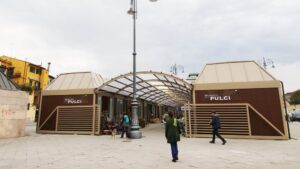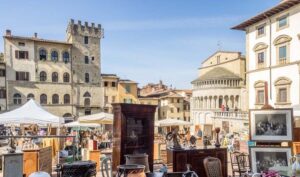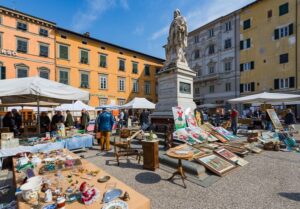Guest Article written by Sal from Nature of Sal
October is a wonderful time for expats to explore the Abruzzo, Lazio and Molise National Park (“Parco nazionale d’Abruzzo, Lazio e Molise”, also known as PNALM), located east of Rome. The park, one of three National Parks in Abruzzo, is renowned for its stunning autumn colors, diverse wildlife, and scenic trails, making it a perfect destination for a fall hiking adventure.
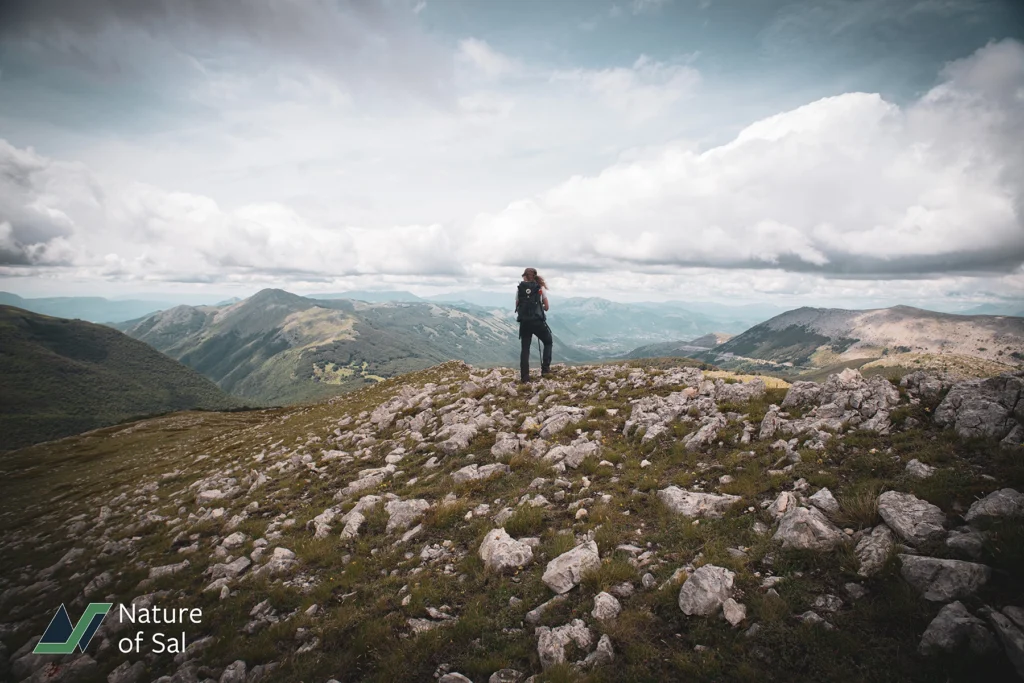
Exploring Abruzzo National Park
Abruzzo National Park is one of Italy’s oldest national parks, offering a diverse landscape of mountains, forests, and rivers. The fall season transforms the park into a colorful paradise.
Trail Highlights
– Camosciara “G5” Trail: This easy and short trail (more a walk than a hike) is perfect for families, offering beautiful views of waterfalls and the chance to see wild animals like chamois and deer.
– Val Fondillo Trail: A more challenging trail that takes you through dense forests and along clear streams, showcasing the park’s vibrant fall foliage.
Wildlife Watching
Abruzzo National Park is home to diverse wildlife, including bears, wolves, and golden eagles. Fall is an excellent time for wildlife watching, as animals prepare for winter. You can safely observe the endangered Marsican Brown Bear, along with other species, from designated shelters. For a more immersive experience, consider booking a private guide to hike safely through bear country. While encounters with these rare animals in the wild are uncommon—there are only about 50 Marsican Brown Bears left, a critically endangered subspecies of the European Brown Bear—the experience is unforgettable.
In Abruzzo, as everywhere else you go in nature, please be respectful and maintain a safe distance if you encounter animals. Avoid petting or feeding them, as this can have harmful consequences for both the animals and yourself.
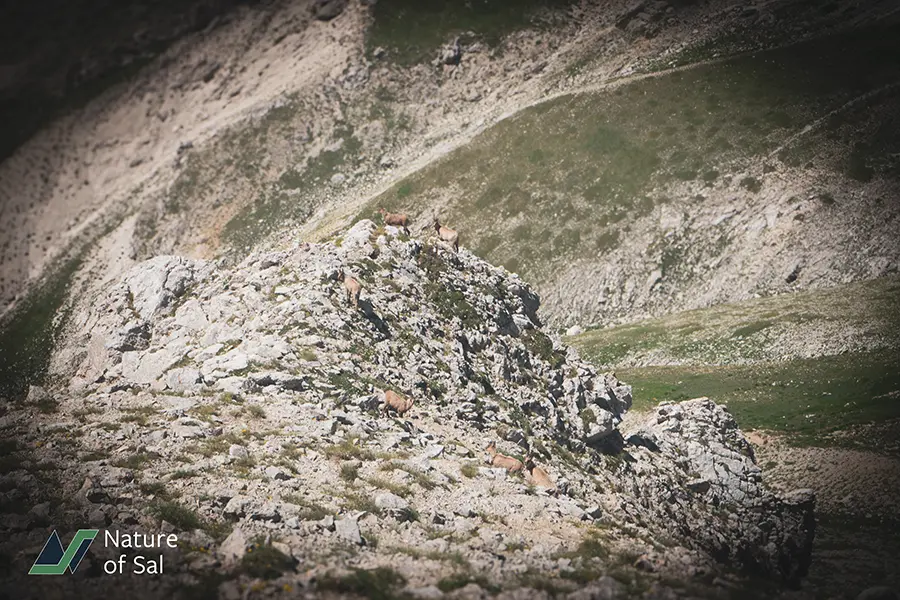
Hiking Tips for Expats
– Plan Ahead: Some areas of the park require permits, so check regulations before you go.
– Dress in Layers: The mountain weather can be unpredictable, so be prepared with warm, layered clothing.
– Bring Binoculars: For better wildlife viewing, pack a pair of binoculars to spot animals from a distance.
Local Delicacies
After your hike, explore the local towns and enjoy traditional Abruzzese cuisine. Try hearty dishes like arrosticini (grilled lamb skewers = Arrosticini) and polenta.
Hiking in Abruzzo National Park in October offers expats a chance to experience Italy’s natural beauty at its best. The vibrant fall colors, diverse trails, and abundant wildlife make it an unforgettable adventure.
Are you looking for hikes by public transport?
With an abundance of hiking options accessible by train, Rome invites you to embark on an unforgettable adventure with your loved ones. So pack your bags, hop on board the train, and let’s explore the stunning landscapes and natural wonders of Rome together!
Ready to start planning your family hiking adventure? Visit Nature of Sal’s FREE HikeLine Map for more information and inspiration. Let’s make memories that will last a lifetime!
And as always: Stay fit, hike a bit!
Sal
Read more about:
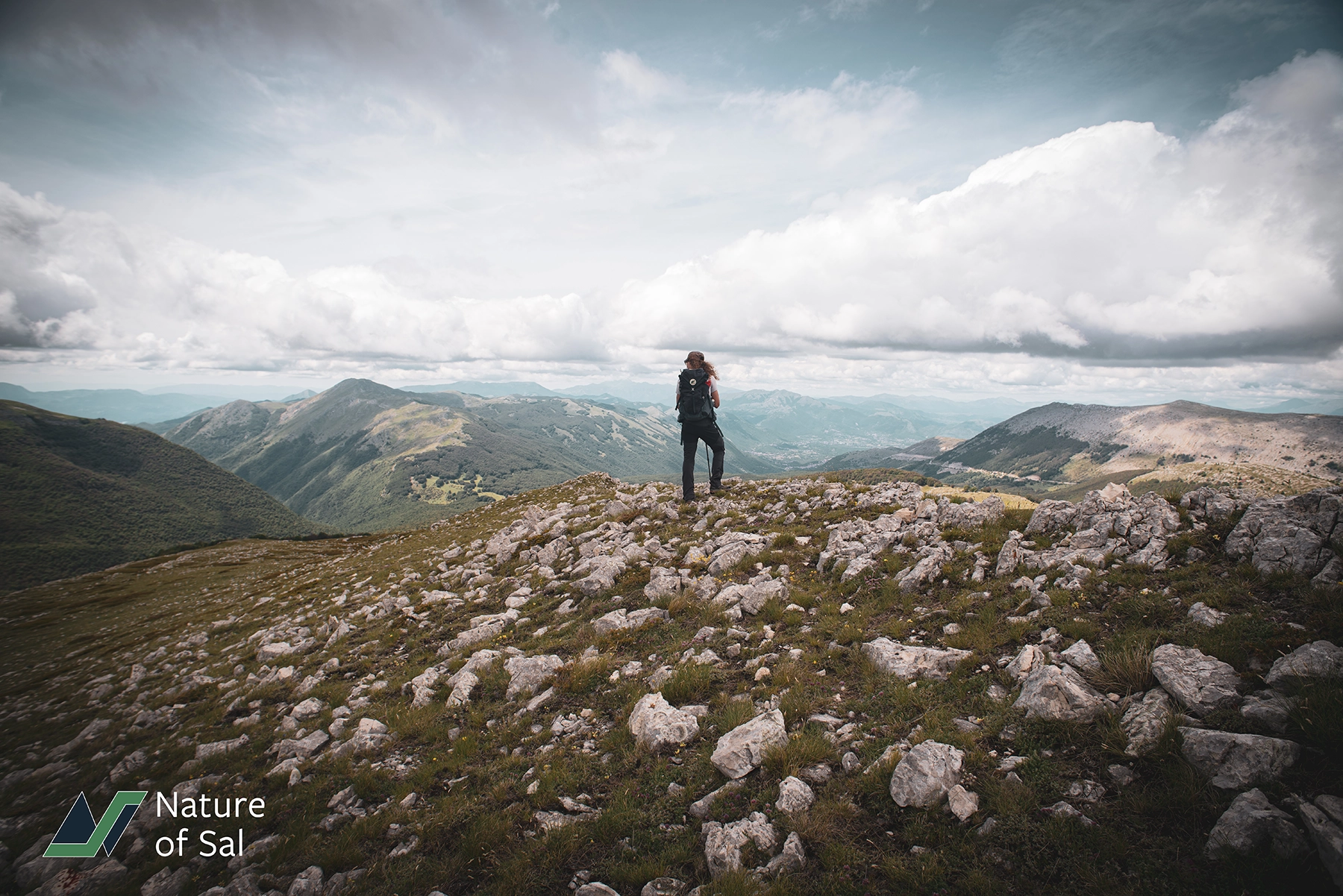
Hiking In The Abruzzo, Lazio and Molise National Park: A Fall Adventure For Expats
Guest Article written by Sal from Nature of Sal October is a wonderful time for expats to explore the Abruzzo, Lazio and Molise National Park (“Parco nazionale d’Abruzzo, Lazio e Molise”, also known as PNALM), located east of Rome. The park, one of three National Parks in Abruzzo, is renowned for its stunning autumn colors, […]
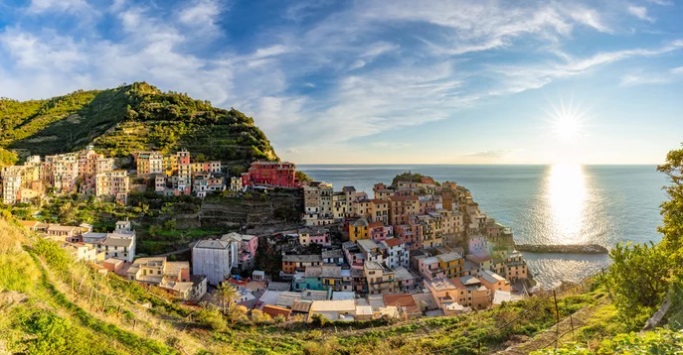
The Best Places to Visit in Italy by Train This Fall
Italy is one of Europe’s most captivating destinations all year round, but fall brings a unique charm that enhances its picturesque landscapes, historic cities, and culinary delights. With cooler temperatures, fewer tourists, and a golden hue that blankets the countryside, autumn is the perfect season to explore the country by train. Thanks to Italy’s extensive […]

Understanding Salaries in Italy: A Guide for Expats and Newcomers
If you’re an expat living in Italy or someone considering relocating, understanding the salary landscape is key to planning your life in the country. This article provides an overview of average salaries in Italy in 2024, how they vary by profession, age, gender, education, and region, as well as how they compare to other European […]
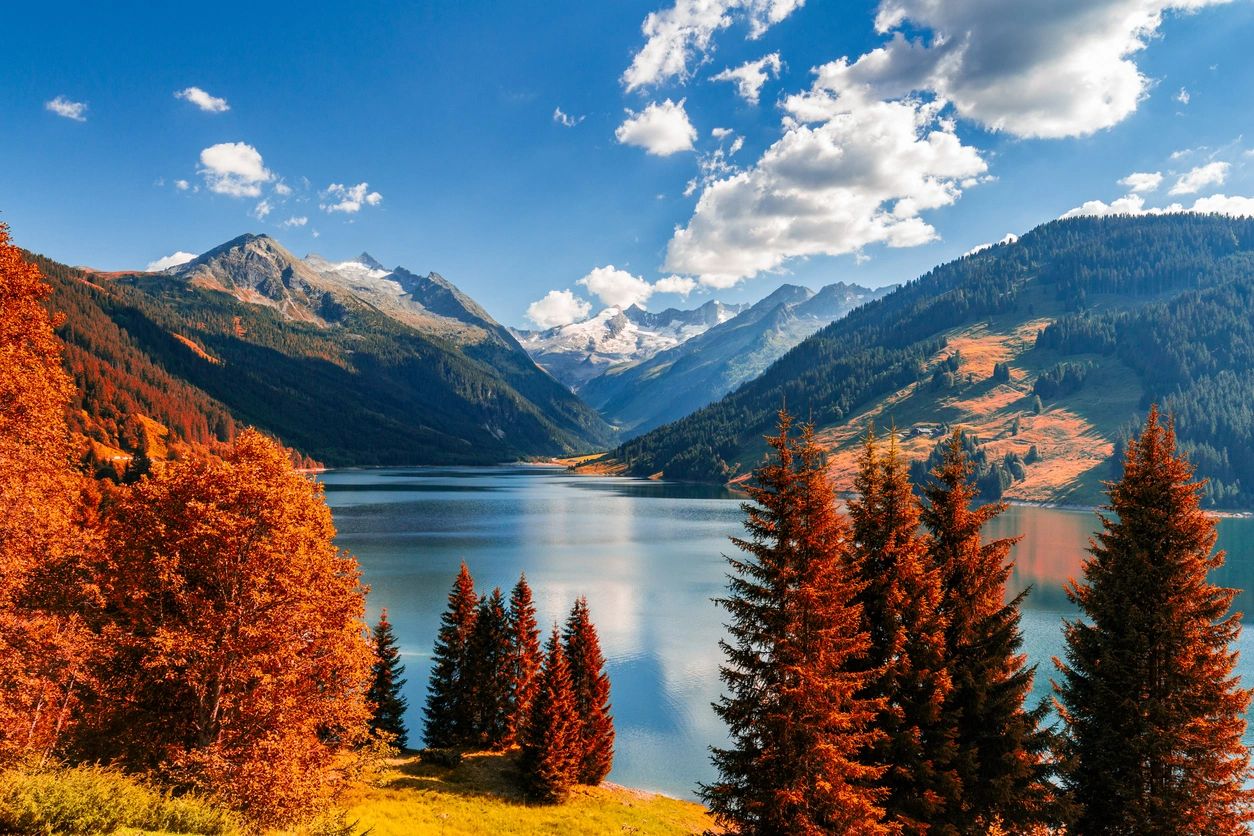
Preparing For Cooler Weather: Fall Hiking Tips For Expats
Guest Article written by Sal from Nature of Sal As summer fades into fall, the cooler weather provides a refreshing change for hikers in Rome. For expats, it’s important to adjust your hiking gear and preparation to enjoy the trails comfortably and safely. Dressing for Fall Hikes – Layering: Start with a moisture-wicking base layer, […]
Learn about the residence permit for digital nomads from non-EU countries working in Italy
Italy’s Investor Visa: A Visa to Attract Strategic Investments from Abroad
Find and Buy Your Ideal Property in Italy with Our Professional Services
Buying Property in Italy – How to Get a Mortgage as a Foreigner
How to Open a Bank Account in Italy as an Expat
Learn Italian and open up new possibilities for your career and personal growth
Prepare for the CILS B1 Citizenship exam to obtain citizenship by marriage, residence or study or work in Italy.
Switching to a self-employment permit from a study or job-seeking one
FAQs for Italian Citizenship by Marriage (2023)
Understanding the Tessera Sanitaria: Your Italian Health Insurance Card
Non-Married Partners: How to Obtain a Residence Permit in Italy as De Facto Cohabitants
How to get tax identification number for foreign citizens (Codice Fiscale)
How to register in Italy as an EU citizen
Mastering Public Transport in Italy
The Advantages of Dual Citizenship with an Italian Passport: Unlocking Boundless Opportunities
What you need to know about Visas and Permits to stay in Italy
Red flags to identify a scam when renting in Italy
Italy is one of Europe’s most captivating destinations all year round, but fall brings a unique charm that enhances its picturesque landscapes, historic cities, and culinary delights. With cooler temperatures, fewer tourists, and a golden hue that blankets the countryside, autumn is the perfect season to explore the country by train. Thanks to Italy’s extensive and efficient rail network, travelers can enjoy a hassle-free, scenic experience. Below are some of the ideal places to visit in Italy during fall, all easily accessible by train.
1. Florence:

Vineyards in the Chianti Classico region.
Florence is a top-tier destination year-round, but fall offers a quieter and more intimate experience. The city’s artistic treasures, such as Michelangelo’s David and Botticelli’s The Birth of Venus, can be explored without the heavy summer crowds. Autumn also coincides with the grape harvest season, making it the perfect time to visit Tuscany’s nearby vineyards, many of which offer wine tours and tastings. The rich foliage covering the hills around Florence provides the perfect backdrop for a stroll through the city’s historic streets.
Train Access: Florence is a major rail hub, connected by high-speed trains (Frecciarossa, Italo) from major cities like Rome, Milan, and Venice.
2. Lake Como:
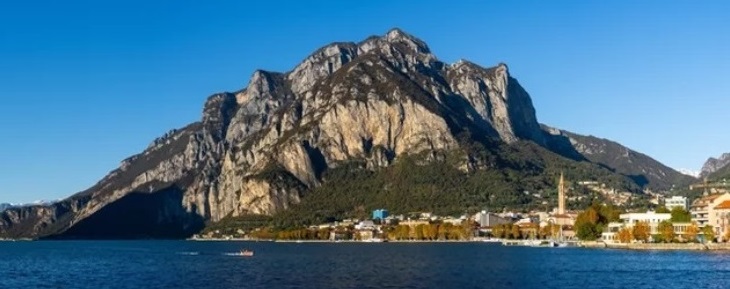
View of Lecco on the shores of Lake Como.
Lake Como is a stunning year-round destination, but fall transforms the area into a quiet, romantic retreat. The trees lining the lake burst into vibrant reds, yellows, and oranges, creating a picture-perfect reflection on the water. Travelers can explore the charming towns of Bellagio, Varenna, and Como, take scenic boat rides, or hike in the surrounding hills. The mild autumn climate is ideal for wandering through the lake’s historic villas and manicured gardens.
Train Access: You can reach Lake Como by regional trains from Milan, which take about an hour to arrive at Como San Giovanni station. From there, boats and buses connect you to various lakeside towns.
3. Cinque Terre:
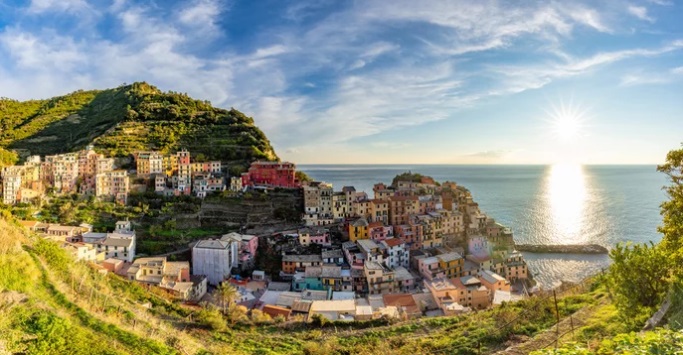
Fall Sunset in Manarola.
The Cinque Terre is renowned for its colorful cliffside villages and stunning coastal views. While the summer months bring crowds to this UNESCO World Heritage site, fall offers a peaceful alternative. The cooler temperatures make it the perfect time to hike between the five villages or enjoy the local Ligurian cuisine without the throngs of tourists. The autumn sunsets over the Mediterranean are spectacular, and the vineyards dotting the hills are also in harvest season.
Train Access: Cinque Terre’s villages are connected by regional trains from La Spezia. High-speed trains from cities like Florence and Milan can bring you to La Spezia, where you can then hop on a short ride to any of the five towns.
4. Verona
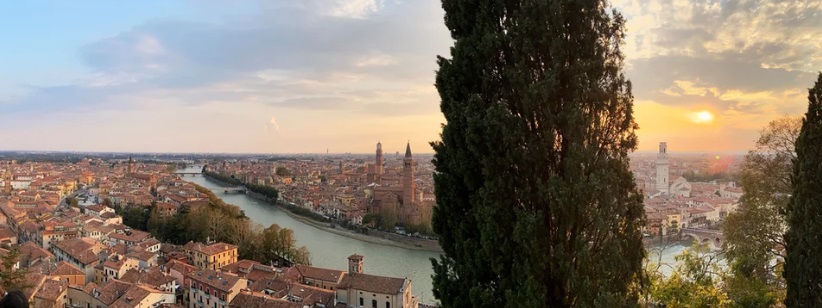
Verona, the city of Romeo and Juliet, becomes even more enchanting in the fall. The golden foliage adds a romantic flair to the city’s ancient streets, and landmarks such as the Arena di Verona and Juliet’s Balcony are less crowded. It’s also the season of food festivals in Verona, celebrating local specialties like mushrooms, truffles, and wine. Visitors can enjoy these delicacies in cozy, centuries-old trattorias.
Train Access: High-speed trains connect Verona to major cities like Milan, Venice, and Rome, making it easy to include the city in any Italian itinerary.
5. Bologna:
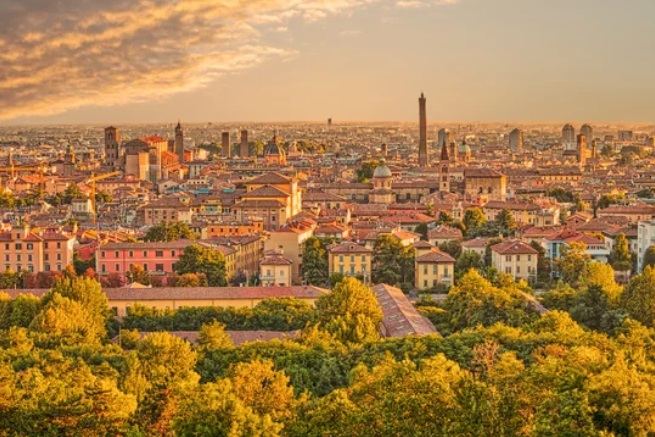
Bologna, known as the culinary capital of Italy, is a must-visit in the fall. This is the perfect time to indulge in seasonal Italian dishes like pumpkin tortellini, chestnuts, and truffles. In addition to its gastronomy, Bologna’s medieval architecture, including the famous Two Towers and its 38 kilometers of porticoes, looks particularly beautiful against the warm autumn colors. The University of Bologna, the oldest in Europe, also hosts a vibrant student population that keeps the city lively year-round.
Train Access: Bologna is a major hub on Italy’s high-speed rail network, easily accessible from Milan, Florence, and Rome.
6. Venice
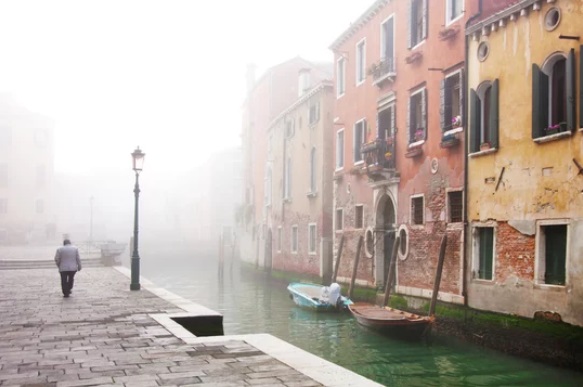
Morning Venice in the Fog.
Venice takes on a mystical aura in the fall, with its canals often cloaked in mist during the morning hours. The crowds of summer have dispersed, allowing you to wander the quiet streets and piazzas without the usual congestion. The city’s autumnal light makes for perfect photography, and you can enjoy Venice’s art and architecture in peace. It’s also a great time to explore the nearby islands of Murano and Burano.
Train Access: High-speed trains connect Venice to cities such as Milan, Florence, and Rome. Venice Santa Lucia Station is located directly in the city, making it convenient to access the historic center.
7. Turin

Turin, often overlooked by travelers, is a gem during the fall season. The city’s baroque architecture, grand boulevards, and royal palaces look especially charming against the backdrop of autumn leaves. Turin is also a hub for food lovers, offering everything from truffles and chocolate to the famous Piedmont wines. Additionally, fall marks the truffle season, and nearby Alba hosts the world-famous Alba White Truffle Fair.
Train Access: High-speed trains from Milan, Florence, and Rome make Turin a convenient destination for a fall getaway.
8. Perugia and Assisi
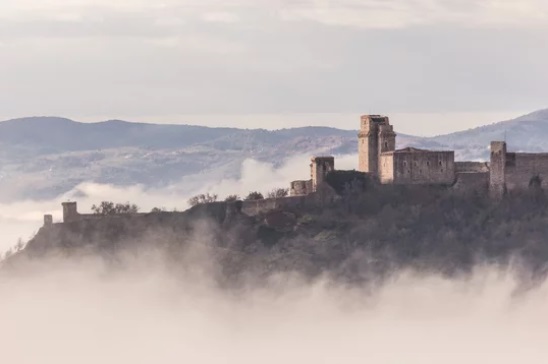
Rocca Maggiore castle in Assisi.
The central region of Umbria is an underrated gem in Italy, often called “Tuscany without the crowds.” In the fall, the region’s rolling hills and medieval towns, like Perugia and Assisi, are blanketed in vibrant colors. Perugia hosts the famous Eurochocolate Festival in October, attracting chocolate lovers from around the world. Meanwhile, Assisi offers a peaceful retreat with its stunning churches, such as the Basilica of St. Francis, framed by the rich hues of autumn.
Train Access: Perugia and Assisi are accessible by regional trains from Florence and Rome, making it a perfect day trip or weekend getaway.
Italy in the fall is a true gem, with fewer tourists, cooler weather, and the beauty of nature in full autumnal bloom. Whether you’re drawn to the cultural landmarks of Florence and Venice, the stunning fall foliage of Lake Como, or the quiet coastal charm of Cinque Terre, each destination offers something unique.
Learn about the residence permit for digital nomads from non-EU countries working in Italy
Italy’s Investor Visa: A Visa to Attract Strategic Investments from Abroad
Find and Buy Your Ideal Property in Italy with Our Professional Services
Buying Property in Italy – How to Get a Mortgage as a Foreigner
How to Open a Bank Account in Italy as an Expat
Learn Italian and open up new possibilities for your career and personal growth
Prepare for the CILS B1 Citizenship exam to obtain citizenship by marriage, residence or study or work in Italy.
Switching to a self-employment permit from a study or job-seeking one
Understanding the Tessera Sanitaria: Your Italian Health Insurance Card
Non-Married Partners: How to Obtain a Residence Permit in Italy as De Facto Cohabitants
How to get tax identification number for foreign citizens (Codice Fiscale)
How to register in Italy as an EU citizen
Mastering Public Transport in Italy
The Advantages of Dual Citizenship with an Italian Passport: Unlocking Boundless Opportunities
What you need to know about Visas and Permits to stay in Italy
Red flags to identify a scam when renting in Italy

Hiking In The Abruzzo, Lazio and Molise National Park: A Fall Adventure For Expats
Guest Article written by Sal from Nature of Sal October is a wonderful time for expats to explore the Abruzzo, Lazio and Molise National Park (“Parco nazionale d’Abruzzo, Lazio e Molise”, also known as PNALM), located east of Rome. The park, one of three National Parks in Abruzzo, is renowned for its stunning autumn colors, […]

The Best Places to Visit in Italy by Train This Fall
Italy is one of Europe’s most captivating destinations all year round, but fall brings a unique charm that enhances its picturesque landscapes, historic cities, and culinary delights. With cooler temperatures, fewer tourists, and a golden hue that blankets the countryside, autumn is the perfect season to explore the country by train. Thanks to Italy’s extensive […]

Understanding Salaries in Italy: A Guide for Expats and Newcomers
If you’re an expat living in Italy or someone considering relocating, understanding the salary landscape is key to planning your life in the country. This article provides an overview of average salaries in Italy in 2024, how they vary by profession, age, gender, education, and region, as well as how they compare to other European […]

Preparing For Cooler Weather: Fall Hiking Tips For Expats
Guest Article written by Sal from Nature of Sal As summer fades into fall, the cooler weather provides a refreshing change for hikers in Rome. For expats, it’s important to adjust your hiking gear and preparation to enjoy the trails comfortably and safely. Dressing for Fall Hikes – Layering: Start with a moisture-wicking base layer, […]
If you’re an expat living in Italy or someone considering relocating, understanding the salary landscape is key to planning your life in the country. This article provides an overview of average salaries in Italy in 2024, how they vary by profession, age, gender, education, and region, as well as how they compare to other European nations.
Average Salary in Italy
The average gross annual salary (RAL) in Italy for private sector employees is around €30,284, according to data from the JobPricing Observatory. Salaries can differ greatly depending on your role:
- Executives: €103,418
- Managers: €55,632
- Office Employees: €32,174
- Manual Workers: €25,522
Net salaries (after taxes and deductions) vary depending on the number of monthly payments (13 or 14) in a year. For example, a manager may take home €2,668 on a 13-month payment plan, while an executive earns €4,473. Office employees and manual workers typically earn around €1,818 and €1,524 net respectively.
Public vs. Private Sector Pay
Public sector workers in Italy earn slightly more than their private sector counterparts, with an average gross annual salary of €37,073.
Top-Paying Professions and Industries
Highly skilled sectors lead the way in terms of salary:
- Banking and Financial Services: Average salary €46,354
- Engineering: Average salary €40,372
- Pharmaceuticals and Biotech: Average salary €39,209
On the other end, lower-paying sectors include personal services, hotels, and restaurants, where specialized skills are less in demand.
Salary by Age
Salaries in Italy increase with age, though the rate of growth slows over time. Here’s a breakdown by age group:
- 15-24 years: €24,588
- 25-34 years: €27,028
- 35-44 years: €29,831
- 45-54 years: €31,926
- 55-64 years: €34,057
Regional Salary Differences
There’s a notable 14% gap between salaries in Northern and Southern Italy. The highest salaries are found in Lombardy (€33,452), Lazio (€32,360), and Liguria (€32,156). Meanwhile, regions like Basilicata, Calabria, and Puglia offer the lowest average salaries, ranging from €26,055 to €27,261 annually.
At the provincial level, Milan, Trieste, Rome, and Bologna top the list for the highest salaries, while Matera, Crotone, and Ragusa are at the bottom.
Comparing Italy with Europe
In comparison to other EU countries, Italy’s average salary is slightly below the European average. The average gross annual salary in Italy is around €34,736, while the OECD average stands at €45,217. In comparison to neighboring European countries, Italy falls behind nations like Luxembourg, Denmark, and Ireland, where salaries exceed €50,000 per year.
Salary Growth and Real Wages
While nominal wages have seen slight increases over recent years, real wages (adjusted for inflation) are expected to start recovering only from 2024, with a projected growth of 1.3%.
Education and Salary
The more educated you are, the higher your potential salary in Italy. A degree, particularly in fields like Economics, Engineering, Medicine, and Pharmacy, significantly increases earning potential. On average, university graduates earn around 2.5 times more than those with only a middle school education.
Gender Pay Gap
Italy still faces challenges with the gender pay gap, especially in the private sector where the gap stands at 16.5%. In the public sector, however, the gap is one of the lowest in Europe at 4.1%. Men earn an average of €31,286 annually, compared to €28,565 for women.
Factors Influencing Salaries
Several factors influence salary levels in Italy:
- Location: Northern cities like Milan and Rome offer higher wages.
- Industry: Highly specialized industries such as finance and pharmaceuticals pay the most.
- Education: Higher education translates to higher earnings.
- Experience: Salaries grow steadily with years of experience.
Hourly Wages and Cost of Living
The average hourly wage in Italy is €11.69. However, the cost of living, especially in cities like Milan and Rome, can be steep. In contrast, smaller southern towns offer lower living expenses but also lower wages.
In Summary
Salaries in Italy vary significantly depending on multiple factors such as location, profession, and experience. If you’re planning to relocate to Italy, it’s important to research the local salary ranges, the cost of living, and the industries with the best prospects to make an informed decision about your financial future.
Source: Forbes.
Learn about the residence permit for digital nomads from non-EU countries working in Italy
Italy’s Investor Visa: A Visa to Attract Strategic Investments from Abroad
Find and Buy Your Ideal Property in Italy with Our Professional Services
Buying Property in Italy – How to Get a Mortgage as a Foreigner
How to Open a Bank Account in Italy as an Expat
Learn Italian and open up new possibilities for your career and personal growth
Prepare for the CILS B1 Citizenship exam to obtain citizenship by marriage, residence or study or work in Italy.
Switching to a self-employment permit from a study or job-seeking one
Understanding the Tessera Sanitaria: Your Italian Health Insurance Card
Non-Married Partners: How to Obtain a Residence Permit in Italy as De Facto Cohabitants
How to get tax identification number for foreign citizens (Codice Fiscale)
How to register in Italy as an EU citizen
Mastering Public Transport in Italy
The Advantages of Dual Citizenship with an Italian Passport: Unlocking Boundless Opportunities
What you need to know about Visas and Permits to stay in Italy
Red flags to identify a scam when renting in Italy

Hiking In The Abruzzo, Lazio and Molise National Park: A Fall Adventure For Expats
Guest Article written by Sal from Nature of Sal October is a wonderful time for expats to explore the Abruzzo, Lazio and Molise National Park (“Parco nazionale d’Abruzzo, Lazio e Molise”, also known as PNALM), located east of Rome. The park, one of three National Parks in Abruzzo, is renowned for its stunning autumn colors, […]

The Best Places to Visit in Italy by Train This Fall
Italy is one of Europe’s most captivating destinations all year round, but fall brings a unique charm that enhances its picturesque landscapes, historic cities, and culinary delights. With cooler temperatures, fewer tourists, and a golden hue that blankets the countryside, autumn is the perfect season to explore the country by train. Thanks to Italy’s extensive […]

Understanding Salaries in Italy: A Guide for Expats and Newcomers
If you’re an expat living in Italy or someone considering relocating, understanding the salary landscape is key to planning your life in the country. This article provides an overview of average salaries in Italy in 2024, how they vary by profession, age, gender, education, and region, as well as how they compare to other European […]

Preparing For Cooler Weather: Fall Hiking Tips For Expats
Guest Article written by Sal from Nature of Sal As summer fades into fall, the cooler weather provides a refreshing change for hikers in Rome. For expats, it’s important to adjust your hiking gear and preparation to enjoy the trails comfortably and safely. Dressing for Fall Hikes – Layering: Start with a moisture-wicking base layer, […]
Guest Article written by Sal from Nature of Sal
As summer fades into fall, the cooler weather provides a refreshing change for hikers in Rome. For expats, it’s important to adjust your hiking gear and preparation to enjoy the trails comfortably and safely.
Dressing for Fall Hikes
– Layering: Start with a moisture-wicking base layer, add an insulating layer, and top it off with a waterproof, wind-resistant outer layer.
– Warm Accessories: Bring a hat, gloves, and a neck gaiter to protect against the chill, especially in the mornings and evenings.
Gear Essentials
– Waterproof Boots: Fall can bring wet conditions, so waterproof hiking boots are essential to keep your feet dry and comfortable.
– Rain Gear: A lightweight, packable rain jacket and rain pants can protect you from unexpected showers.
– Headlamp: As days get shorter, a headlamp is useful for early morning or late afternoon hikes.
Trail Safety Tips
– Check Weather Conditions: Fall weather can be unpredictable, so always check the forecast before heading out.
– Trail Conditions: Be aware of potential wet and slippery trails. Trekking poles can provide extra stability.
– Stay Hydrated and Fueled: Even in cooler weather, staying hydrated is important. Bring high-energy snacks to keep your energy levels up.
Best Fall Hiking Destinations
– Monte Livata and the Simbruini Mountains: Monte Livata and the surrounding Simbruini Mountains offer a range of trails through dense forests, which turn stunning shades of red, orange, and yellow in the fall. The area is known for its serene atmosphere, diverse wildlife, and panoramic views. You can explore trails that lead to high-altitude meadows or down into peaceful valleys.
Perfect for: Nature lovers who enjoy forested trails and mountain scenery.
– Cerveteri and the Necropolis of Banditaccia: This UNESCO World Heritage site is not just a place of great archaeological interest but also a beautiful spot for hiking. The ancient Etruscan tombs are surrounded by rolling hills and oak forests that are particularly enchanting in the autumn. The contrast between the ancient structures and the fall colors creates a unique and memorable experience.
Perfect for: History buffs and those looking for a mix of culture and nature.
– Lake Bracciano: The area around Lake Bracciano offers a variety of trails that range from easy lakeside walks to more challenging hikes in the surrounding hills. The autumn colors reflect beautifully on the lake’s surface, and the medieval towns of Bracciano and Anguillara Sabazia add a cultural element to your hike.
Perfect for: Those who enjoy lakeside scenery and exploring charming towns.
– Monte Soratte: Monte Soratte is a striking mountain that rises sharply from the surrounding plains. The trails up to the summit offer incredible views of the Tiber Valley and the Apennines. In autumn, the paths are less crowded, and the crisp air and fall colors make the hike even more enjoyable. The Hermitage of Saint Sylvester is an interesting historical site you can visit along the way.
Perfect for: Hikers who enjoy panoramic views and a bit of a climb.
– Castelli Romani: The Castelli Romani area is rich in history, culture, and natural beauty. In autumn, the forests around the towns of Nemi, Ariccia, and Castel Gandolfo come alive with color. The area offers a variety of trails, including paths around the volcanic lakes of Albano and Nemi. You can also enjoy local wines and foods in the charming villages.
Perfect for: Those looking for a combination of hiking, food, and culture.
– Aniene Valley and Tivoli: The Aniene Valley, leading to the historic town of Tivoli, is a wonderful area for autumn hikes. You can explore trails that follow the Aniene River, visit the beautiful Villa Gregoriana with its waterfalls, or hike up to Monte Catillo for a broader view of the valley. The fall colors enhance the beauty of the natural and historical sites in this area.
Perfect for: Hikers interested in combining natural beauty with historical exploration.
Where can I find hikes by public transport?
With an abundance of hiking options accessible by train, Rome invites you to embark on an unforgettable adventure with your loved ones. So pack your bags, hop on board the train, and let’s explore the stunning landscapes and natural wonders of Rome together!
Ready to start planning your family hiking adventure? Visit Nature of Sal’s FREE HikeLine Map for more information and inspiration. Let’s make memories that will last a lifetime!
And as always: Stay fit, hike a bit!
Sal
Read more about:

Hiking In The Abruzzo, Lazio and Molise National Park: A Fall Adventure For Expats
Guest Article written by Sal from Nature of Sal October is a wonderful time for expats to explore the Abruzzo, Lazio and Molise National Park (“Parco nazionale d’Abruzzo, Lazio e Molise”, also known as PNALM), located east of Rome. The park, one of three National Parks in Abruzzo, is renowned for its stunning autumn colors, […]

The Best Places to Visit in Italy by Train This Fall
Italy is one of Europe’s most captivating destinations all year round, but fall brings a unique charm that enhances its picturesque landscapes, historic cities, and culinary delights. With cooler temperatures, fewer tourists, and a golden hue that blankets the countryside, autumn is the perfect season to explore the country by train. Thanks to Italy’s extensive […]

Understanding Salaries in Italy: A Guide for Expats and Newcomers
If you’re an expat living in Italy or someone considering relocating, understanding the salary landscape is key to planning your life in the country. This article provides an overview of average salaries in Italy in 2024, how they vary by profession, age, gender, education, and region, as well as how they compare to other European […]

Preparing For Cooler Weather: Fall Hiking Tips For Expats
Guest Article written by Sal from Nature of Sal As summer fades into fall, the cooler weather provides a refreshing change for hikers in Rome. For expats, it’s important to adjust your hiking gear and preparation to enjoy the trails comfortably and safely. Dressing for Fall Hikes – Layering: Start with a moisture-wicking base layer, […]
Learn about the residence permit for digital nomads from non-EU countries working in Italy
Italy’s Investor Visa: A Visa to Attract Strategic Investments from Abroad
Find and Buy Your Ideal Property in Italy with Our Professional Services
Buying Property in Italy – How to Get a Mortgage as a Foreigner
How to Open a Bank Account in Italy as an Expat
Learn Italian and open up new possibilities for your career and personal growth
Prepare for the CILS B1 Citizenship exam to obtain citizenship by marriage, residence or study or work in Italy.
Switching to a self-employment permit from a study or job-seeking one
FAQs for Italian Citizenship by Marriage (2023)
Understanding the Tessera Sanitaria: Your Italian Health Insurance Card
Non-Married Partners: How to Obtain a Residence Permit in Italy as De Facto Cohabitants
How to get tax identification number for foreign citizens (Codice Fiscale)
How to register in Italy as an EU citizen
Mastering Public Transport in Italy
The Advantages of Dual Citizenship with an Italian Passport: Unlocking Boundless Opportunities
What you need to know about Visas and Permits to stay in Italy
Red flags to identify a scam when renting in Italy
Return your voted ballot now!
Remember, U.S. embassies and consulates are not polling places. Same-day, in-person voting is not available outside the United States. Many states require voted ballots to reach local election officials by the time polls close on election day (November 5). U.S. citizens who want to participate in the 2024 U.S. elections from overseas should have already returned their absentee ballots to their local election officials.
Never received your ballot?
If you registered to vote and requested an absentee ballot prior to your state’s registration deadline, but have not yet received your ballot, you can complete and return a Federal Write-in Absentee Ballot (FWAB) and return it to your local election office. The FWAB is available at www.FVAP.gov. If your regular ballot arrives later, complete and return it as well. Your FWAB will only be counted if your regular ballot does not reach local election officials by your state’s deadline. Your vote will not be counted twice.
RETURNING YOUR BALLOT:
If you plan to drop your ballot off at the embassy or consulate to be returned to your local election office, we recommend you do so no later than October 4. Please ensure your ballot is addressed to your local election officials and is either placed in a postage-paid envelope or bears sufficient domestic U.S. postage. Ballots can be dropped off, from 9:00 a.m. to 4:30 p.m. Monday through Friday (excluding these holidays).
Missed the U.S. embassy or consulate shipment deadline?
If your state allows, you may be able to return your voted ballot to your local election office electronically. You can also consider returning your ballot via an express courier service at your own expense. Ballots sent via express courier do not receive standard postmarks, so voters using this method should confirm delivery on or before November 5 prior to payment and shipment. Check your state’s voting procedures at www.FVAP.gov for guidance.
If you have previously registered to vote and requested an absentee ballot but it has not yet arrived, some states allow voters to email or fax their voted, signed FWAB to local election officials. Review your state’s voting procedures at www.FVAP.gov carefully for guidance.
Returning your ballot by international mail.
If using Italy’s postal system, be sure to include sufficient international postage and allow enough time for delivery. Ballots sent via regular international mail at this time are unlikely to reach local election officials by state ballot receipt deadlines.
HELP SPREAD THE WORD ABOUT OVERSEAS VOTING.
Please help spread the word to your friends, family, and colleagues that now is the time return your ballot if you are voting from overseas.
Need help?
You can get in-person voting assistance from the embassy/consulate, and ballots can be dropped off, from 9:00 a.m. to 4:30 p.m. Monday through Friday (excluding these holidays).
Have Questions?
Please contact Italy’s Voting Assistance Officer at +39 06 46741 or at [email protected]. You can also contact the Federal Voting Assistance Program (FVAP) directly at [email protected].
Confirm your registration and ballot delivery online. Learn more at the FVAP website at www.FVAP.gov.
If you have any questions about registering to vote overseas or how to return your election materials, please contact your nearest embassy or consulate:
- U.S. Embassy Rome, Italy
Via Vittorio Veneto, 121
+39 06-46741
- U.S. Consulate General Milan, Italy
Via Principe Amadeo, 2/10
+39 02-290-351
- U.S. Consulate General Florence, Italy
Lungarno Vespucci, 38
+39 055-266-951
- U.S. Consulate General Naples, Italy
Piazza della Repubblica
+39 081-583-8111
888-407-4747 or 202-501-4444
- Italy Country Information
- Enroll in Smart Traveler Enrollment Program (STEP) to receive Alerts and Messages from the U.S. Mission to Italy.
The General Election on November 5 is just around the corner!
Please review the important guidance below to ensure you register, request your ballot, and cast your vote on time.
Please review the important guidance below to ensure you register, request your ballot, and cast your vote on time.
Register and request your ballot by your state’s deadline. You can use FVAP’s easy online assistant at www.FVAP.gov/FPCA to walk you through each section of the form. After you finish filling out the FPCA, print it, sign it, and send it to your election office. Most states accept the FPCA by email or fax while some require it by mail. Check your state-specific guidelines at FVAP.gov.
Once you receive your requested absentee ballot, vote and return it as soon as you get it. Remember to carefully follow the instructions, especially if a “security envelope” is required, and sign the package as indicated when returning it.
To save time, send voted ballots electronically if allowed by state law. Voters can check if their state accepts completed absentee ballots by email, fax, or via an online portal at FVAP.gov/guide.
If a requested ballot has not arrived, use the Federal Write-in Absentee Ballot (FWAB) immediately at www.FVAP.gov/FWAB. It acts as a backup ballot. If your official state absentee ballot arrives after sending in the FWAB, complete and send in the official ballot, too. Only one will be counted.
To ensure your voted ballot is received by your state, go to FVAP.gov, click on your state and then the “check the status of your voted ballot” button.
To find your state’s election website for specific information on candidates, elections, contact information, and links to your local election offices, visit the FVAP.gov contact page. You can also reach out directly to your election office for status updates on your registration and absentee ballot.
Additional Information for non-UOCAVA voters: Uniformed service members, their families, and Department of Defense civilians who are currently stationed in the same location as their voting address may visit vote.gov to register to vote and request information from their local election office to vote locally.

For more information, please visit FVAP.gov or contact your local voting POC at: [email protected]; [email protected]; [email protected]; or [email protected].
Learn about the residence permit for digital nomads from non-EU countries working in Italy
Italy’s Investor Visa: A Visa to Attract Strategic Investments from Abroad
Find and Buy Your Ideal Property in Italy with Our Professional Services
Buying Property in Italy – How to Get a Mortgage as a Foreigner
How to Open a Bank Account in Italy as an Expat
Learn Italian and open up new possibilities for your career and personal growth
Prepare for the CILS B1 Citizenship exam to obtain citizenship by marriage, residence or study or work in Italy.
Switching to a self-employment permit from a study or job-seeking one
Understanding the Tessera Sanitaria: Your Italian Health Insurance Card
Non-Married Partners: How to Obtain a Residence Permit in Italy as De Facto Cohabitants
How to get tax identification number for foreign citizens (Codice Fiscale)
How to register in Italy as an EU citizen
Mastering Public Transport in Italy
The Advantages of Dual Citizenship with an Italian Passport: Unlocking Boundless Opportunities
What you need to know about Visas and Permits to stay in Italy
Red flags to identify a scam when renting in Italy

Hiking In The Abruzzo, Lazio and Molise National Park: A Fall Adventure For Expats
Guest Article written by Sal from Nature of Sal October is a wonderful time for expats to explore the Abruzzo, Lazio and Molise National Park (“Parco nazionale d’Abruzzo, Lazio e Molise”, also known as PNALM), located east of Rome. The park, one of three National Parks in Abruzzo, is renowned for its stunning autumn colors, […]

The Best Places to Visit in Italy by Train This Fall
Italy is one of Europe’s most captivating destinations all year round, but fall brings a unique charm that enhances its picturesque landscapes, historic cities, and culinary delights. With cooler temperatures, fewer tourists, and a golden hue that blankets the countryside, autumn is the perfect season to explore the country by train. Thanks to Italy’s extensive […]

Understanding Salaries in Italy: A Guide for Expats and Newcomers
If you’re an expat living in Italy or someone considering relocating, understanding the salary landscape is key to planning your life in the country. This article provides an overview of average salaries in Italy in 2024, how they vary by profession, age, gender, education, and region, as well as how they compare to other European […]

Preparing For Cooler Weather: Fall Hiking Tips For Expats
Guest Article written by Sal from Nature of Sal As summer fades into fall, the cooler weather provides a refreshing change for hikers in Rome. For expats, it’s important to adjust your hiking gear and preparation to enjoy the trails comfortably and safely. Dressing for Fall Hikes – Layering: Start with a moisture-wicking base layer, […]
For those looking to buy a home in the country, the diversity of regions and cities offers a variety of options to suit different lifestyles, from bustling urban centers to peaceful countryside escapes. Whether you’re drawn by Italy’s art, food, or slower pace of life, the following cities stand out as top destinations for expats looking to invest in real estate.
1. Milan: Italy’s Financial and Fashion Capital

As the country’s economic powerhouse and global fashion hub, Milan is ideal for expats seeking a dynamic urban lifestyle. It’s Italy’s most modern city, with an impressive infrastructure, multinational corporations, and a buzzing cultural scene. The real estate market in Milan is competitive, with demand driving property values higher than the national average. Expats can expect a blend of modern apartments, historic buildings, and luxury real estate.
■ Why buy here? Milan’s economy remains robust, offering plenty of job opportunities for expats in sectors like finance, fashion, technology, and design. The city’s efficient transportation network and proximity to other European capitals also make it a convenient base for international professionals. While property prices can be high, especially in central areas like Brera and Porta Nuova, neighborhoods like Navigli and Isola offer more affordable options with a lively atmosphere.
2. Rome: The Eternal City

Rome combines centuries of history with modern Italian life, offering an irresistible mix of cultural attractions and a bustling metropolis. As Italy’s capital, it’s a popular destination for expats working in government, diplomacy, or international organizations. Buying property in Rome means investing in one of the world’s most famous cities, where ancient ruins stand next to contemporary developments.
■ Why buy here? Rome’s property market is diverse, ranging from luxurious apartments in the city center to more affordable homes in suburban areas. Expats can enjoy a cosmopolitan lifestyle while living amidst iconic landmarks like the Colosseum and Vatican. Prices in the historic center and affluent neighborhoods like Parioli are higher, but districts such as Trastevere and San Giovanni offer charming properties at a lower cost, perfect for expats seeking a blend of modern and traditional living.
3. Florence: The Cradle of the Renaissance

Florence, the birthplace of the Renaissance, is a city that exudes art, culture, and history at every corner. Its compact size makes it easy to navigate, and it offers a slower pace of life compared to Milan or Rome. Florence’s real estate market is particularly attractive to expats looking for historical homes, be it apartments in centuries-old buildings or villas in the surrounding Tuscan countryside.
■ Why buy here? Florence is ideal for art lovers and those who value cultural immersion. It offers excellent educational institutions and a high standard of living, making it popular with expats seeking both personal and professional enrichment. While real estate in the historic center can be pricey, suburbs like Scandicci and smaller towns around Florence provide more affordable housing options with easy access to the city.
4. Bologna: Italy’s Culinary Heart

Often referred to as “La Dotta” (the learned one) for its prestigious university, “La Grassa” (the fat one) for its food, and “La Rossa” (the red one) for its left-leaning politics, Bologna is a vibrant and intellectual city with a high quality of life. It’s less touristy than cities like Florence or Venice, which adds to its appeal for expats who want to experience a more authentic Italian lifestyle.
■ Why buy here? Bologna’s central location in Italy makes it an excellent base for those who want to explore other regions. It’s a hub of innovation, education, and culture, drawing expats working in academia, engineering, and gastronomy. The real estate market is affordable compared to larger cities, with a mix of modern apartments and historic buildings. Popular neighborhoods for expats include Santo Stefano, which offers charm and history, and Saragozza, known for its family-friendly vibe and green spaces.
5. Turin: A City of Industry and Innovation

Turin, located in the Piedmont region, is an industrial city with a rich historical background and a forward-thinking economy. Once the heart of Italy’s automotive industry, Turin has transformed into a hub for technology, innovation, and culture. The city is home to various international businesses and is growing in popularity among expats due to its affordability and vibrant cultural scene.
■ Why buy here? Turin offers great value for money compared to cities like Milan and Rome. Expats can find affordable real estate in its elegant boulevards and charming neighborhoods. The city offers a high standard of living, with plenty of green spaces, excellent schools, and proximity to the Alps for outdoor enthusiasts. Areas like Crocetta and San Salvario are popular with young professionals and families, providing a mix of history, culture, and modern amenities.
6. Trieste: Italy’s Hidden Gem

Tucked away in the northeast corner of Italy, near the Slovenian border, Trieste is a lesser-known city with a cosmopolitan atmosphere and a stunning waterfront. Historically a part of the Austro-Hungarian Empire, the city offers a blend of Italian, Slavic, and Germanic influences. Its unique culture, combined with a slower pace of life and lower cost of living, has made Trieste an attractive option for expats looking for an off-the-beaten-path destination.
■ Why buy here? Trieste is known for its literary heritage, beautiful seafront, and café culture. Property prices are significantly lower than in cities like Milan or Rome, making it an affordable option for expats who want to enjoy coastal living. Neighborhoods like Barcola and Città Vecchia offer a range of housing options, from modern apartments to historic homes. The city’s proximity to Central and Eastern Europe also makes it a strategic location for those working in international business.
7. Naples: Italy’s Vibrant Southern Capital
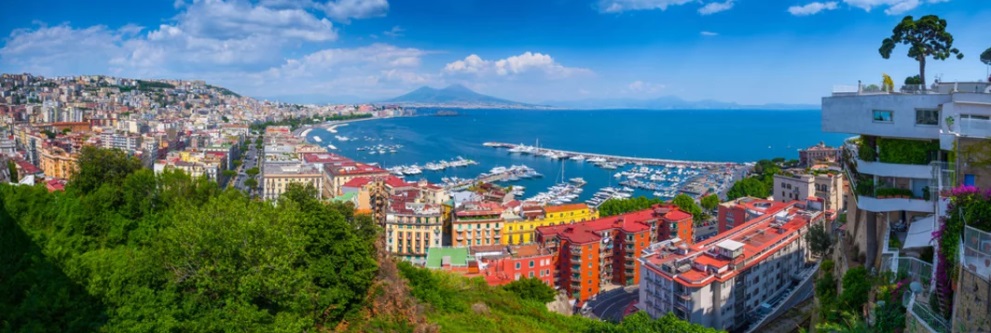
Naples is one of Italy’s most vibrant and chaotic cities, known for its rich history, passionate culture, and world-famous cuisine. It offers expats a truly authentic Italian experience, with a more affordable cost of living than northern cities. Naples’ real estate market is diverse, offering opportunities for buyers to invest in anything from coastal homes with views of the Bay of Naples to historical apartments in the city center.
■ Why buy here? Naples is a great option for expats who want to live in a lively, culturally rich environment. Property prices are relatively low compared to cities like Rome and Milan, making it an appealing option for expats on a budget. Popular areas for buying include Chiaia, a chic waterfront district, and Vomero, a hilltop neighborhood with stunning views of the city and the sea.
Italy’s diverse cities offer expats a range of options, each with its unique appeal and real estate opportunities. Whether you’re drawn to the fast-paced lifestyle of Milan, the historic allure of Florence, or the affordable charm of Trieste, Italy has something to offer everyone. Understanding the local real estate market, lifestyle, and property values in each city is essential to making a smart investment decision. With careful research and the right approach, expats can find their perfect home in one of Italy’s beautiful cities.
We can guide you through the entire process of finding and purchasing your ideal property in Italy. Send an email to [email protected] and schedule a FREE call to discuss how we can help you.
Read More:
Find and Buy Your Ideal Property in Italy
Buying Property – Mortgage Guidelines for Foreigners
The Best Cities to Retire in Italy
Learn about the residence permit for digital nomads from non-EU countries working in Italy
Italy’s Investor Visa: A Visa to Attract Strategic Investments from Abroad
Find and Buy Your Ideal Property in Italy with Our Professional Services
Buying Property in Italy – How to Get a Mortgage as a Foreigner
How to Open a Bank Account in Italy as an Expat
Learn Italian and open up new possibilities for your career and personal growth
Prepare for the CILS B1 Citizenship exam to obtain citizenship by marriage, residence or study or work in Italy.
Switching to a self-employment permit from a study or job-seeking one
Understanding the Tessera Sanitaria: Your Italian Health Insurance Card
Non-Married Partners: How to Obtain a Residence Permit in Italy as De Facto Cohabitants
How to get tax identification number for foreign citizens (Codice Fiscale)
How to register in Italy as an EU citizen
Mastering Public Transport in Italy
The Advantages of Dual Citizenship with an Italian Passport: Unlocking Boundless Opportunities
What you need to know about Visas and Permits to stay in Italy
Red flags to identify a scam when renting in Italy

Hiking In The Abruzzo, Lazio and Molise National Park: A Fall Adventure For Expats
Guest Article written by Sal from Nature of Sal October is a wonderful time for expats to explore the Abruzzo, Lazio and Molise National Park (“Parco nazionale d’Abruzzo, Lazio e Molise”, also known as PNALM), located east of Rome. The park, one of three National Parks in Abruzzo, is renowned for its stunning autumn colors, […]

The Best Places to Visit in Italy by Train This Fall
Italy is one of Europe’s most captivating destinations all year round, but fall brings a unique charm that enhances its picturesque landscapes, historic cities, and culinary delights. With cooler temperatures, fewer tourists, and a golden hue that blankets the countryside, autumn is the perfect season to explore the country by train. Thanks to Italy’s extensive […]

Understanding Salaries in Italy: A Guide for Expats and Newcomers
If you’re an expat living in Italy or someone considering relocating, understanding the salary landscape is key to planning your life in the country. This article provides an overview of average salaries in Italy in 2024, how they vary by profession, age, gender, education, and region, as well as how they compare to other European […]

Preparing For Cooler Weather: Fall Hiking Tips For Expats
Guest Article written by Sal from Nature of Sal As summer fades into fall, the cooler weather provides a refreshing change for hikers in Rome. For expats, it’s important to adjust your hiking gear and preparation to enjoy the trails comfortably and safely. Dressing for Fall Hikes – Layering: Start with a moisture-wicking base layer, […]
The Electronic Identity Card (Carta d’Identità Elettronica, CIE) is the modern electronic version of the traditional paper identity card in Italy. Here’s a step-by-step guide on how to obtain or renew your CIE.
1. Where and When to Apply
You can apply for the CIE at your local Comune (municipality) of residence or domicile. If you have a paper identity card, you can request the CIE even before it expires. Specifically, the CIE can be requested up to 180 days before your current identity card’s expiration date or in cases of loss, theft, or deterioration of your existing card.
In the case of booking the appointment in the Municipality through prenotazionicie.interno.gov.it, the citizen will have the possibility to provide in advance the passport photo in digital format by uploading it on the website.
2. Validity of the CIE
The validity of the CIE depends on your age at the time of issuance:
∙ For minors under 3 years old: The CIE is valid for 3 years.
∙ For minors between 3 and 18 years old: The CIE is valid for 5 years.
∙ For adults: The CIE is valid for a maximum of 10 years, expiring on the first birthday after 9 years from the date of issuance.
If you are temporarily unable to provide fingerprints (due to injury or other reasons), the CIE will be valid for only 12 months.
3. Required Documents and Information
When applying for the CIE, you must bring the following:
∙ A passport-style photo. This should be in paper format unless you’ve uploaded a digital photo through the Agenda CIE system when booking your appointment. The photo must meet specific size and quality requirements, ensuring that it shows your face clearly and without any alterations.
Photo Requirements
The photo you provide must adhere to strict guidelines:
Size: 35 mm wide and 45 mm high. The photo should capture your entire face with both earlobes visible, without any rotations.
Quality: The image must be sharp, with no shadows on the face or background. The background should be uniform and ideally in light colors like white, light gray, or beige.
Expression: You should have a neutral expression, with your mouth closed and eyes open, looking directly at the camera.
Digital Submission: If submitting digitally, the image should be at least 400 dpi, in .jpg format, and under 500 KB in size.
∙ Your tax code (codice fiscale) or health card, especially if this is your first time applying for a CIE, to speed up the registration process.
∙ The old identity card if you are renewing or replacing a deteriorated document.
If you are a parent of minors and applying without the other parent present, you must also provide a signed consent form from the other parent or legal guardian, or a judge’s authorization for travel abroad.
4. Fingerprint Acquisition
For citizens aged 12 and older, fingerprinting is mandatory. The process involves placing your index fingers (and if necessary, other fingers) on a sensor to capture the prints. The process is repeated several times to ensure accuracy, with the correct finger and pressure applied.
5. Application Process
At the time of your appointment:
∙ If this is your first CIE, present another valid identity document. If you don’t have one, you must bring two witnesses to confirm your identity.
∙ If renewing, submit your old identity card to the municipal officer.
∙ Provide the municipal officer with your tax code or your appointment number and proof of payment, if already made.
∙ Verify your personal information with the municipal officer.
∙ Indicate your preferred method of receiving the CIE: delivered to your address or collected at the Comune. You can also designate someone else to pick it up for you.
∙ Provide your photograph if not already submitted digitally.
∙ Fingerprint acquisition will be done at this stage.
∙ You may opt to give your consent for organ donation.
∙ Finally, review and sign the summary form with your details.
6. Costs and Payment
The cost for issuing the CIE is €16.79, plus any additional administrative fees that may apply. Be sure to keep the receipt issued by the Comune during your application.
7. Receiving Your CIE
Your new CIE will be delivered within 6 working days after your application. You’ll be notified via the contact information you provided during the application process.
By following these steps, you can smoothly obtain or renew your Carta d’Identità Elettronica in Italy, ensuring you have a valid and modern identity document.
Learn about the residence permit for digital nomads from non-EU countries working in Italy
Italy’s Investor Visa: A Visa to Attract Strategic Investments from Abroad
Find and Buy Your Ideal Property in Italy with Our Professional Services
Buying Property in Italy – How to Get a Mortgage as a Foreigner
How to Open a Bank Account in Italy as an Expat
Learn Italian and open up new possibilities for your career and personal growth
Prepare for the CILS B1 Citizenship exam to obtain citizenship by marriage, residence or study or work in Italy.
Switching to a self-employment permit from a study or job-seeking one
Understanding the Tessera Sanitaria: Your Italian Health Insurance Card
Non-Married Partners: How to Obtain a Residence Permit in Italy as De Facto Cohabitants
How to get tax identification number for foreign citizens (Codice Fiscale)
How to register in Italy as an EU citizen
Mastering Public Transport in Italy
The Advantages of Dual Citizenship with an Italian Passport: Unlocking Boundless Opportunities
What you need to know about Visas and Permits to stay in Italy
Red flags to identify a scam when renting in Italy

Hiking In The Abruzzo, Lazio and Molise National Park: A Fall Adventure For Expats
Guest Article written by Sal from Nature of Sal October is a wonderful time for expats to explore the Abruzzo, Lazio and Molise National Park (“Parco nazionale d’Abruzzo, Lazio e Molise”, also known as PNALM), located east of Rome. The park, one of three National Parks in Abruzzo, is renowned for its stunning autumn colors, […]

The Best Places to Visit in Italy by Train This Fall
Italy is one of Europe’s most captivating destinations all year round, but fall brings a unique charm that enhances its picturesque landscapes, historic cities, and culinary delights. With cooler temperatures, fewer tourists, and a golden hue that blankets the countryside, autumn is the perfect season to explore the country by train. Thanks to Italy’s extensive […]

Understanding Salaries in Italy: A Guide for Expats and Newcomers
If you’re an expat living in Italy or someone considering relocating, understanding the salary landscape is key to planning your life in the country. This article provides an overview of average salaries in Italy in 2024, how they vary by profession, age, gender, education, and region, as well as how they compare to other European […]

Preparing For Cooler Weather: Fall Hiking Tips For Expats
Guest Article written by Sal from Nature of Sal As summer fades into fall, the cooler weather provides a refreshing change for hikers in Rome. For expats, it’s important to adjust your hiking gear and preparation to enjoy the trails comfortably and safely. Dressing for Fall Hikes – Layering: Start with a moisture-wicking base layer, […]
Guest Article written by Sal from Nature of Sal
As the weather begins to (slowly) cool in September, the Castelli Romani region (which is, really, a dormant volcano) becomes a prime destination for autumn hiking. This picturesque area, located just southeast of Rome, offers beautiful trails, with a mix of forests, easy trails, uphill challenges, food stops along the way, nice views, and plenty of possible detours exploring hidden caves, Roman constructions and much more, making it a perfect escape for expats.
Exploring the Castelli Romani
The Castelli Romani is renowned for its charming hilltop towns, volcanic lakes, and lush forests. The area’s trails offer a mix of scenic beauty and historical landmarks.
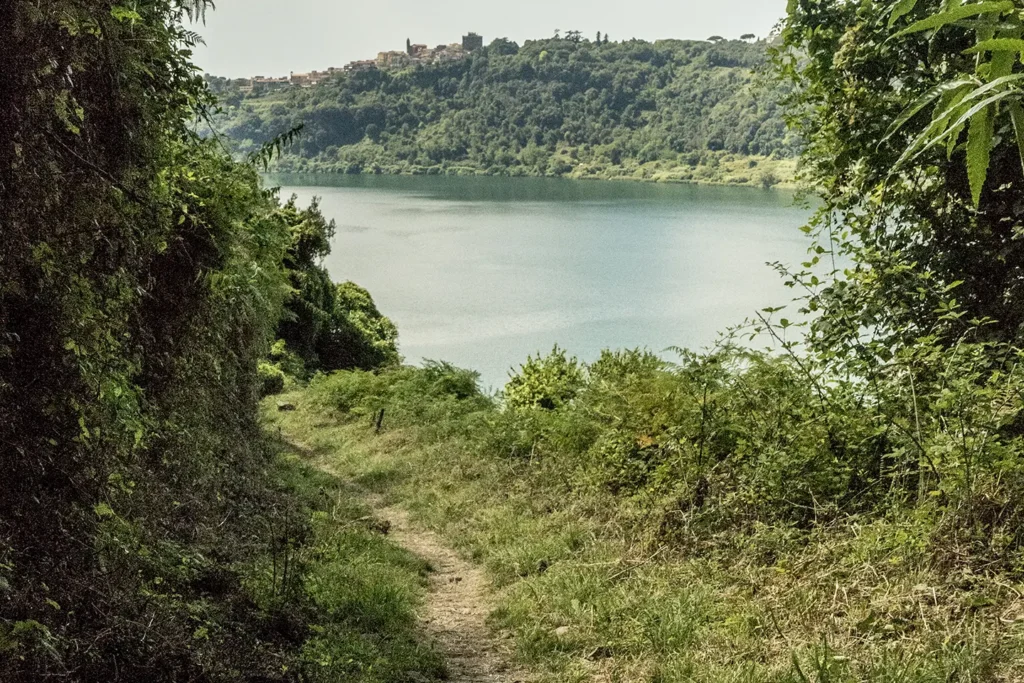
Trail Highlights
– Lake Nemi Hike: A scenic trail around the volcanic Lake Nemi, offering stunning views and the chance to visit the quaint town of Nemi. This trail is great if you enjoy a longer walk with panoramic views and surprises along the way, in combination with some food stops.
– Monte Cavo: Hike up Monte Cavo for panoramic views of the Alban Hills and the surrounding countryside. This trail is great if you like a bit of an uphill challenge.
– Frascati: Enjoy a hike up Monte Tusculum, and enjoy some nice food and local wine after your hike in one of the classical “fraschette”. This is a great trail if you want to combine a hike with some archeology, and nice food and drinks after your walk.
All three trails are easily accessible by train from Rome. Please note that during August to mid-September, train services may be disrupted due to maintenance work, but regular schedules typically resume by mid-September. It’s always advisable to check the latest information on the Trenitalia website (trenitalia.com) before planning your trip.
Hiking Tips
– Dress in Layers: September can bring varying temperatures, so wear layers that you can easily add or remove.
– Footwear: Choose sturdy, waterproof hiking boots to handle any wet or muddy conditions, and for added support.
– Safety: Make sure to check the official map on the Official Park Website and to tell someone where you go and when they should expect you back. There are some areas where you have no cell phone coverage.
– Try the local foods: The Castelli Romani is famous for its wine and food. If you get the chance, try some of the local delicacies, including the white wines, porchetta, cheeses and more!
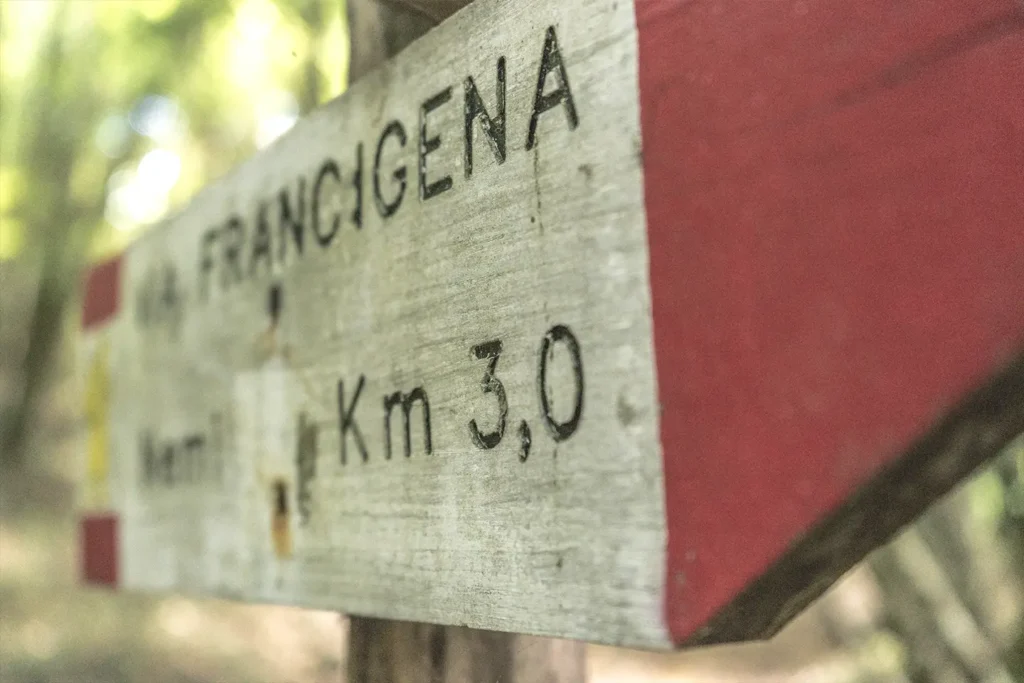
Historical Sites
Along the trails, hikers can explore ancient Roman ruins, medieval castles, and historical churches, adding a cultural dimension to their outdoor adventure.
Autumn in the Castelli Romani offers expats a perfect blend of natural beauty and historical intrigue. The cooler temperatures and vibrant fall colors make it an ideal time to explore this charming region.
Where can I find hikes by public transport?
With an abundance of hiking options accessible by train, Rome invites you to embark on an unforgettable adventure with your loved ones. So pack your bags, hop on board the train, and let’s explore the stunning landscapes and natural wonders of Rome together!
Ready to start planning your family hiking adventure? Visit Nature of Sal’s FREE HikeLine Map for more information and inspiration. Let’s make memories that will last a lifetime!
And as always: Stay fit, hike a bit!
Sal
Read more about:

Hiking In The Abruzzo, Lazio and Molise National Park: A Fall Adventure For Expats
Guest Article written by Sal from Nature of Sal October is a wonderful time for expats to explore the Abruzzo, Lazio and Molise National Park (“Parco nazionale d’Abruzzo, Lazio e Molise”, also known as PNALM), located east of Rome. The park, one of three National Parks in Abruzzo, is renowned for its stunning autumn colors, […]

The Best Places to Visit in Italy by Train This Fall
Italy is one of Europe’s most captivating destinations all year round, but fall brings a unique charm that enhances its picturesque landscapes, historic cities, and culinary delights. With cooler temperatures, fewer tourists, and a golden hue that blankets the countryside, autumn is the perfect season to explore the country by train. Thanks to Italy’s extensive […]

Understanding Salaries in Italy: A Guide for Expats and Newcomers
If you’re an expat living in Italy or someone considering relocating, understanding the salary landscape is key to planning your life in the country. This article provides an overview of average salaries in Italy in 2024, how they vary by profession, age, gender, education, and region, as well as how they compare to other European […]

Preparing For Cooler Weather: Fall Hiking Tips For Expats
Guest Article written by Sal from Nature of Sal As summer fades into fall, the cooler weather provides a refreshing change for hikers in Rome. For expats, it’s important to adjust your hiking gear and preparation to enjoy the trails comfortably and safely. Dressing for Fall Hikes – Layering: Start with a moisture-wicking base layer, […]
Learn about the residence permit for digital nomads from non-EU countries working in Italy
Italy’s Investor Visa: A Visa to Attract Strategic Investments from Abroad
Find and Buy Your Ideal Property in Italy with Our Professional Services
Buying Property in Italy – How to Get a Mortgage as a Foreigner
How to Open a Bank Account in Italy as an Expat
Learn Italian and open up new possibilities for your career and personal growth
Prepare for the CILS B1 Citizenship exam to obtain citizenship by marriage, residence or study or work in Italy.
Switching to a self-employment permit from a study or job-seeking one
FAQs for Italian Citizenship by Marriage (2023)
Understanding the Tessera Sanitaria: Your Italian Health Insurance Card
Non-Married Partners: How to Obtain a Residence Permit in Italy as De Facto Cohabitants
How to get tax identification number for foreign citizens (Codice Fiscale)
How to register in Italy as an EU citizen
Mastering Public Transport in Italy
The Advantages of Dual Citizenship with an Italian Passport: Unlocking Boundless Opportunities
What you need to know about Visas and Permits to stay in Italy
Red flags to identify a scam when renting in Italy
If you’re considering relocating to Italy, there are several pathways to obtaining residency, depending on your circumstances and goals. Below is a step-by-step guide to help you navigate the process.
Step 1: Determine Your Pathway to Residency
The first step in moving to Italy is identifying the most suitable visa or permit for your situation. Here are some common options:
∙ Student Visa: If you plan to study in Italy, this is a straightforward option. A student visa allows you to stay in Italy for the duration of your studies. Contact us if you wish to obtain a student visa through Italian language courses.
∙ Investment Visa: For those with financial resources, the investment visa provides a pathway to residency through significant economic investment in Italy. Find detailed information on Italy’s Investor Visa.
∙ Elective Residency Visa: Ideal for retirees or those with independent income, this visa allows you to reside in Italy without the need to work. Explore the elective residency visa (ERV) here.
∙ Switching from Student Permit to Self-Employed Permit: If you’re already in Italy on a student visa, you can transition to a self-employed permit. Discover the steps to make this switch.
∙ Digital Nomad Visa: Italy has introduced a residence permit for non-EU digital nomads, allowing highly skilled remote workers to live and work in Italy. Click here to learn more.
∙ Jure Sanguinis (Citizenship by Descent): If you have Italian ancestry, you may be eligible for citizenship through jure sanguinis, one of the most direct paths to becoming an Italian citizen. Learn about the process here.
∙ Residency for Unmarried Partners: If your partner is an EU citizen, you may qualify for residency, allowing you to live and work in Italy. Get the details on this process here.
∙ Work Visa: A work visa allows a non-EU citizen to legally reside and work in Italy. General requirements include a valid job offer from an Italian employer and a work permit obtained by the employer. Specific requirements and procedures can vary based on your nationality and the type of work visa you’re applying for.
Step 2: Gather the Necessary Documentation
Once you’ve chosen your pathway, the next step is to gather the required documentation. While the specific documents vary depending on the visa or permit, here’s a general list of what you might need:
∙ Valid Passport: Ensure your passport is up to date and has at least six months of validity.
∙ Visa Application Form: Complete the relevant application form for your visa type.
∙ Proof of Financial Means: Provide documentation proving you can support yourself financially in Italy.
∙ Health Insurance: Show proof of comprehensive health insurance coverage.
∙ Accommodation Details: Provide documentation showing where you will reside in Italy (e.g., lease agreement, property ownership).
∙ Criminal Background Check: Submit a police clearance certificate from your home country.
∙ Additional Documents: Depending on your visa type, you may need to provide specific documents such as enrollment confirmation for a student visa, proof of investment for an investment visa, or language proficiency certificates.
Step 3: Submit Your Visa Application
With your documents in hand, submit your visa application to the Italian consulate or embassy in your home country. Make sure to:
∙ Schedule an appointment well in advance.
∙ Pay the applicable visa fee.
∙ Attend the appointment with all required documents.
∙ Check the specific requirements and processing times for your visa type to avoid any delays.
Step 4: Relocate to Italy
Once your visa is approved, it’s time to make the move. Book your travel, secure accommodation, and plan the logistics of moving your belongings. If you have pets, ensure they meet the requirements to enter Italy.
Step 5: Apply for a Permesso di Soggiorno
Upon arrival in Italy, you’ll need to follow these procedures:
∙ Obtain a Codice Fiscale: This is your Italian tax code, necessary for various administrative tasks. Find out how to obtain your codice fiscale and where to get it depending on your type of residency permit.
∙ Register with the Comune: This involves registering your residence with the local city hall (Comune).
∙ Apply for a Permesso di Soggiorno: You must apply for a Permesso di Soggiorno (residence permit) within eight days of arriving in Italy. This permit is essential for legally staying in Italy long-term. The application process varies depending on your visa type and reason for staying.
Note: The specific requirements and timelines for Step 5 may vary depending on your individual circumstances. It’s advisable to consult with local immigration authorities or a legal professional for the most accurate and up-to-date information.
Step 6: Enjoy Your New Life in Italy!
With all the formalities completed, you can now immerse yourself in the Italian lifestyle. Whether you’re here to study, work, or retire, Italy offers a wealth of opportunities to enjoy la dolce vita. Read our blog about how to make friends in Italy.
Learn about the residence permit for digital nomads from non-EU countries working in Italy
Italy’s Investor Visa: A Visa to Attract Strategic Investments from Abroad
Find and Buy Your Ideal Property in Italy with Our Professional Services
Buying Property in Italy – How to Get a Mortgage as a Foreigner
How to Open a Bank Account in Italy as an Expat
Learn Italian and open up new possibilities for your career and personal growth
Prepare for the CILS B1 Citizenship exam to obtain citizenship by marriage, residence or study or work in Italy.
Switching to a self-employment permit from a study or job-seeking one
Understanding the Tessera Sanitaria: Your Italian Health Insurance Card
Non-Married Partners: How to Obtain a Residence Permit in Italy as De Facto Cohabitants
How to get tax identification number for foreign citizens (Codice Fiscale)
How to register in Italy as an EU citizen
Mastering Public Transport in Italy
The Advantages of Dual Citizenship with an Italian Passport: Unlocking Boundless Opportunities
What you need to know about Visas and Permits to stay in Italy
Red flags to identify a scam when renting in Italy

Hiking In The Abruzzo, Lazio and Molise National Park: A Fall Adventure For Expats
Guest Article written by Sal from Nature of Sal October is a wonderful time for expats to explore the Abruzzo, Lazio and Molise National Park (“Parco nazionale d’Abruzzo, Lazio e Molise”, also known as PNALM), located east of Rome. The park, one of three National Parks in Abruzzo, is renowned for its stunning autumn colors, […]

The Best Places to Visit in Italy by Train This Fall
Italy is one of Europe’s most captivating destinations all year round, but fall brings a unique charm that enhances its picturesque landscapes, historic cities, and culinary delights. With cooler temperatures, fewer tourists, and a golden hue that blankets the countryside, autumn is the perfect season to explore the country by train. Thanks to Italy’s extensive […]

Understanding Salaries in Italy: A Guide for Expats and Newcomers
If you’re an expat living in Italy or someone considering relocating, understanding the salary landscape is key to planning your life in the country. This article provides an overview of average salaries in Italy in 2024, how they vary by profession, age, gender, education, and region, as well as how they compare to other European […]

Preparing For Cooler Weather: Fall Hiking Tips For Expats
Guest Article written by Sal from Nature of Sal As summer fades into fall, the cooler weather provides a refreshing change for hikers in Rome. For expats, it’s important to adjust your hiking gear and preparation to enjoy the trails comfortably and safely. Dressing for Fall Hikes – Layering: Start with a moisture-wicking base layer, […]
If you’re an American citizen residing overseas, ensuring that your vote counts in U.S. elections is crucial. The process might seem daunting, but with the help of organizations like The Center for U.S. Voters Abroad Turnout Project, voting from abroad can be straightforward.
The Process
1. Register to Vote:
Start by filling out the Federal Postcard Application (FPCA). This form acts as both your voter registration and your request for an absentee ballot. The Center for U.S. Voters Abroad Turnout Project can guide you through the process, which typically takes just 5-7 minutes.
2. Receive Your Ballot:
Once your FPCA is approved, you will be added to a list of absentee voters. Your state election officials will send your ballot 45 days before the next federal election. Depending on your state, you may receive your ballot by mail, email, or fax.
3. Vote and Submit Your Ballot:
Complete your ballot and return it according to your state’s rules. Some states allow electronic submission, while others require it to be mailed.
4. What If You Don’t Receive Your Ballot?:
If you haven’t received your ballot in time, you can request an emergency backup ballot called the Federal Write-In Absentee Ballot (FWAB). If your official state ballot arrives later, you can still submit it; only one will be counted.
Need Assistance?
If you encounter any issues or have questions about voting from abroad, The Center for U.S. Voters Abroad Turnout Project is here to help. They offer detailed guidance to ensure that your vote is counted.
Contact Information:
∙ Email: [email protected]
∙ Mail: Center for U.S. Voters Abroad Turnout Project, PO Box 31966, Seattle, WA, USA 98103
For more details, visit their Frequently Asked Questions page or reach out to their team directly. Your vote matters, no matter where you are in the world!
Learn about the residence permit for digital nomads from non-EU countries working in Italy
Italy’s Investor Visa: A Visa to Attract Strategic Investments from Abroad
Find and Buy Your Ideal Property in Italy with Our Professional Services
Buying Property in Italy – How to Get a Mortgage as a Foreigner
How to Open a Bank Account in Italy as an Expat
Learn Italian and open up new possibilities for your career and personal growth
Prepare for the CILS B1 Citizenship exam to obtain citizenship by marriage, residence or study or work in Italy.
Switching to a self-employment permit from a study or job-seeking one
Understanding the Tessera Sanitaria: Your Italian Health Insurance Card
Non-Married Partners: How to Obtain a Residence Permit in Italy as De Facto Cohabitants
How to get tax identification number for foreign citizens (Codice Fiscale)
How to register in Italy as an EU citizen
Mastering Public Transport in Italy
The Advantages of Dual Citizenship with an Italian Passport: Unlocking Boundless Opportunities
What you need to know about Visas and Permits to stay in Italy
Red flags to identify a scam when renting in Italy

Hiking In The Abruzzo, Lazio and Molise National Park: A Fall Adventure For Expats
Guest Article written by Sal from Nature of Sal October is a wonderful time for expats to explore the Abruzzo, Lazio and Molise National Park (“Parco nazionale d’Abruzzo, Lazio e Molise”, also known as PNALM), located east of Rome. The park, one of three National Parks in Abruzzo, is renowned for its stunning autumn colors, […]

The Best Places to Visit in Italy by Train This Fall
Italy is one of Europe’s most captivating destinations all year round, but fall brings a unique charm that enhances its picturesque landscapes, historic cities, and culinary delights. With cooler temperatures, fewer tourists, and a golden hue that blankets the countryside, autumn is the perfect season to explore the country by train. Thanks to Italy’s extensive […]

Understanding Salaries in Italy: A Guide for Expats and Newcomers
If you’re an expat living in Italy or someone considering relocating, understanding the salary landscape is key to planning your life in the country. This article provides an overview of average salaries in Italy in 2024, how they vary by profession, age, gender, education, and region, as well as how they compare to other European […]

Preparing For Cooler Weather: Fall Hiking Tips For Expats
Guest Article written by Sal from Nature of Sal As summer fades into fall, the cooler weather provides a refreshing change for hikers in Rome. For expats, it’s important to adjust your hiking gear and preparation to enjoy the trails comfortably and safely. Dressing for Fall Hikes – Layering: Start with a moisture-wicking base layer, […]
Italy, with its rich history, stunning landscapes, and world-renowned cuisine, offers an idyllic setting for retirees seeking a blend of culture, comfort, and beauty. The country’s diverse regions cater to different lifestyles, making it easy to find a perfect spot. Below are some of the best cities to retire in Italy, each offering unique advantages.
1. Florence: For the Art and History Enthusiasts
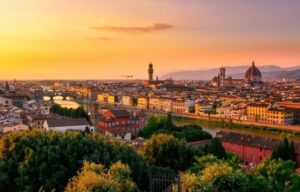
Florence, the capital of Tuscany, is a paradise for those who appreciate art, history, and culture. Known as the cradle of the Renaissance, Florence boasts world-famous museums, galleries, and architectural marvels, including the Uffizi Gallery, Michelangelo’s David, and the stunning Florence Cathedral.
Why Retire in Florence?
∙ Cultural Richness: The city’s rich cultural heritage ensures that there’s always something to explore or learn.
∙ Healthcare: Florence has excellent healthcare facilities, making it a secure option for retirees.
∙ Connectivity: The city is well-connected by train, allowing easy travel to other parts of Italy and Europe.
∙ Expat Community: A significant expat community means it’s easy to meet other retirees and find English-speaking services.
2. Lucca: A Tranquil Tuscan Gem
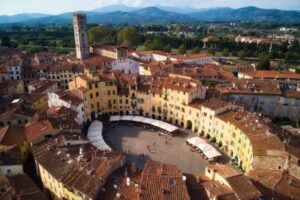
Lucca, also located in Tuscany, is a smaller, more tranquil city compared to Florence. Surrounded by well-preserved Renaissance walls, Lucca is known for its cobbled streets, charming piazzas, and historical churches. Its flat landscape and pedestrian-friendly pathways make it perfect for exploring on foot or by bicycle.
Why Retire in Lucca?
∙ Walkability: The city is perfect for leisurely strolls, with most attractions accessible on foot.
∙ Cost of Living: Lucca is more affordable than major cities like Florence or Rome, offering a high quality of life at a lower cost.
∙ Safety: Lucca is known for its safety, with low crime rates and a friendly community.
∙ Proximity to Nature: The city is close to the Tuscan countryside, offering easy access to nature and outdoor activities.
3. Rome: For the Urban Explorer
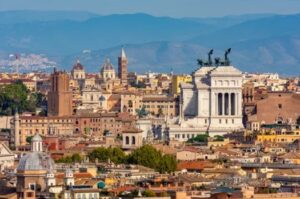
Rome, the Eternal City, is ideal for those who want to immerse themselves in a bustling urban environment while being surrounded by millennia of history. Rome offers endless opportunities for exploration, from the ancient ruins of the Colosseum and the Roman Forum to the Vatican City.
Why Retire in Rome?
∙ Cultural and Historical Richness: Rome is unparalleled in its historical and cultural offerings.
∙ Healthcare: The city has some of the best hospitals and medical care in Italy.
∙ Accessibility: As the capital city, Rome is well-connected globally, making it easy for family and friends to visit.
∙ Diverse Neighborhoods: Rome offers a variety of neighborhoods, each with its own character, catering to different lifestyles and preferences.
4. Bologna: A Food Lover’s Paradise
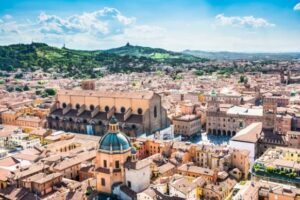
Bologna, the capital of the Emilia-Romagna region, is renowned for its culinary excellence, including famous dishes like tagliatelle al ragù (Bolognese sauce). It’s a vibrant city with a youthful energy, thanks to its historic university, the oldest in the world.
Why Retire in Bologna?
∙ Gastronomy: Bologna offers some of the best food in Italy, perfect for those who appreciate fine cuisine.
∙ Cultural Life: The city has a rich cultural scene, with frequent concerts, exhibitions, and theater performances.
∙ Affordable Living: Compared to other major Italian cities, Bologna is relatively affordable, especially in terms of housing.
∙ Central Location and Public Transportation: Bologna’s central location makes it an excellent base for exploring the rest of Italy by train. The city also boasts a well-connected public transportation system, making it easy to get around.
∙ Green Spaces: Numerous parks and green spaces provide a peaceful retreat from city life, perfect for relaxation and leisure.
∙ Healthcare Services: Bologna has excellent healthcare services, ensuring residents have access to top-notch medical care.
5. Sorrento: Coastal Beauty and Relaxation
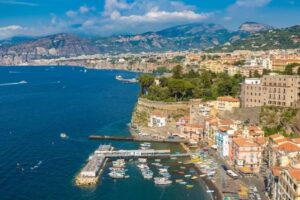
For those who dream of retiring by the sea, Sorrento is a picturesque option. Located on the Amalfi Coast, Sorrento offers stunning views of the Mediterranean, charming streets lined with lemon trees, and a relaxed pace of life.
Why Retire in Sorrento?
∙ Scenic Beauty: Sorrento’s breathtaking coastal views and mild climate make it a perfect spot for relaxation.
∙ Outdoor Activities: The region is ideal for outdoor enthusiasts, offering hiking, boating, and easy access to the island of Capri.
∙ Tourism Infrastructure: As a popular tourist destination, Sorrento has excellent amenities, including restaurants, shops, and medical facilities.
∙ Proximity to Naples: Sorrento is just a short train ride from Naples, offering easy access to a larger city’s amenities.
6. Verona: Romance and Rich Heritage
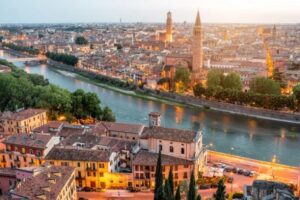
Verona, the city of Romeo and Juliet, is known for its romantic ambiance and well-preserved Roman architecture. Nestled in the Veneto region, Verona offers a peaceful yet vibrant environment, with stunning architecture and a rich cultural calendar.
Why Retire in Verona?
∙ Cultural Events: Verona hosts numerous cultural events, including opera performances in its ancient Roman amphitheater.
∙ Historical Significance: The city’s history is reflected in its well-preserved medieval buildings and Roman ruins.
∙ Mild Climate: Verona enjoys a mild climate, with hot summers and cool winters, making it comfortable year-round.
∙ Accessible Location: Verona’s location near Lake Garda and the Dolomites makes it ideal for those who enjoy outdoor activities.
∙ Healthcare Services: Verona’s healthcare system is highly regarded.
7. Siena: A Step Back in Time
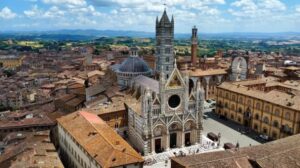
Siena, another Tuscan gem, is a city that has preserved its medieval charm like few others. Known for its stunning Gothic architecture and the famous Palio horse race, Siena offers a unique and tranquil environment, perfect for retirees looking for a slower pace of life.
Why Retire in Siena?
∙ Historic Atmosphere: Siena’s well-preserved medieval center is a UNESCO World Heritage site, offering a unique living environment.
∙ Sense of Community: Siena has a strong sense of community, with friendly locals and a close-knit atmosphere.
∙ Affordable Living: The cost of living in Siena is lower compared to larger cities like Florence or Rome.
∙ Proximity to Florence: Siena is close to Florence, allowing easy access to a larger city’s amenities while enjoying a quieter life.
Retiring in Italy offers a chance to live in one of the world’s most culturally rich and visually stunning countries. Whether you prefer the vibrant city life of Rome, the artistic treasures of Florence, the peaceful charm of Lucca, or the coastal beauty of Sorrento, Italy has something to offer every retiree. Each of these cities provides a unique blend of history, culture, and lifestyle, making Italy a top destination for those looking to enjoy their retirement to the fullest.
Read more:
What is the Elective Residency Visa (ERV)?
How to Benefit from Italy’s 7% Tax Rate for Foreign Pensioners
12 Captivating Small Towns in Italy with Populations Under 10,000
Learn about the residence permit for digital nomads from non-EU countries working in Italy
Italy’s Investor Visa: A Visa to Attract Strategic Investments from Abroad
Find and Buy Your Ideal Property in Italy with Our Professional Services
Buying Property in Italy – How to Get a Mortgage as a Foreigner
How to Open a Bank Account in Italy as an Expat
Learn Italian and open up new possibilities for your career and personal growth
Prepare for the CILS B1 Citizenship exam to obtain citizenship by marriage, residence or study or work in Italy.
Switching to a self-employment permit from a study or job-seeking one
Understanding the Tessera Sanitaria: Your Italian Health Insurance Card
Non-Married Partners: How to Obtain a Residence Permit in Italy as De Facto Cohabitants
How to get tax identification number for foreign citizens (Codice Fiscale)
How to register in Italy as an EU citizen
Mastering Public Transport in Italy
The Advantages of Dual Citizenship with an Italian Passport: Unlocking Boundless Opportunities
What you need to know about Visas and Permits to stay in Italy
Red flags to identify a scam when renting in Italy

Hiking In The Abruzzo, Lazio and Molise National Park: A Fall Adventure For Expats
Guest Article written by Sal from Nature of Sal October is a wonderful time for expats to explore the Abruzzo, Lazio and Molise National Park (“Parco nazionale d’Abruzzo, Lazio e Molise”, also known as PNALM), located east of Rome. The park, one of three National Parks in Abruzzo, is renowned for its stunning autumn colors, […]

The Best Places to Visit in Italy by Train This Fall
Italy is one of Europe’s most captivating destinations all year round, but fall brings a unique charm that enhances its picturesque landscapes, historic cities, and culinary delights. With cooler temperatures, fewer tourists, and a golden hue that blankets the countryside, autumn is the perfect season to explore the country by train. Thanks to Italy’s extensive […]

Understanding Salaries in Italy: A Guide for Expats and Newcomers
If you’re an expat living in Italy or someone considering relocating, understanding the salary landscape is key to planning your life in the country. This article provides an overview of average salaries in Italy in 2024, how they vary by profession, age, gender, education, and region, as well as how they compare to other European […]

Preparing For Cooler Weather: Fall Hiking Tips For Expats
Guest Article written by Sal from Nature of Sal As summer fades into fall, the cooler weather provides a refreshing change for hikers in Rome. For expats, it’s important to adjust your hiking gear and preparation to enjoy the trails comfortably and safely. Dressing for Fall Hikes – Layering: Start with a moisture-wicking base layer, […]
Guest Article written by Sal from Nature of Sal
As a hiker in Rome, having the right gear is crucial for a safe and enjoyable hiking experience, especially during the hot summer months. Here’s a guide to the must-have hiking essentials to tackle Rome’s summer trails.
Essential Hiking Gear
– Lightweight Backpack: Choose a comfortable, breathable backpack with enough space for water, snacks, and essentials.
– Hydration System: A hydration bladder or multiple water bottles are vital to stay hydrated in the summer heat.
– Moisture-Wicking Clothing: Wear breathable, moisture-wicking fabrics to stay cool and dry.
Protective Gear
– Sun Protection: A wide-brimmed hat, sunglasses, and high-SPF sunscreen are essential to protect against the strong sun.
– Bug Spray: Insect repellent is crucial, especially in areas near water.
– First Aid Kit: Always carry a basic first aid kit with bandages, antiseptic wipes, and any personal medications.
Footwear and Accessories
– Breathable Hiking Shoes: Opt for shoes with good ventilation and sturdy soles for rocky terrain.
– Trekking Poles: Useful for stability on uneven paths and reducing strain on your knees.
– Navigation Tools: A map, compass, or GPS device helps you stay on track, especially on less familiar trails.
Packing Tips
– Light Layers: Even in summer, mornings and evenings can be cooler. Pack light layers that are easy to add or remove.
– Snacks: Bring high-energy snacks like trail mix, dried fruit, and protein bars to keep your energy up.
– Emergency Supplies: A whistle, multi-tool, and emergency blanket can be lifesavers in unexpected situations.
Having the right gear can make all the difference when hiking in Rome’s summer heat. By preparing with these essentials, expat hikers can ensure a safe, comfortable, and enjoyable experience on the trails.
Where can I find hikes by public transport?
With an abundance of hiking options accessible by train, Rome invites you to embark on an unforgettable adventure with your loved ones. So pack your bags, hop on board the train, and let’s explore the stunning landscapes and natural wonders of Rome together!
Ready to start planning your family hiking adventure? Visit Nature of Sal’s FREE HikeLine Map for more information and inspiration. Let’s make memories that will last a lifetime!
And as always: Stay fit, hike a bit!
Sal
Read more about:

Hiking In The Abruzzo, Lazio and Molise National Park: A Fall Adventure For Expats
Guest Article written by Sal from Nature of Sal October is a wonderful time for expats to explore the Abruzzo, Lazio and Molise National Park (“Parco nazionale d’Abruzzo, Lazio e Molise”, also known as PNALM), located east of Rome. The park, one of three National Parks in Abruzzo, is renowned for its stunning autumn colors, […]

The Best Places to Visit in Italy by Train This Fall
Italy is one of Europe’s most captivating destinations all year round, but fall brings a unique charm that enhances its picturesque landscapes, historic cities, and culinary delights. With cooler temperatures, fewer tourists, and a golden hue that blankets the countryside, autumn is the perfect season to explore the country by train. Thanks to Italy’s extensive […]

Understanding Salaries in Italy: A Guide for Expats and Newcomers
If you’re an expat living in Italy or someone considering relocating, understanding the salary landscape is key to planning your life in the country. This article provides an overview of average salaries in Italy in 2024, how they vary by profession, age, gender, education, and region, as well as how they compare to other European […]

Preparing For Cooler Weather: Fall Hiking Tips For Expats
Guest Article written by Sal from Nature of Sal As summer fades into fall, the cooler weather provides a refreshing change for hikers in Rome. For expats, it’s important to adjust your hiking gear and preparation to enjoy the trails comfortably and safely. Dressing for Fall Hikes – Layering: Start with a moisture-wicking base layer, […]
Learn about the residence permit for digital nomads from non-EU countries working in Italy
Italy’s Investor Visa: A Visa to Attract Strategic Investments from Abroad
Find and Buy Your Ideal Property in Italy with Our Professional Services
Buying Property in Italy – How to Get a Mortgage as a Foreigner
How to Open a Bank Account in Italy as an Expat
Learn Italian and open up new possibilities for your career and personal growth
Prepare for the CILS B1 Citizenship exam to obtain citizenship by marriage, residence or study or work in Italy.
Switching to a self-employment permit from a study or job-seeking one
FAQs for Italian Citizenship by Marriage (2023)
Understanding the Tessera Sanitaria: Your Italian Health Insurance Card
Non-Married Partners: How to Obtain a Residence Permit in Italy as De Facto Cohabitants
How to get tax identification number for foreign citizens (Codice Fiscale)
How to register in Italy as an EU citizen
Mastering Public Transport in Italy
The Advantages of Dual Citizenship with an Italian Passport: Unlocking Boundless Opportunities
What you need to know about Visas and Permits to stay in Italy
Red flags to identify a scam when renting in Italy
Whether you’re a local or an expat, Ferragosto offers a fantastic opportunity to immerse yourself in the country’s rich culture and traditions. From museum tours and open-air concerts to seaside festivals and religious processions, there’s something for everyone. Here’s a roundup of the top events in cities with vibrant expat communities—perfect for those looking to join in the festivities.
Turin
Special Offers and Events at Various Museums

Palazzo Madama, GAM, and MAO
∙ Special Rates and Guided Tours: On August 15th, these museums are offering special rates and guided tours for just €6. To book, email [email protected] or call 0115211788.
National Cinema Museum
∙ Extended Hours and Discounted Tickets: The museum will be open from 9 AM to 9 PM with reduced ticket prices.
∙ Guided Tours: From 11 AM to 3 PM, guided tours will be available for an additional fee of €6.
Free Admission
Several other museums will offer free admission on August 15th, including:
∙ Camera: Free admission to the “Futures 2023” exhibition.
∙ Museo Pietro Micca
∙ Museo della Frutta
∙ Museo della Radio
∙ Gallerie d’Italia
∙ Musei Lombroso e di Anatomia
∙ Museo Diffuso della Resistenza
* Guided tours will be conducted in Italian.
Milan
Grand Mid-Summer Ball
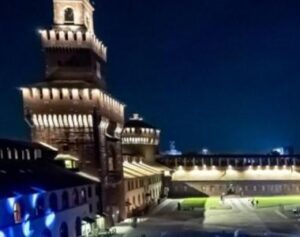
On Ferragosto evening at 9 PM, dance the night away at the illuminated Sforza Castle to classic and popular Italian music, featuring genres like liscio, fox trot, polka, and waltz.
∙ Paid Admission: €12
∙ Tickets available on Mailticket and Dice
∙ Info: [email protected] or 0236798120
Free Exhibition: Valerio Adami – Pittore di Idee

Valerio Adami’s large-format paintings, often associated with the “pop” genre, use sophisticated visual metaphors to encapsulate philosophical, literary, and mythological concepts.
∙ Palazzo Reale: Free admission, no reservations required, until 10:30 PM
Visit the Exhibition: “Philippe Halsman. Lampo di genio.”

This exhibition features over 100 photographs by legendary photographer Philippe Halsman, showcasing his iconic “jumpology” series and portraits of famous figures.
∙ Palazzo Reale: Paid admission: €17, until 10:30 PM
Obey – The Art of Shepard Fairey

Explore the evolution of street artist Shepard Fairey, known for his “HOPE” poster featuring Barack Obama, at the Fabbrica del Vapore.
∙ Paid Admission: €16, until 10:00 PM
Outdoor Cinema

Catch a movie at one of the many summer arenas spread throughout the city.
For program details, visit:
∙ Spaziocinema
∙ Mare Milano
∙ Centro Asteria
∙ Cinema Muto
Genoa
“Ferragustando”: The Shared Feast in the Historic Center
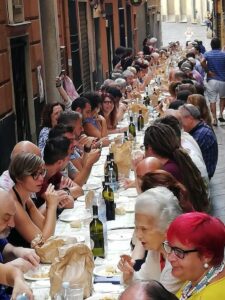
Photo from GenovaToday
“Ferragustando” is a social lunch featuring a single, shared table extending from Piazza Ferretto to Piazza San Bernardo, where people gather to savor local specialties.
∙ Paid Admission: €20 (€10 for children and seniors)
∙ Menus for those with dietary restrictions are available upon reservation at U Gelato Du Caruggiu.
∙ Event starts at 12:30 PM
Sunset Aperitivo with a View
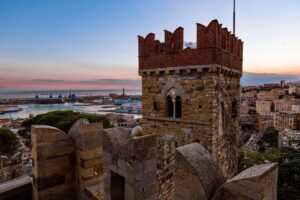
Book an aperitif at Castello D’Albertis to enjoy the sunset over the city.
∙ Castello D’Albertis, Bonton Bistrot: From 6 PM
∙ For reservations: 391 7610087
Bologna
Ferragosto at Serre

A yearly summer tradition, Ferragosto at the Serre dei Giardini Margherita offers relaxing vibes and vinyl tunes. Enjoy a DJ set by Thomas Les Vaches & Red Chocolate (Mint Sound).
∙ Location: Via Castiglione 134 and Viale Stenio Polischi 9. Access is on foot or by bicycle.
∙ Free Admission: From 5 PM to 11:30 PM
Vacanze a Riccione

Enjoy a seaside comedy in the Courtyard of Honor at Palazzo d’Accursio, part of the Favolosissima – Burattini a Bologna event series.
∙ Paid Admission: €7
∙ Event starts at 8:30 PM
Florence
Florence on the Beach!
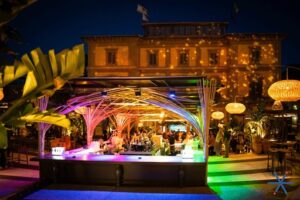
Celebrate Ferragosto at Villa Vittoria with a beach party. The dress code is casual, but not too casual. Expect a surprise dinner and a special beach-themed atmosphere.
∙ For Information and Reservations: Call +39 347 7077014 or email [email protected]
Ferragosto at Instabile with “Criminal Mambo”

Enjoy a DJ set by Criminal Mambo at Instabile’s summer space, with cocktails, craft beers, and a selection of organic wines.
∙ Via della Funga 27: Free admission, from 7:30 PM
Free Admission to the Forte di Belvedere
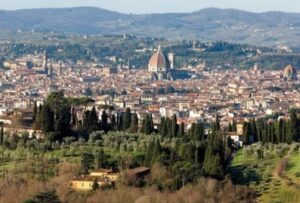
Visit this historic and scenic spot for panoramic views of Florence.
∙ Forte di Belvedere: Free admission until 8:00 PM
Free Admission to the Santa Maria Novella Complex
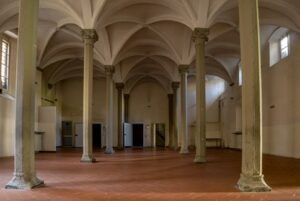
Explore this iconic landmark, which includes a basilica, convent, and more.
∙ Basilica di Santa Maria Novella: Free admission from 1:00 PM to 5:30 PM
Rome
Acrobatic Show at Ostia Antica

“Soul of Nature” by Street Theater Artemakia is an acrobatic fairytale addressing environmental issues through a blend of wonder, poetry, and acrobatics.
∙ Location: Borgo di Ostia Antica, Piazza della Rocca
∙ For information and reservations: [email protected]
∙ Event starts at 9:00 PM
Daniele Corvasce Gypsy Trio + Marjolein – Gypsy Mini Fest
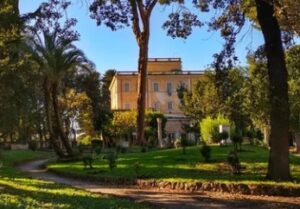
This event is dedicated to Django Reinhardt, featuring a tribute concert and a lively evening at Villa Celimontana.
∙ Location: Villa Celimontana, Via della Navicella 12
∙ Free Admission: Concert starts at 10:00 PM
Concerti del Tempietto
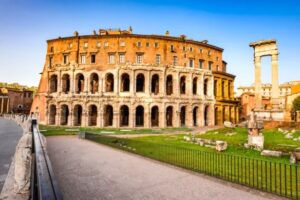
The evening begins at 6:30 PM with a piano concert by Sofya Erukhimova, showcasing the works of Chopin, Rachmaninoff, Shostakovich, and Balakirev. Following the concert, attendees can join a guided tour of the archaeological park surrounding the Teatro di Marcello at 7:45 PM, available in both Italian and English. The night concludes with an 8:30 PM piano concert by Emanuele Frenzilli, featuring compositions by Schubert, Brahms, Chopin, Scriabin, and Liszt.
∙ Location: Chiostro di Campitelli al Teatro di Marcello, Piazza Campitelli, 9
∙ Paid Admission: From €15.50 for the entire event, starting at 6:30 PM. Get your tickets here.
Tiberis 2024
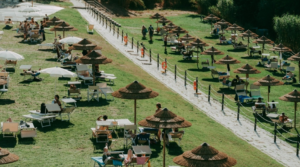
Celebrate Ferragosto with live music, water games, and more at Tiberis, a park overlooking the Tiber River. The highlight of the evening will be a live performance by Jazzindahouse at 9:00 p.m., featuring a trio with a DJ set, percussion, and sax. The music blends house, nu-jazz, Brazilian chill-out, and jazzhouse, creating an unforgettable festive atmosphere along the Tiber.
∙ Location: Lungotevere Dante, 1
∙ Free Admission: Open from 8:00 AM to 12:00 AM
∙ For information and reservations call 06 5654 6254 or email [email protected]
Along the Tiber… Rome 2024
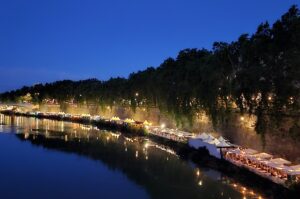
Experience history, culture, and leisure along the banks of the Tiber, with a special performance with music, watermelon, and sangria in a stunning setting.
∙ Location: Salotto Tevere, under Ponte Cestio
∙ Free Admission: The performance starts at 9:30 PM
Naples
Concert and Free Breakfast at Dawn
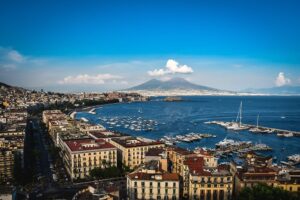
Start the day with a concert on the panoramic terrace of Sant’Antonio a Posillipo, featuring a string quartet and a tribute to Astor Piazzolla. The concert concludes with a breakfast of coffee and hot croissants.
∙ Departure points: Piazza Municipio and Parcheggio Brin
∙ Free Admission: Starts at 5:00 AM
∙ Booking on Eventbrite
Free Sailing Tour
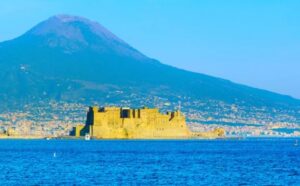
For the “Naples at Sunset” itinerary, you will set sail on two rubber boats to admire the Posillipo hill and the Gulf of Naples, passing by Castel dell’Ovo, Lungomare Caracciolo, Mergellina, Palazzo Donn’Anna, Villa Lauro, Villa Volpicelli, Villa Rosebery, Rocce Verdi, Marechiaro, Nisida, Gaiola, and Punta Cavallo.
∙ Meeting Point: Via Partenope, in front of Hotel Vesuvio
∙ Booking on Eventbrite
∙ Tour starts at 5:00 PM
Celebration of the Assumption of the Virgin Mary

The day concludes with an event hosted by the Patronal Festivals: the celebration of the Assumption of the Virgin Mary at the Royal Pontifical Basilica of San Giacomo degli Spagnoli, Piazza Municipio 27. At 8:30 PM, a sacred music concert will be performed by the Suaviternova Choir, directed by Maestro Pietro Biancardi.
∙ Location: Piazza Municipio 27
∙ Admission: Free until full capacity is reached
∙ Time: 8:00 PM
Sicily
La Vara dell’Assunta Procession in Messina

La Vara dell’Assunta is a spectacular and deeply rooted religious event held annually in Messina. This event celebrates the Assumption of the Virgin Mary and is one of Italy’s most significant folkloric-religious traditions.
The highlight of the celebration is the Vara, a colossal pyramidal structure symbolizing the Assumption of the Virgin Mary into heaven. Originally built in the 16th century, it is adorned with statues representing various religious figures, including angels and Jesus Christ holding the Virgin Mary.
Thousands of devotees, dressed in white, participate in dragging the Vara through the streets, creating a powerful and moving spectacle. The event concludes with a blessing at the Cathedral and a Mass, followed by the distribution of pieces of the ropes used to pull the Vara among the faithful.
If you plan to attend, it’s advisable to arrive early to secure a good viewing spot and fully immerse yourself in the atmosphere of this historic celebration.
∙ Procession start time: 6:30 PM
∙ Route: Beginning at Piazza Castronovo, proceeding along Via Garibaldi to the Cathedral Square (Piazza Duomo)
Siracusa’s Festa del Mare and Regata dell’Assunta
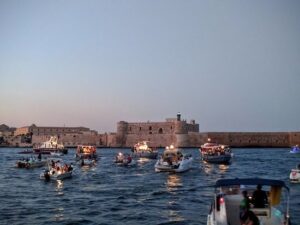
Festa del Mare e Regata dell’Assunta is a cherished event in Siracusa that celebrates the Assumption of the Blessed Virgin Mary, blending religious devotion with maritime tradition.
The heart of the celebration is the regatta, a boat race showcasing the skill and spirit of local rowers. The competition is fierce, and the atmosphere along the shoreline is electric with excitement.
Beyond the regatta, the Festa del Mare offers a variety of activities and events, including:
∙ Religious processions: Honoring the Assumption of the Virgin Mary, with colorful displays and traditional hymns.
∙ Live music and entertainment: Creating a festive atmosphere for locals and visitors alike.
∙ Food stalls: Offering delicious local cuisine and delicacies.
∙ Fireworks: A dazzling display illuminating the night sky.
Schedule:
∙ 7:00 PM: The revered statue of the Blessed Virgin Mary Assunta will be taken out from the Church of San Filippo Apostolo. The procession will follow this route: Piazza San Filippo, Via del Crocefisso, Via Roma, Piazza Minerva, Piazza Duomo, Via Saverio Landolina, Via Amalfitania, Via Ruggero Settimo, and Largo Porta Marina.
∙ 8:00 PM: The maritime procession begins within the waters of Porto Grande di Siracusa, including a traditional blessing of the sea and a prayer for those who have perished at sea, followed by a fireworks display by “Fiori di Fuoco” from Macchia di Giarre (CT).
∙ 9:00 PM: The boat will return to Porto Grande di Siracusa, followed by a procession through the streets: Largo Porta Marina, Via Savoja, Largo XXV Luglio, Corso Giacomo Matteotti, Piazza Archimede, Via Maestranza, Via della Giudecca, and Piazza San Filippo.
If you plan to attend, be sure to arrive early to fully experience the procession and the stunning fireworks display.
With such a diverse array of events happening across Italy, Ferragosto 2024 promises something for everyone to enjoy. As an expat, this is the perfect time to connect with the local culture, meet new people, and celebrate one of Italy’s most cherished holidays.
Read more about:
The Typical Dishes of the Italian Summer
12 Enchanting Small Towns in Italy You Must Visit
Exploring Italy’s Stunning Beaches by Train: A Guide for Expats
Off the Beaten Path: Unique Things to Do in Italy in Summer.
Italy’s Summer Festivals 2024
Exploring Puglia: From Beaches to Baroque Towns
An 8-Day Tour of the Amalfi Coast
Exploring Italy’s lakes by train
Italy’s Most Enchanting Towns Accessible by Train
Discover Rome’s Beaches Easily Accessible by Public Transportation

Hiking In The Abruzzo, Lazio and Molise National Park: A Fall Adventure For Expats
Guest Article written by Sal from Nature of Sal October is a wonderful time for expats to explore the Abruzzo, Lazio and Molise National Park (“Parco nazionale d’Abruzzo, Lazio e Molise”, also known as PNALM), located east of Rome. The park, one of three National Parks in Abruzzo, is renowned for its stunning autumn colors, […]

The Best Places to Visit in Italy by Train This Fall
Italy is one of Europe’s most captivating destinations all year round, but fall brings a unique charm that enhances its picturesque landscapes, historic cities, and culinary delights. With cooler temperatures, fewer tourists, and a golden hue that blankets the countryside, autumn is the perfect season to explore the country by train. Thanks to Italy’s extensive […]

Understanding Salaries in Italy: A Guide for Expats and Newcomers
If you’re an expat living in Italy or someone considering relocating, understanding the salary landscape is key to planning your life in the country. This article provides an overview of average salaries in Italy in 2024, how they vary by profession, age, gender, education, and region, as well as how they compare to other European […]

Preparing For Cooler Weather: Fall Hiking Tips For Expats
Guest Article written by Sal from Nature of Sal As summer fades into fall, the cooler weather provides a refreshing change for hikers in Rome. For expats, it’s important to adjust your hiking gear and preparation to enjoy the trails comfortably and safely. Dressing for Fall Hikes – Layering: Start with a moisture-wicking base layer, […]
Learn about the residence permit for digital nomads from non-EU countries working in Italy
Italy’s Investor Visa: A Visa to Attract Strategic Investments from Abroad
Find and Buy Your Ideal Property in Italy with Our Professional Services
Buying Property in Italy – How to Get a Mortgage as a Foreigner
How to Open a Bank Account in Italy as an Expat
Learn Italian and open up new possibilities for your career and personal growth
Prepare for the CILS B1 Citizenship exam to obtain citizenship by marriage, residence or study or work in Italy.
Switching to a self-employment permit from a study or job-seeking one
Understanding the Tessera Sanitaria: Your Italian Health Insurance Card
Non-Married Partners: How to Obtain a Residence Permit in Italy as De Facto Cohabitants
How to get tax identification number for foreign citizens (Codice Fiscale)
How to register in Italy as an EU citizen
Mastering Public Transport in Italy
The Advantages of Dual Citizenship with an Italian Passport: Unlocking Boundless Opportunities
What you need to know about Visas and Permits to stay in Italy
Red flags to identify a scam when renting in Italy
Italy, embracing the modern work culture of digital nomads, has introduced a comprehensive set of rules for non-EU digital nomads seeking to enter the Italian landscape. The interministerial decree, a testament to Italy’s progressive stance, offers a detailed guide for these skilled individuals who blend the art of living with the science of remote working.
Digital Nomads: Entry Rules for Non-EU Workers in Italy
Published in the Official Journal No. 79 on April 4, 2024, the interministerial decree outlines the rules for entry and stay in Italy for non-EU digital nomads.
These are non-EU workers who are highly skilled in smart working, utilizing technological tools to work remotely.
The law defines the procedures and requirements for entry and the issuance of a residence permit, as well as the categories of workers who fall under the definition of a digital nomad.
It implements the provisions of the Act of Conversion of the Decree Sostegni Ter (Article 6-quinquies of Legislative Decree No. 4/2022), which legally established the framework for digital nomads by amending Article 27 of the Consolidated Act on Immigration (Legislative Decree No. 286/1998).
To enter as digital nomads, neither the temporary nulla osta nor the work nulla osta is required.
As indicated in Article 3 of the Decree, entry and residence are permitted for workers who possess:
A minimum annual income not less than three times the minimum level required for exemption from health expenditure participation;
• Health insurance for medical treatment and hospital admission, valid for the national territory and the duration of the stay;
• Documentation of accommodation arrangements;
• At least 6 months of prior experience in the field of remote work;
• An employment or cooperation contract, or its binding offer.
If all requirements are met, a residence permit valid for one year and renewable is issued.
Digital Nomads: Applying for the Residence Permit
The residence permit must be requested directly from the police headquarters in the province where the worker is located, within eight working days of entering the country.
The document will be labeled “digital nomad – remote worker.”
The permit may be revoked if the necessary requirements are not maintained or if the employer has been convicted in the last five years of offenses referred to in Article 22, Paragraph 5a of the Consolidated Act.
Digital nomads who obtain a residence permit may also be joined by family members, who will receive a visa of the same duration as the worker.
Upon issuance of the residence permit, the tax code (Codice Fiscale) is also generated and communicated.
As a final step, digital nomads must also apply for a VAT number (Partita IVA).
For further details, please refer to the full text of the Interministerial Decree of February 29, 2024.
For assistance and advice on obtaining a visa and residence permit for “digital nomad – remote worker,” please send an email to [email protected].
Find and Buy Your Ideal Property in Italy with Our Professional Services
Buying Property in Italy – How to Get a Mortgage as a Foreigner
How to Open a Bank Account in Italy as an Expat
Learn Italian and open up new possibilities for your career and personal growth
Prepare for the CILS B1 Citizenship exam to obtain citizenship by marriage, residence or study or work in Italy.
Switching to a self-employment permit from a study or job-seeking one
FAQs for Italian Citizenship by Marriage (2023)
Understanding the Tessera Sanitaria: Your Italian Health Insurance Card
Non-Married Partners: How to Obtain a Residence Permit in Italy as De Facto Cohabitants
How to get tax identification number for foreign citizens (Codice Fiscale)
How to register in Italy as an EU citizen
Mastering Public Transport in Italy
The Advantages of Dual Citizenship with an Italian Passport: Unlocking Boundless Opportunities
What you need to know about Visas and Permits to stay in Italy
Red flags to identify a scam when renting in Italy
Family reunification holds a significant place in Italian society, recognizing the importance of maintaining strong family ties. As families face separation due to migration, conflicts, or other circumstances, the legal process of family reunification becomes a crucial avenue to bring them back together. In this blog, we will explore the legal services available in Italy to facilitate family reunification, highlighting the rights, procedures, and benefits associated with this process.

Understanding Family Reunification in Italy:
In Italy, family reunification falls under the legal framework of immigration and is designed to reunite family members who are living separately due to migration. It allows certain categories of individuals, such as Italian citizens, foreign residents, and refugees, to bring their family members to join them in Italy.
Rights and Eligibility Criteria:
Italian law acknowledges the right to family reunification, understanding its significance in promoting social cohesion and personal well-being. The rights and eligibility criteria for family reunification vary based on the status of the individual residing in Italy. For example, Italian citizens have the right to reunite with their immediate family members, including spouses, children, and dependent parents. Non-EU foreign residents and refugees also have the opportunity to reunify with their family members under specific conditions and requirements.
Legal Procedures and Documentation:
Family reunification in Italy involves navigating through legal procedures and submitting the necessary documentation. It typically includes gathering proof of family relationship, such as marriage or birth certificates, and obtaining a visa for the family member seeking reunification. The process also requires compliance with specific financial and accommodation requirements to ensure the ability to support the family members upon their arrival.
Benefits of Family Reunification:
Family reunification in Italy offers numerous benefits for both individuals and society. Reuniting families promotes emotional well-being, providing a sense of love, support, and belonging. It enables children to grow up in a stable family environment, fostering their development and integration into Italian society. Moreover, family reunification contributes to social cohesion by strengthening community ties and promoting intercultural exchange.
Legal Services for Family Reunification:
To navigate the complex process of family reunification, legal services in Italy play a crucial role. Qualified immigration lawyers specializing in family law can provide expert guidance, assisting individuals in understanding their rights, fulfilling legal requirements, and facilitating the reunification process. These legal professionals ensure that families have access to accurate information, proper documentation, and representation throughout the proceedings.
Family reunification through legal services in Italy is a fundamental aspect of fostering strong family bonds and promoting social integration. The country’s legal framework recognizes the significance of family unity and provides opportunities for individuals to reunite with their loved ones. By understanding the rights, procedures, and benefits associated with family reunification, families can navigate the legal process more effectively. Utilizing the expertise of legal professionals ensures a smooth and successful reunification process, enabling families to build a brighter future together in Italy.
Don’t forget to check out our Social Media accounts and subscribe to our Newsletter so you can be updated with information customized for people that want to move, live and love Italy!
FAQs for Italian citizenship by Marriage (2023)
Understanding the Tessera Sanitaria: Your Italian Health Insurance Card
Non-Married Partners: How to Obtain a Residence Permit in Italy as De Facto Cohabitants
How to get tax identification number for foreign citizens (Codice Fiscale)
How to register in Italy as a EU citizen
Mastering Public Transport in Italy
The Advantages of Dual Citizenship with an Italian Passport: Unlocking Boundless Opportunities
What you need to know about Visas and Permits to stay in Italy
The Schengen Area, comprising 26 European countries, is known for its seamless borders and visa-free travel. However, for non-European Economic Area (EEA) nationals, there are specific rules regarding the duration of stay. One of the most important regulations is the 90/180-day rule.
The Schengen Area
The Schengen Area, comprising most EU nations, excludes Cyprus and Ireland. On March 31, 2024, Bulgaria and Romania attained membership, marking the latest additions. This accession means individuals crossing internal air and sea borders face no scrutiny. Notably, non-EU nations like Iceland, Norway, Switzerland, and Liechtenstein have also integrated into the Schengen Area.
Understanding the Rule
What Is the 90/180-Day Rule?
◦ The 90/180-day rule stipulates that non-EEA nationals can stay in the Schengen Area for a maximum of 90 days within any 180-day period.
◦ This means that travelers must keep track of their days spent in the Schengen countries to avoid overstaying.
How Does It Work?
◦ The clock starts ticking from the day you first enter the Schengen Area.
◦ Within any rolling window of 180 days, you can spend up to 90 days in total.
◦The 180-day period is not fixed; it shifts as each day passes.
The Schengen 90/180-Day Rule Explained:
◦ Staying for 90 days: As soon as you enter any country within the Schengen area, your 90-day clock starts. This counts for every country in the zone. For example, if you spend 30 days in Germany, then 30 days in France, and 30 days in Austria, you’ve spent 90 days in the Schengen zone. Your 90-day count stops the moment you leave the area.
◦ Spending your 90 days within 180 days: The 90 days you are allowed to spend in the Schengen zone are eligible for 180 days. This period is commonly called a “rolling timeframe” because it’s constantly moving—each day you spend in Schengen advances your 180-day period. This period is counted backward from your most recent entry or exit dates. For instance, if you enter the Schengen area on July 1, 2022, you count backward for 180 days from this date and calculate how many days you have spent in the Schengen area during these 180 days.
Practical Tips
Keep a Calendar:
◦ Maintain a record of your travel dates to ensure compliance with the rule.
◦ Use online calculators or apps to track your days in the Schengen Area.
– Recommended Tools:
▪ Schengen VisaInfo Calculator: This online calculator allows you to input your entry and exit dates, and it precisely calculates your stay within the Schengen Area. It shows your total days already stayed and the remaining days for the current 180-day timeframe. Remember that this calculator is a helpful tool but does not constitute a right to stay for a period resulting from its calculation.
▪ Ninety180: A user-friendly tool that performs the “rolling-window” calculation for you, helping you optimize your travel dates to make the most of your 90 in 180-day allowance3.
▪ Schengen Simple: Another calculator that maximizes your stays within the 90/180 rule. It instantly calculates your 90/180 travel allowance for every day in your calendar.
Exit and Reentry:
◦ Leaving the Schengen Area and reentering does not reset the clock.
◦ The 180-day period continues from your first entry.
Plan Ahead:
◦ If you need to stay longer, consider applying for a national visa or residence permit in a specific Schengen country.
Remember that violating the 90/180-day rule can result in fines, deportation, or future travel restrictions.
Read more:
A Guide to Living in Italy with a Dog
Dog Friendly places in and near Rome
A Guide to Events Happening in Spring in Milan, Rome, Florence, and Bologna
20 Places to Explore in Milan – A Local’s Guide
A Weekend Guide to Naples’ Culinary and Cultural Highlights
20 Places to Explore in Milan – A Local’s Guide
The Colossal Statue of Constantine: FREE Exhibition at the Capitoline Museums
15 Must-Visit Museums, Galleries, and Cultural Sites in Italy
Don’t Miss the Chance to Visit the Vatican Museums for Free
A Guide to Visiting the Vatican Museums
Italy’s Most Enchanting Towns Accessible by Train
New Celio Archaeological Park in Rome – Free Admission
Learn about the residence permit for digital nomads from non-EU countries working in Italy
Italy’s Investor Visa: A Visa to Attract Strategic Investments from Abroad
Find and Buy Your Ideal Property in Italy with Our Professional Services
Buying Property in Italy – How to Get a Mortgage as a Foreigner
How to Open a Bank Account in Italy as an Expat
Learn Italian and open up new possibilities for your career and personal growth
Prepare for the CILS B1 Citizenship exam to obtain citizenship by marriage, residence or study or work in Italy.
Switching to a self-employment permit from a study or job-seeking one
FAQs for Italian Citizenship by Marriage (2023)
Understanding the Tessera Sanitaria: Your Italian Health Insurance Card
Non-Married Partners: How to Obtain a Residence Permit in Italy as De Facto Cohabitants
How to get tax identification number for foreign citizens (Codice Fiscale)
How to register in Italy as an EU citizen
Mastering Public Transport in Italy
The Advantages of Dual Citizenship with an Italian Passport: Unlocking Boundless Opportunities
What you need to know about Visas and Permits to stay in Italy
Red flags to identify a scam when renting in Italy
In Italy, “De facto cohabitants” refer to couples who live together in a stable and committed relationship but are not legally married or in a civil partnership. They are commonly known as “cohabiting partners” or “unmarried couples.”
While they are not married in the eyes of the law, de facto cohabitants often share a household, contribute to each other’s lives financially and emotionally, and may have children together. The concept of de facto cohabitation recognizes the rights and responsibilities that arise from long-term cohabitation, allowing these couples to regulate certain aspects of their relationship through a cohabitation contract.
This cohabitation contract, as mentioned in the previous message, allows de facto cohabitants to regulate their property relationships related to their life in common, specifying aspects such as financial contributions, property ownership, and other legal matters. The “legge Cirinnà” (n. 76 del 20.5.2016) in Italy regulates this contract and provides legal recognition and protection to de facto cohabitants.
Requirements:
To enter into the cohabitation contract, certain criteria must be met:
– Both parties must coexist in fact, substantiated by corresponding anagraphic registration.
– The cohabitants must be adults and not interdicted, with no current marriage or civil union, and not have entered into another similar contract within its validity period.
– The contract must be written and can be executed through a public or private act, authenticated and subscribed by a notary or attorney who verifies compliance with mandatory rules and public policy.
– To proceed with the contract signing, each contractor must fulfill the following requirements:
● Be an adult with the capacity to understand and consent.
● Be free from any existing marriage, civil union, or other cohabitation contract within its validity period.
● Have no relationship of kinship, affinity, or adoption with the other contractor.
● Establish a stable cohabitation with the other contractor, with proof derived from anagraphic results.
● Register the cohabitation at the comune/city hall.
● Additionally, they must not be judicially interdicted.
Content:
The cohabitation contract should include the following elements:
Required:
– Indication of the residence of both contractors.
Optional:
– Modality of financial contributions from both contractors, based on their contributive capacity.
– Choice of property regime. Unlike married or civilly united couples, cohabitants do not acquire a different legal status.
Termination of the Contract:
The cohabitation contract can be terminated under the following circumstances:
– Death of one of the contractors.
– Marriage or civil union between the contractors or with a third party.
– Agreement between the contractors to terminate the contract.
– Unilateral termination by one contractor, with notice to the other, followed by notification and registration at the comune/city hall.
Cohabitation Contract with a Non-EU Citizen
The cohabitation contract also enables a non-EU citizen to apply for and obtain a family permit. The Italian public administration facilitates the stay of non-EU citizens who can demonstrate a stable relationship with an EU citizen. This proof of a stable relationship is established through the registration of the cohabitation contract.
Procedure:
To formalize the cohabitation contract, the following steps are involved:
– Collection of documents for the declaration of residence, including a residence certificate, and for non-EU citizens, a multiple language certificate of free civil status (with clearance/nullaosta issued by the Embassy) and rental contract or property deed.
– Preparation of the cohabitation contract, to be subscribed and authenticated by a notary or attorney.
– Choice of the property regime.
– The signing of the cohabitation contract.
– Registration of the contract with the revenue agency (agenzia delle entrate).
– Notification of the contract registration to the comune/city hall. After 30 days from the notification, the certificate of the cohabitation contract can be obtained.
In conclusion, the cohabitation contract grants non-EU citizens the opportunity to apply for a family permit, allowing them to reside in Italy as a cohabitant with an EU citizen partner. This legal recognition provides additional benefits and rights to de facto cohabitants in Italy.
Don’t forget to check out our Social Media accounts and subscribe to our Newsletter so you can be updated with information customized for people that want to move, live and love Italy!
Learn about the residence permit for digital nomads from non-EU countries working in Italy
Italy’s Investor Visa: A Visa to Attract Strategic Investments from Abroad
Find and Buy Your Ideal Property in Italy with Our Professional Services
Buying Property in Italy – How to Get a Mortgage as a Foreigner
How to Open a Bank Account in Italy as an Expat
Learn Italian and open up new possibilities for your career and personal growth
Prepare for the CILS B1 Citizenship exam to obtain citizenship by marriage, residence or study or work in Italy.
Switching to a self-employment permit from a study or job-seeking one
Understanding the Tessera Sanitaria: Your Italian Health Insurance Card
Non-Married Partners: How to Obtain a Residence Permit in Italy as De Facto Cohabitants
How to get tax identification number for foreign citizens (Codice Fiscale)
How to register in Italy as an EU citizen
Mastering Public Transport in Italy
The Advantages of Dual Citizenship with an Italian Passport: Unlocking Boundless Opportunities
What you need to know about Visas and Permits to stay in Italy
Red flags to identify a scam when renting in Italy

Hiking In The Abruzzo, Lazio and Molise National Park: A Fall Adventure For Expats
Guest Article written by Sal from Nature of Sal October is a wonderful time for expats to explore the Abruzzo, Lazio and Molise National Park (“Parco nazionale d’Abruzzo, Lazio e Molise”, also known as PNALM), located east of Rome. The park, one of three National Parks in Abruzzo, is renowned for its stunning autumn colors, […]

The Best Places to Visit in Italy by Train This Fall
Italy is one of Europe’s most captivating destinations all year round, but fall brings a unique charm that enhances its picturesque landscapes, historic cities, and culinary delights. With cooler temperatures, fewer tourists, and a golden hue that blankets the countryside, autumn is the perfect season to explore the country by train. Thanks to Italy’s extensive […]

Understanding Salaries in Italy: A Guide for Expats and Newcomers
If you’re an expat living in Italy or someone considering relocating, understanding the salary landscape is key to planning your life in the country. This article provides an overview of average salaries in Italy in 2024, how they vary by profession, age, gender, education, and region, as well as how they compare to other European […]

Preparing For Cooler Weather: Fall Hiking Tips For Expats
Guest Article written by Sal from Nature of Sal As summer fades into fall, the cooler weather provides a refreshing change for hikers in Rome. For expats, it’s important to adjust your hiking gear and preparation to enjoy the trails comfortably and safely. Dressing for Fall Hikes – Layering: Start with a moisture-wicking base layer, […]
Visas are issued by the Italian Embassy or Consular Sections of a foreign national’s country of residence. Permits to stay are issued in Italy by the Questura (Police Headquarters) having jurisdiction in the province where a foreign national is staying. Foreign nationals are required to apply for residence permits within 8 working days (i.e. excluding Sundays and holidays) of arrival.
Citizens of some foreign countries can visit Italy and stay for 3 months without a VISA. In some cases, citizens can stay for a longer period under a permit of stay or “permesso di soggiorno”. In most cases, foreign citizens must return to their country of origin and request a specific VISA at the corresponding Consulate. Therefore, we recommend to ask for a VISA at the Italian Consulate or Embassy of your country of origin in case you want to stay in Italy for a period longer than 3 months.
The most common types of VISA and Permit to stay are the following:
• VISA/Permit for family reunification: valid for a year from the date of issue; it is issued to the sponsoring migrant’s family members following approval of a reunification application.
• VISA/Permit for employment purposes (indefinite, fixed-time or seasonal contracts): this can only be issued after obtaining work authorization from the Sportello Unico per l’Immigrazione – SUI (Immigration Desk) at the Prefettura (central government’s territorial office). In order to enter into an employment relationship with a non-EU national residing abroad, employers, whether Italians or foreigners legally residing in Italy, are required to apply for permission to hire an individual migrant worker at the Immigration Desk in the province where the job will be carried out.
• VISA/Permit for self-employment purposes: may be applied for to conduct a non-occasional, self-employed work activity in the industrial, professional, handicraft or commercial sectors; to set up a company or partnership; to access corporate managerial positions. In order to obtain such a visa, foreign nationals must fulfil the same professional and moral requirements demanded for Italian citizens by the law with regard to the same type of activity.
• VISA/Permit for highly qualified workers: such is the case of journalists, highly specialized staff who work for a corporation domiciled in Italy, artists, dancers and musicians, etc (art. 27 Decreto Legislativo 25 luglio 1998, n. 286).
• Elective Residency Permit: the Elective Residence Visa/Permit is for those who have chosen Italy as the country of permanent residence and who are able to support themselves autonomously, without having to rely on employment while in Italy, whether as dependent employees, as self-employed employees or employees working remotely online. You cannot finance your residence in Italy through any type of work and to obtain the VISA/permit you must demonstrate that you own a property or that you have signed a lease.
Useful blogs:
Expats taxes in Italy 2021
FAQ: Italian taxation for Expats
Taxation in Italy
Tax benefits for those who transfer the fiscal residence to Italy
Useful links:
Ministry of Foreign Affairs (Italy)
Chamber of Commerce
Public administration for businesses
National Agency for Investment and Business Development
Directory of companies in Italy
Don’t forget to check out our Social Media accounts and subscribe to our Newsletter so you can be updated with information customized for people that want to move, live and love Italy!
Learn about the residence permit for digital nomads from non-EU countries working in Italy
Italy’s Investor Visa: A Visa to Attract Strategic Investments from Abroad
Find and Buy Your Ideal Property in Italy with Our Professional Services
Buying Property in Italy – How to Get a Mortgage as a Foreigner
How to Open a Bank Account in Italy as an Expat
Learn Italian and open up new possibilities for your career and personal growth
Prepare for the CILS B1 Citizenship exam to obtain citizenship by marriage, residence or study or work in Italy.
Switching to a self-employment permit from a study or job-seeking one
Understanding the Tessera Sanitaria: Your Italian Health Insurance Card
Non-Married Partners: How to Obtain a Residence Permit in Italy as De Facto Cohabitants
How to get tax identification number for foreign citizens (Codice Fiscale)
How to register in Italy as an EU citizen
Mastering Public Transport in Italy
The Advantages of Dual Citizenship with an Italian Passport: Unlocking Boundless Opportunities
What you need to know about Visas and Permits to stay in Italy
Red flags to identify a scam when renting in Italy

Hiking In The Abruzzo, Lazio and Molise National Park: A Fall Adventure For Expats
Guest Article written by Sal from Nature of Sal October is a wonderful time for expats to explore the Abruzzo, Lazio and Molise National Park (“Parco nazionale d’Abruzzo, Lazio e Molise”, also known as PNALM), located east of Rome. The park, one of three National Parks in Abruzzo, is renowned for its stunning autumn colors, […]

The Best Places to Visit in Italy by Train This Fall
Italy is one of Europe’s most captivating destinations all year round, but fall brings a unique charm that enhances its picturesque landscapes, historic cities, and culinary delights. With cooler temperatures, fewer tourists, and a golden hue that blankets the countryside, autumn is the perfect season to explore the country by train. Thanks to Italy’s extensive […]

Understanding Salaries in Italy: A Guide for Expats and Newcomers
If you’re an expat living in Italy or someone considering relocating, understanding the salary landscape is key to planning your life in the country. This article provides an overview of average salaries in Italy in 2024, how they vary by profession, age, gender, education, and region, as well as how they compare to other European […]

Preparing For Cooler Weather: Fall Hiking Tips For Expats
Guest Article written by Sal from Nature of Sal As summer fades into fall, the cooler weather provides a refreshing change for hikers in Rome. For expats, it’s important to adjust your hiking gear and preparation to enjoy the trails comfortably and safely. Dressing for Fall Hikes – Layering: Start with a moisture-wicking base layer, […]
A SIMPLE GUIDE FOR AN EASY TRANSACTION
The mortgage loan for foreigners interested in buying a property in Italy is a medium- to long-term commitment, typically lasting from 5 to 25 years. The customer typically receives the entire sum in one lump sum and repays it over time in installments of constant or variable amounts. This type of loan is commonly used to buy, build, or renovate properties, especially houses. The term ‘mortgage’ is used because the payment of installments is secured by a mortgage on the property. Financial institutions, including banks and other intermediaries, can grant mortgages. Some banks even provide tailor-made mortgage options for foreigners residing and working in Italy. The loan amount varies based on the applicant’s economic needs and repayment capabilities. It’s important to note that mortgages for foreigners can only be requested if the property is located within Italian territory. We can collaborate to find the best solutions for you, optimizing your chances of obtaining a mortgage in Italy for buying or renovating a property.
HOW DO I CHOOSE A MORTGAGE?
Can I get a mortgage in Italy?
Obtaining a mortgage for foreigners is not as challenging as one might think, but it’s not entirely straightforward either. Similar to Italians, foreigners must provide guarantees of solvency and meet specific income requirements. The process is generally the same, with a few minor differences. Possession of residence in Italy is often valued by most banks, considering it an additional guarantee to income and personal guarantees.
How much can I ask?
In general, the intermediary grants an amount not exceeding 60% of the property’s value, determined based on an expert opinion. Some intermediaries may go beyond 60%, but this often requires more collateral and less favorable conditions. There is no maximum figure for applying for a mortgage; it depends on the intermediary’s policies. Beyond EUR 2 million, considering other financing solutions is advisable, and our company can assist and advise on alternative solutions.
What installment can I afford?
Before applying for a mortgage, it is advisable to carefully assess your income, especially in perspective, and determine your monthly availability after deducting ordinary expenses. The installment should not exceed one-third of your disposable income to cover current expenses, unforeseen costs, and potential income reductions due to illness, accidents, or redundancy.
How much does the mortgage cost me?
The primary cost is interest, which is the remuneration for the granted loan and depends on the mortgage duration. Additional costs, detailed in the Information Sheet available from the intermediary and its website, should be considered. When planning expenses, account for notary fees and taxes payable once the home purchase contract is concluded.
What duration suits me?
The loan duration, agreed upon between the customer and the broker, is a crucial element determining the installment amount. The installment comprises both capital and interest. With the same loan amount and interest rate, shorter durations result in higher installments but lower interest, while longer durations yield higher interest but lower installments.
Who can be financed?
Individuals and companies residing almost anywhere globally can be financed.
Which customers with foreign currencies can be financed?
Commonly financed currencies include EUR, GBP, USD, CAD, AUD, SGD, HKD, DKK, NOK, SEK, CHF, JPY; other currencies can also be estimated.
What can be financed?
Financing is possible for purchasing a first home, holiday home, and income-generating real estate with all necessary permits. Property renovations can also be financed, up to a maximum of 50% of the final property value.
Up to what age can I apply for a mortgage and for how many years?
The mortgage must be completed by the age of 75 for the applicant, and the maximum duration is 25 years.
How many types of mortgage amortization are there?
There are four main amortization plans: French, German, Italian, and American (Anglo-Saxon). The most widely used in Italy is the French plan, where installments remain constant, each comprising a different share of capital and interest.
TYPES OF MORTGAGE IN ITALY
Fixed-rate mortgage
The interest rate remains the one fixed by the contract for the entire duration of the mortgage. The disadvantage is not being able to take advantage of any reductions in market rates that may occur over time. The fixed rate is recommended for those who fear that market rates may rise and from the moment the contract is signed want to be certain of the amounts of the individual instalments and the total amount of the debt to be repaid. In return for this advantage, the intermediary often applies more onerous conditions than for a variable rate mortgage.
Variable-rate mortgage
The interest rate can vary at fixed intervals from the starting rate by following the fluctuations of a reference parameter, usually a market or monetary policy rate. The main risk is an unsustainable increase in the amount of the instalments. For the same duration, variable rates are initially lower than fixed rates, but can increase over time, thus causing the amount of the instalments to rise, even substantially. The variable rate is recommended for those who want a rate that is always in line with market trends, or who can bear any increase in the amount of instalments.
Mixed-rate mortgage
The interest rate can change from fixed to variable (or vice versa) at fixed intervals and/or under certain conditions specified in the contract. Advantages and disadvantages are alternately those of the fixed or variable rate.
Two-rate mortgage
The mortgage is divided into two parts: one with the fixed rate, one with the variable rate. The dual rate is recommended for those who prefer an intermediate solution between the fixed and variable rate, balancing the advantages and disadvantages of each.
Soft-rate mortgage
In some cases public authorities may contribute to the payment of interest on a mortgage.
HOW MUCH DOES A MORTGAGE COST?
Taxes and tax benefits
Taxes and tax benefits If the mortgage is granted by a bank, the customer pays a tax of 2% of the total amount, or 0.25% in the case of a ‘first home’ purchase. The tax is withheld directly by the bank, so the amount the customer receives is less than the amount granted. If the loan is granted by a non-banking company, e.g. a finance company, the conditions are less favourable. There may also be other taxes related to the registration of the mortgage or other obligations. The interest paid on a mortgage loan for the purchase, construction or renovation of the main dwelling is deductible from Personal Income Tax. The amount and conditions for the deduction are set by law.
Other costs
In addition to interest and taxes, consider:
• The fee of the financial advisor who will take care of the entire bureaucratic process and assist you from start to finish. Our cost varies from 3% to 5% of the sum disbursed by the intermediary with a minimum of 2,500.00 euros
• The intermediary’s fee for the investigation costs, which may consist of either a fixed amount or a percentage calculated on the amount of the loan
• The appraisal fees, which may be charged for the valuation of the property to be mortgaged
• The notary fees for the mortgage contract and the registration of the mortgage in the land registers
• The cost of the insurance premium to cover damage to the property and possibly risks related to events in the client’s life that could prevent him from repaying the loan
If the intermediary asks to take out life insurance, they must submit at least two quotes from two different insurance companies to the client.
It is important to pay attention to the cost of the policy: the one proposed by the intermediary may be more expensive than others offered on the market. If one decides on a policy other than those offered by the intermediary, the latter cannot change the conditions of its mortgage offer. Interest on arrears, if you pay the instalment late, generally entails a surcharge of between 1% and 4% over the rate agreed for the loan and runs from the day of the due date until the instalment is paid. The annual file management fee, instalment collection fees, costs for sending communications (the full list of costs is in the Information Sheet).
AMORTIZATION PLAN
The amortization schedule is the debt repayment plan. It is important, for mortgages that are or may remain at a fixed rate for the duration of the contract, to ask the intermediary to examine it. The plan establishes the amount, the date by which all the debt must be paid, the frequency of the individual instalments (month, quarter, half-year), the criteria for determining the amount of each instalment, and the remaining debt. The instalment consists of two elements: Capital portion, i.e. the amount of the outstanding loan Interest portion, i.e. the interest accrued. There are different loan repayment mechanisms. In Italy, the most common repayment plan is the so-called ‘French’ method: the instalment is composed of an increasing principal portion and a decreasing interest portion. In the beginning, mainly interest is paid; as the capital is repaid, the amount of interest decreases and the capital share increases. The change in the composition of the instalment in principal and interest share can affect tax deductions, the amount of which can therefore change from year to year. In particular, the deductible portion is the interest portion, which decreases over time.
HOW TO DECIDE WHICH MORTGAGE TO CHOOSE?
Compare offers from several intermediaries
The rates and conditions offered by different intermediaries can vary, even by a lot. Today, almost all intermediaries have a website on which they publish the Comparison Sheet and the Information Sheet for each mortgage: it is therefore possible to compare the offers with all the necessary calm. There are also search engines on the internet that offer guides and suggest the most suitable mortgages for everyone’s needs. Of course, it is always possible to request the information documents directly from the intermediary. An important element to assess and compare is the APR (Annual Percentage Rate), which all intermediaries are required by law to publish on their information sheets. The APR is a summary of the overall cost of the loan, which includes the interest rate (and therefore also the spread applied by the intermediary) and the other expense items (e.g. application and instalment collection costs).
Select intermediaries for customized proposals
The information documents indicate the conditions according to a standard scheme. Depending on one’s personal situation, the customer may obtain more favourable conditions. When examining proposals, pay close attention to:
• Spread
• APR (in Italian TAEG)
• Amortisation plan
• All items of expenditure
• Time for granting (must be compatible with the time needed to purchase the property)
• Tax savings, which may vary depending on the composition of the instalments (principal and interest share) set out in the repayment plan.
WHAT TO KNOW BEFORE SIGNING A MORTGAGE
Provide information and documents for the preliminary investigation
With the appraisal, the intermediary verifies the customer’s income, assets and collateral to assess his repayment capacity over time. Each intermediary has its own procedures, but in general the documents to be submitted concern:
Presenting guarantees
The first guarantee that the broker requires is the mortgage, which gives him the right to have the property sold if the client fails to repay the loan. To determine the value of the property, and thus of the collateral, the property is first subjected to an appraisal. The client may live in the mortgaged property and may rent it out. Selling it, on the other hand, may be more complicated precisely because of the lien on it. The lender may require other collateral in addition to the mortgage, for example when the client has a low income compared to the instalments, does not have a stable job or is applying for a mortgage for more than 80% of the value of the property. Among the most common guarantees is the surety bond, issued by a party other than the customer applying for the mortgage. With the surety, the guarantor is liable for the repayment of the entire loan with all his assets.
The main steps:
• Application and submission of documents
• Assessment of income
• Technical expertise and notary’s report
• Final decision on granting of financing
• Signing of contract
• Disbursement of the loan
A MAJOR FINANCIAL COMMITMENT
Do not get into debt beyond your means
A mortgage is a major financial commitment to be borne over time, both for an individual and for a family. Already at the time of application, it is essential to assess whether one’s income is sufficient to pay the instalments. During the mortgage period, unforeseen events may occur that require new outgoings (medical, household, children’s expenses) or reduce income (loss of job, redundancy, illness). Before any application for a mortgage or loan, you should always consider whether you are not getting into too much debt.
Pay installments on time
If you do not pay your instalments on time, the intermediary charges interest on arrears, which is added to the amount owed. In the most serious cases, the intermediary can terminate the contract. If the intermediary is a bank, the bank may dissolve the contract for:
• Non-payment of even one instalment
• Delay of more than 180 days from the due date in paying even a single instalment
• Delay (between 30 and 180 days from the due date) in the payment of instalments more than seven times
If the bank terminates the contract, the customer must repay the outstanding debt immediately. If they cannot repay the debt, the intermediary may have the mortgaged property attached and sold at auction. If there is a guarantor, they too are obliged to repay what is owed. The intermediary may also report the untrustworthy customer to the Central Risks Bureau, a report that jeopardises the possibility of obtaining financing in the future.
If the instalment over time proves to be too high, the customer should seek a solution with the intermediary immediately
If the customer cannot always pay their mortgage instalments on time, it is advisable for them to contact the intermediary promptly to seek a solution together. Firstly, it is possible to renegotiate, for example, the type of rate, spread and duration, without the notary’s intervention because the original mortgage remains valid.
Another possibility is the temporary suspension of payments, to overcome the moment of difficulty.
Alternatively, it is possible at any time to transfer the loan to another intermediary, without any charge or penalty. This is known as portability, which allows the mortgage to be repaid using the same sum granted by a new intermediary and keeping the original mortgage. The sum will be repaid on the terms agreed with the new intermediary. The customer has no right to obtain a new loan. However, if this is granted to them, the old intermediary cannot prevent or hinder the transfer of the mortgage. The customer does not have to bear any costs, not even indirect costs (e.g. commissions, fees, charges or penalties), either for the termination of the loan with the old intermediary or for the granting of the new loan.
For further information, contact us at [email protected]
Find and Buy Your Ideal Property in Italy with Our Professional Services
Learn Italian and open up new possibilities for your career and personal growth
Prepare for the CILS B1 Citizenship exam to obtain citizenship by marriage, residence or study or work in Italy.
Switching to a self-employment permit from a study or job-seeking one
Understanding the Tessera Sanitaria: Your Italian Health Insurance Card
Non-Married Partners: How to Obtain a Residence Permit in Italy as De Facto Cohabitants
How to get tax identification number for foreign citizens (Codice Fiscale)
How to register in Italy as an EU citizen
Mastering Public Transport in Italy
The Advantages of Dual Citizenship with an Italian Passport: Unlocking Boundless Opportunities
What you need to know about Visas and Permits to stay in Italy
Red flags to identify a scam when renting in Italy
Property Search and Visits
Do you dream of investing in real estate and owning a property in Italy? We can guide you through the entire process of finding and buying your ideal property.
We offer a range of services to help you achieve that, such as:
1. A 30 Minutes Free Call
2. A 30/60 Minutes Video Call
3. Property Search on behalf of the Customer
4. Real estate visits on behalf of the client or in accompaniment
5. Purchase Proposal / Deed of Purchase
In a 30 Minute Free Call, we can better understand your target, area, budget, parameters, etc. In a 30/60 minutes Video Call, we can determine the perfect profile of the house to search for. Regarding the search of the property on behalf of the customer, we’ll send a curated selection of properties with descriptions and details that match your filters and parameters. We will agree together on the properties to visit, either on behalf of the customer (Photo, Video & Video Call) or together with the customer.
When we find the perfect property, we can proceed with the Purchase Proposal, helping you negotiate.
Purchase Proposal
Upon the acceptance of your offer by the sellers, your journey towards property ownership in Italy continues with our assistance through the subsequent stages to close the purchase:
1. Collecting all property documents from the seller
2. Analyzing the documents collected (Permits / Licenses / Etc.)
3. Choosing a Notary with a relative quote (Taxes / Fees)
4. Choosing an Interpreter or a Notary Procurement
5. Opening an Italian bank account if possible
6. Using the notary’s dedicated bank account to pay all parties (Sellers / Real Estate/ Taxes/ Notary Fees)
7. Booking an appointment for closing (Deed of Purchase)
Buying a property in Italy can be a complex and daunting process, especially for foreigners who are not familiar with the legal and bureaucratic aspects. That’s why we are here to help you every step of the way, from finding the property to signing the deed of purchase. We have the experience, the network, and the passion to make your real estate investment in Italy a smooth and successful one. Don’t hesitate to contact us today and let us know how we can assist you.
Read more about:
Learn Italian and open up new possibilities for your career and personal growth
Prepare for the CILS B1 Citizenship exam to obtain citizenship by marriage, residence or study or work in Italy.
Switching to a self-employment permit from a study or job-seeking one
Understanding the Tessera Sanitaria: Your Italian Health Insurance Card
Non-Married Partners: How to Obtain a Residence Permit in Italy as De Facto Cohabitants
How to get tax identification number for foreign citizens (Codice Fiscale)
How to register in Italy as an EU citizen
Mastering Public Transport in Italy
The Advantages of Dual Citizenship with an Italian Passport: Unlocking Boundless Opportunities
What you need to know about Visas and Permits to stay in Italy
Red flags to identify a scam when renting in Italy
The residence permit issued for study, internship, training, or waiting for job can now be converted into a permit for self-employed work at any time of the year, thanks to the legislative decree known as “Legge Cutro”.
(DL 20 march n. 23, converted in Legge 5 may 2023 n. 50)
The conversion of the residence permit from study/waiting for job to Self-Employment is possible only if the permit is still valid and has not expired.
The request for conversion can be made even before the end of the course of studies, if you attend university (degree courses, master’s degree or doctorate of research) or if you are already adult on arrival in Italy. In the case of internship or Professional Course or Formation, conversion is possible only after completion.
Requirements for conversion to Self-Employment:
• Residence permit issued for study or waiting for job in the course of validity.
• Passport
• Tax identification number (Codice Fiscale).
• Rental Property Contract with Proof of Registration at Agenzia delle Entrate
• Italian Electronic Identity Card (CIE).
• Certificate (Degree, Master, Specialization, Doctorate, Traineeship Certificate or training course) recognized by the State.
• Registration at the competent professional register/licence if necessary.
• Certificate/Declaration proving the possession of an annual income from lawful sources (ex. tax return, bank guarantee, balance statement), of an amount exceeding the minimum level laid down by law for exemption from participation in healthcare expenditure (euro 8500,00).
• Declaration of the financial parameters, the amount of the minimum economic resources needed to start the activity indicated.
• Certificate of Partita IVA.
• Membership in the INPS social security fund.
• E-mail Address & Pec Email
• Housing elegibility issued by the Municipality (RIA).
To convert the study/waiting fot job permit the holder must:
• Access (using CIE) the portal of the Ministry of the Interior “Sportello Unico per l’Immigrazione”
• Fill out the Z2 form, attach all required documents and send the application telematically.
• At the end of the verification of the application, in the event of a successful outcome, the applicant will receive the clearance (Nulla Osta) through PEC.
• The clearance must be handed over to the immigration office to complete the procedure and obtain the residence permit for self-employment.
The “Self-employment” permit has a maximum duration of 2 years and allows the holder to work as a Self-employed.
If you need assistance with this schedule a free call with us at [email protected]
Learn about the residence permit for digital nomads from non-EU countries working in Italy
Italy’s Investor Visa: A Visa to Attract Strategic Investments from Abroad
Find and Buy Your Ideal Property in Italy with Our Professional Services
Buying Property in Italy – How to Get a Mortgage as a Foreigner
How to Open a Bank Account in Italy as an Expat
Learn Italian and open up new possibilities for your career and personal growth
Prepare for the CILS B1 Citizenship exam to obtain citizenship by marriage, residence or study or work in Italy.
Switching to a self-employment permit from a study or job-seeking one
Understanding the Tessera Sanitaria: Your Italian Health Insurance Card
Non-Married Partners: How to Obtain a Residence Permit in Italy as De Facto Cohabitants
How to get tax identification number for foreign citizens (Codice Fiscale)
How to register in Italy as an EU citizen
Mastering Public Transport in Italy
The Advantages of Dual Citizenship with an Italian Passport: Unlocking Boundless Opportunities
What you need to know about Visas and Permits to stay in Italy
Red flags to identify a scam when renting in Italy

Hiking In The Abruzzo, Lazio and Molise National Park: A Fall Adventure For Expats
Guest Article written by Sal from Nature of Sal October is a wonderful time for expats to explore the Abruzzo, Lazio and Molise National Park (“Parco nazionale d’Abruzzo, Lazio e Molise”, also known as PNALM), located east of Rome. The park, one of three National Parks in Abruzzo, is renowned for its stunning autumn colors, […]

The Best Places to Visit in Italy by Train This Fall
Italy is one of Europe’s most captivating destinations all year round, but fall brings a unique charm that enhances its picturesque landscapes, historic cities, and culinary delights. With cooler temperatures, fewer tourists, and a golden hue that blankets the countryside, autumn is the perfect season to explore the country by train. Thanks to Italy’s extensive […]

Understanding Salaries in Italy: A Guide for Expats and Newcomers
If you’re an expat living in Italy or someone considering relocating, understanding the salary landscape is key to planning your life in the country. This article provides an overview of average salaries in Italy in 2024, how they vary by profession, age, gender, education, and region, as well as how they compare to other European […]

Preparing For Cooler Weather: Fall Hiking Tips For Expats
Guest Article written by Sal from Nature of Sal As summer fades into fall, the cooler weather provides a refreshing change for hikers in Rome. For expats, it’s important to adjust your hiking gear and preparation to enjoy the trails comfortably and safely. Dressing for Fall Hikes – Layering: Start with a moisture-wicking base layer, […]
Guest Article written by Sal from Nature of Sal
August in Rome can be intensely hot, but the early mornings offer a cool respite and a chance to enjoy the beauty of nature without the scorching sun. For expats, locals and visitors alike, sunrise hikes are a perfect way to explore the great outdoors while avoiding the heat.
Benefits of Sunrise Hikes
– Cooler Temperatures: Early mornings are significantly cooler, making the hike more comfortable and enjoyable.
– Peace and Quiet: Enjoy the serenity of nature with fewer crowds and the peaceful sounds of the morning.
– Stunning Sunrises: Witness the breathtaking views of the sunrise, painting the sky with vibrant colors.
Top Sunrise Hiking Spots
– Janiculum Hill (Gianicolo): Offers panoramic views of Rome, including a stunning sunrise over the city’s skyline.
– Monte Mario: A beautiful spot with trails that provide a picturesque view of the sunrise over the Tiber River.
– Tiber River: A hike right next to the Tiber is a great way to start the day – listen to the sound of water, enjoy birdwatching.
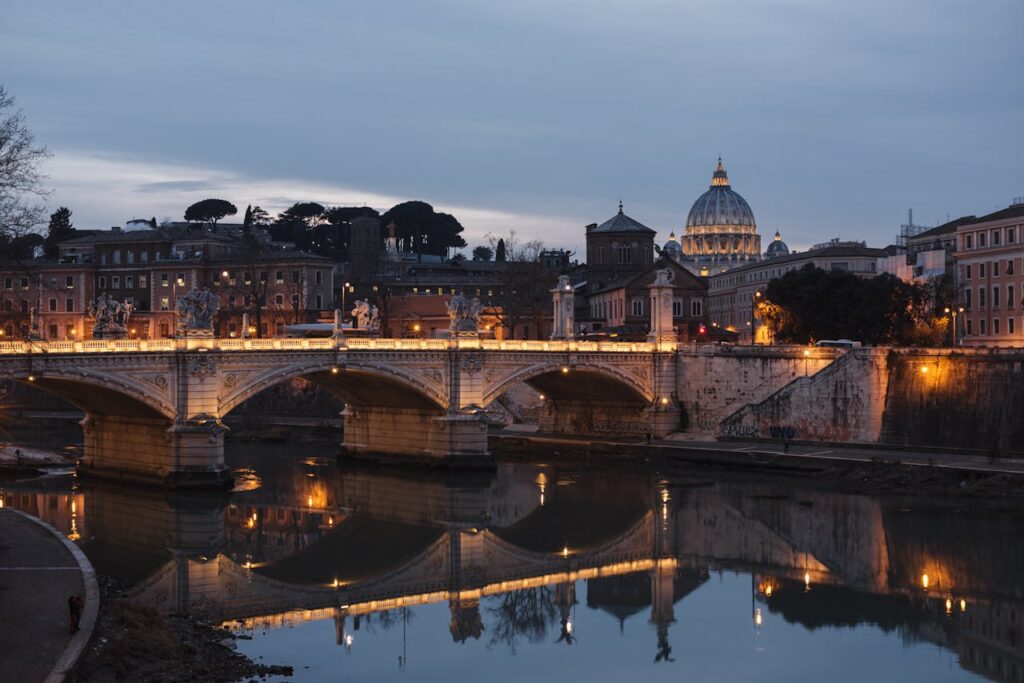
Tips for Sunrise Hikes
– Prepare the Night Before: Pack your gear and prepare snacks and water the night before to ensure a smooth start.
– Use a Headlamp: A headlamp is essential for navigating trails before dawn. Ensure it has fresh batteries (pack some extra!).
– Dress in Layers: Early mornings can be chilly, so dress in layers that you can remove as the day warms up.
Hydration and Nutrition
– Hydrate Beforehand: Drink water before you start your hike to stay hydrated. Use the app Waidy Wow to locate water stops.
– Healthy Snacks: Bring energy-boosting snacks like nuts, fruit, and granola bars to keep your energy levels up.
Sunrise hikes offer a unique and refreshing way to explore Rome’s beautiful trails while avoiding the summer heat. The cool morning air, peaceful surroundings, and stunning views make for an unforgettable hiking experience.
Where can I find more hikes by public transport?
With an abundance of hiking options accessible by train, Rome invites you to embark on an unforgettable adventure with your loved ones. So pack your bags, hop on board the train, and let’s explore the stunning landscapes and natural wonders of Rome together!
Ready to start planning your family hiking adventure? Visit Nature of Sal’s FREE HikeLine Map for more information and inspiration. Let’s make memories that will last a lifetime!
And as always: Stay fit, hike a bit!
Sal
Read more about:

Hiking In The Abruzzo, Lazio and Molise National Park: A Fall Adventure For Expats
Guest Article written by Sal from Nature of Sal October is a wonderful time for expats to explore the Abruzzo, Lazio and Molise National Park (“Parco nazionale d’Abruzzo, Lazio e Molise”, also known as PNALM), located east of Rome. The park, one of three National Parks in Abruzzo, is renowned for its stunning autumn colors, […]

The Best Places to Visit in Italy by Train This Fall
Italy is one of Europe’s most captivating destinations all year round, but fall brings a unique charm that enhances its picturesque landscapes, historic cities, and culinary delights. With cooler temperatures, fewer tourists, and a golden hue that blankets the countryside, autumn is the perfect season to explore the country by train. Thanks to Italy’s extensive […]

Understanding Salaries in Italy: A Guide for Expats and Newcomers
If you’re an expat living in Italy or someone considering relocating, understanding the salary landscape is key to planning your life in the country. This article provides an overview of average salaries in Italy in 2024, how they vary by profession, age, gender, education, and region, as well as how they compare to other European […]

Preparing For Cooler Weather: Fall Hiking Tips For Expats
Guest Article written by Sal from Nature of Sal As summer fades into fall, the cooler weather provides a refreshing change for hikers in Rome. For expats, it’s important to adjust your hiking gear and preparation to enjoy the trails comfortably and safely. Dressing for Fall Hikes – Layering: Start with a moisture-wicking base layer, […]
Learn about the residence permit for digital nomads from non-EU countries working in Italy
Italy’s Investor Visa: A Visa to Attract Strategic Investments from Abroad
Find and Buy Your Ideal Property in Italy with Our Professional Services
Buying Property in Italy – How to Get a Mortgage as a Foreigner
How to Open a Bank Account in Italy as an Expat
Learn Italian and open up new possibilities for your career and personal growth
Prepare for the CILS B1 Citizenship exam to obtain citizenship by marriage, residence or study or work in Italy.
Switching to a self-employment permit from a study or job-seeking one
FAQs for Italian Citizenship by Marriage (2023)
Understanding the Tessera Sanitaria: Your Italian Health Insurance Card
Non-Married Partners: How to Obtain a Residence Permit in Italy as De Facto Cohabitants
How to get tax identification number for foreign citizens (Codice Fiscale)
How to register in Italy as an EU citizen
Mastering Public Transport in Italy
The Advantages of Dual Citizenship with an Italian Passport: Unlocking Boundless Opportunities
What you need to know about Visas and Permits to stay in Italy
Red flags to identify a scam when renting in Italy
Italy, a country renowned for its rich history, exquisite cuisine, and breathtaking landscapes, is also home to countless small towns that offer a more intimate and charming experience compared to the bustling cities. These lesser-known gems, each with a population under 10,000, boast incredible history, culinary delights, and stunning countryside views. This curated list from Travel and Leisure Magazine highlights twelve of the best small towns in Italy, each offering a unique slice of Italian culture and beauty on a smaller scale. From coastal villages to medieval hilltop towns, these destinations promise an unforgettable journey through Italy’s most picturesque locales.
Porto Venere, Liguria
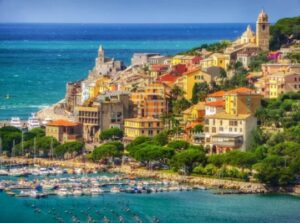
Porto Venere, also known as Portovenere, is a picturesque town located on the Ligurian coast of Italy, in the province of La Spezia. This charming fishing village is renowned for its colorful houses, historic churches, and stunning views of the Mediterranean Sea. Porto Venere, along with the nearby Cinque Terre and the islands of Palmaria, Tino, and Tinetto, is a UNESCO World Heritage Site. The town’s highlights include the Church of St. Peter, perched dramatically on a rocky promontory, and the Doria Castle, which offers panoramic views of the Gulf of Poets. With its blend of natural beauty, rich history, and vibrant culture, Porto Venere is a must-visit destination for anyone exploring the Italian Riviera.
Treia, Marche
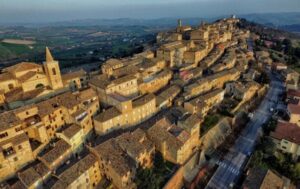
Treia is a picturesque town located in the province of Macerata, in the central region of Marche, Italy. Perched on a hilltop, Treia offers stunning panoramic views of the surrounding countryside and the Potenza river valley. The town is known for its well-preserved medieval architecture, including ancient walls and charming cobblestone streets. Key attractions include the Piazza della Repubblica, which is the heart of the town, and the Teatro Condominiale, a beautifully decorated 19th-century theatre. Treia also boasts a rich cultural heritage, with traditional events like the annual Disfida del Bracciale, a historic ball game. The local cuisine is another highlight, with specialties such as “calcione,” a delicious pastry filled with cheese. Treia’s blend of history, culture, and natural beauty makes it a hidden gem in the Marche region.
Anghiari, Tuscany
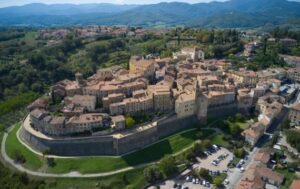
Anghiari is a charming medieval town located in the province of Arezzo, Tuscany. Nestled on a hill overlooking the Tiber River valley, Anghiari is renowned for its well-preserved historic architecture and picturesque streets. The town is famous for the Battle of Anghiari, a significant 1440 conflict between Florence and Milan, which was immortalized in a lost fresco by Leonardo da Vinci. Visitors can explore the ancient city walls, the Palazzo Pretoriano, and the Badia di San Bartolomeo. Anghiari’s narrow, cobblestone streets are lined with stone houses adorned with flowers, creating a beautiful and authentic medieval atmosphere. Recognized as one of the “most beautiful villages in Italy,” Anghiari offers a unique blend of history, culture, and scenic beauty, making it a must-visit destination in Tuscany.
Brisighella, Emilia-Romagna
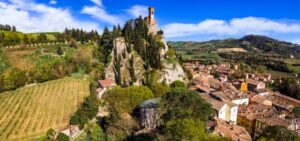
Brisighella, nestled in the picturesque Emilia-Romagna region of Italy, is a charming medieval village renowned for its historical and natural beauty. Located in the Lamone river valley, this enchanting town is framed by the Tuscan-Romagnolo Apennines and is celebrated for its three iconic hills, each crowned with a significant landmark: the Manfredian Fortress, the Clock Tower, and the Monticino Sanctuary. Brisighella’s narrow, winding streets and ancient architecture offer a glimpse into its rich past, while its status as a “Slow City” and a member of the “Most Beautiful Villages of Italy” underscores its commitment to preserving a tranquil and authentic atmosphere. Visitors can enjoy local delicacies such as the prized DOP Extra Virgin Olive Oil and Sangiovese wine, making it a perfect destination for food and wine enthusiasts. Whether exploring its historical sites or savoring its culinary delights, Brisighella promises a memorable and immersive experience.
San Vito Lo Capo, Sicily
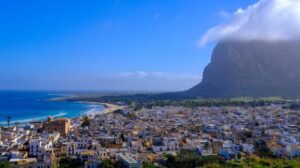
San Vito Lo Capo, located on the northwestern coast of Sicily, is a picturesque coastal town renowned for its stunning white sandy beaches and crystal-clear turquoise waters. Nestled between mountains, this charming town offers a blend of natural beauty and rich cultural heritage. The town’s main beach, Spiaggia San Vito lo Capo, is often hailed as one of the best in Italy, attracting visitors with its pristine sands and vibrant atmosphere. San Vito Lo Capo is also famous for its annual Couscous Fest, celebrating the town’s culinary ties to North Africa. Beyond the beach, visitors can explore historical landmarks such as the 15th-century Santuario de San Vito and enjoy outdoor activities like hiking and climbing in the surrounding mountainous terrain. Whether you’re looking to relax by the sea or immerse yourself in local culture, San Vito Lo Capo offers a delightful escape.
Cortina d’Ampezzo, Veneto
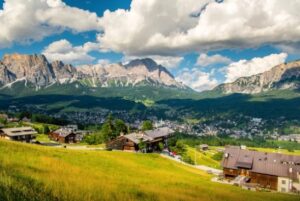
Cortina d’Ampezzo, often referred to as the “Queen of the Dolomites,” is a stunning alpine town located in the Veneto region of Northern Italy. Nestled in the heart of the southern Alps, this picturesque destination is renowned for its breathtaking scenery, world-class skiing trails, and vibrant après-ski scene. Cortina d’Ampezzo gained international fame as the host of the 1956 Winter Olympics and will be a host again for the 2026 Winter Olympics. It continues to attract visitors with its luxurious accommodations, high-end shops, and gourmet dining options. The town is surrounded by majestic peaks such as the Tofane, Cristallo, and Sorapiss, offering a paradise for outdoor enthusiasts year-round. Whether you’re hitting the slopes in winter or exploring the numerous hiking and climbing routes in summer, Cortina d’Ampezzo promises an unforgettable experience in one of Italy’s most beautiful mountain settings.
Tropea, Calabria
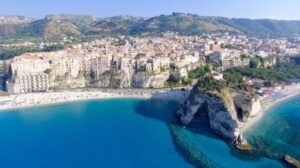
Tropea, often referred to as the “Pearl of the Tyrrhenian Sea,” is a stunning coastal town in Calabria, Italy. Perched on a cliff overlooking the sea, Tropea is renowned for its breathtaking views, crystal-clear waters, and beautiful sandy beaches. The town’s historic center is a maze of narrow streets lined with charming cafes, restaurants, and shops, all set against a backdrop of ancient buildings and churches. One of the most iconic landmarks is the Sanctuary of Santa Maria dell’Isola, a picturesque church situated on a rocky promontory. Tropea is also famous for its sweet red onions, which are celebrated in local cuisine and festivals. Whether you’re exploring its rich history, relaxing on its pristine beaches, or indulging in its culinary delights, Tropea offers a perfect blend of natural beauty and cultural heritage.
Norcia, Umbria
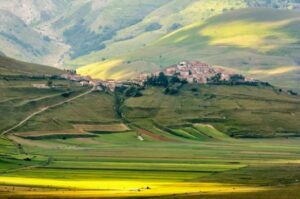
Norcia, a charming town in southeastern Umbria, Italy, is renowned for its rich history and stunning natural surroundings. Nestled in a wide plain near the Monti Sibillini mountain range, Norcia offers breathtaking views and a serene atmosphere. The town is famous for being the birthplace of St. Benedict, the founder of the Benedictine monastic order, and his twin sister, St. Scholastica. Norcia’s medieval architecture, including the Church of Saint Benedict and the Castellina fortress, adds to its historical allure. The town is also celebrated for its culinary delights, particularly its sausages and ham, known as norcineria. Whether you’re interested in history, nature, or gastronomy, Norcia has something to offer every visitor.
Palmanova, Friuli Venezia Giulia
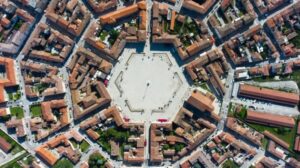
Palmanova, located in the Friuli Venezia Giulia region of Italy, is a unique and fascinating town known for its distinctive star-shaped layout. Founded by the Venetian Republic in 1593, Palmanova was designed as an ideal Renaissance city and military fortress. The town’s nine-pointed star design, complete with ramparts and a surrounding moat, was intended to provide optimal defense against invaders. Today, Palmanova is recognized as a UNESCO World Heritage Site and is celebrated for its well-preserved fortifications and historical significance. Visitors can explore the central Piazza Grande, the impressive city gates, and the various museums that showcase the town’s rich history. Palmanova’s unique architecture and historical charm make it a must-visit destination for history enthusiasts and travelers alike.
Bosa, Sardinia
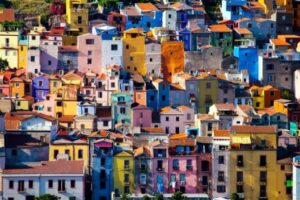
Bosa, a picturesque town on the west coast of Sardinia, Italy, is renowned for its vibrant, pastel-colored houses and rich history. Nestled along the Temo River, Bosa is dominated by the medieval Malaspina Castle, which offers stunning views of the town and surrounding landscape. The town’s charming streets are lined with historic buildings, including the Cathedral of Bosa and several other beautiful churches. Bosa is also known for its traditional crafts, such as leather tanning, and its delicious local cuisine. Whether you’re exploring its historical sites, enjoying the scenic riverfront, or indulging in local delicacies, Bosa offers a unique and memorable experience for visitors.
Otranto, Puglia
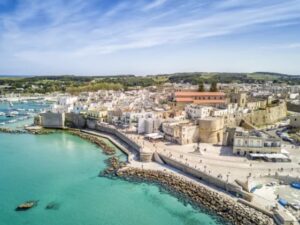
Otranto, a picturesque coastal town in the province of Lecce, Puglia, is renowned for its rich historical and cultural heritage. Located on the Adriatic Sea, it is the easternmost town in Italy and has long been a strategic maritime hub. The town’s historic center, enclosed by ancient defensive walls, is a maze of narrow streets filled with charming old buildings, bars, restaurants, and shops. Key landmarks include the Cathedral of Otranto, featuring an extraordinary 12th-century mosaic floor depicting the Tree of Life, and the imposing Aragonese Castle. Otranto’s beautiful beaches and crystal-clear waters make it a popular destination for tourists seeking both relaxation and a glimpse into Italy’s storied past.
Civita di Bagnoregio, Lazio
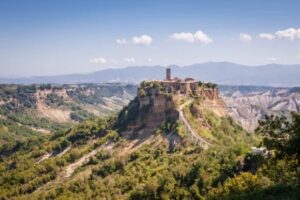
Civita di Bagnoregio, a small village in the Lazio region of Italy, is often referred to as “the dying city” due to its precarious position atop a crumbling tufa hill. Founded by the Etruscans over 2,500 years ago, this enchanting town is accessible only by a pedestrian bridge, adding to its secluded charm. The village’s medieval architecture, narrow streets, and stunning views of the surrounding Valle dei Calanchi create a picturesque and timeless atmosphere. Despite its dwindling population, Civita di Bagnoregio attracts numerous visitors who come to experience its unique beauty and historical significance. The town’s efforts to preserve its heritage have led to its inclusion in the list of “The Most Beautiful Villages of Italy”.
Whether you’re drawn to the coastal allure of Porto Venere, the medieval charm of Anghiari, or the unique architecture of Palmanova, Italy’s small towns offer something for every traveler. Each of these twelve destinations provides a distinctive blend of history, culture, and natural beauty, making them perfect spots to explore and enjoy the authentic Italian experience. As you plan your next trip to Italy, consider venturing off the beaten path to discover these remarkable towns, where timeless beauty and rich traditions await you at every turn.

Hiking In The Abruzzo, Lazio and Molise National Park: A Fall Adventure For Expats
Guest Article written by Sal from Nature of Sal October is a wonderful time for expats to explore the Abruzzo, Lazio and Molise National Park (“Parco nazionale d’Abruzzo, Lazio e Molise”, also known as PNALM), located east of Rome. The park, one of three National Parks in Abruzzo, is renowned for its stunning autumn colors, […]

The Best Places to Visit in Italy by Train This Fall
Italy is one of Europe’s most captivating destinations all year round, but fall brings a unique charm that enhances its picturesque landscapes, historic cities, and culinary delights. With cooler temperatures, fewer tourists, and a golden hue that blankets the countryside, autumn is the perfect season to explore the country by train. Thanks to Italy’s extensive […]

Understanding Salaries in Italy: A Guide for Expats and Newcomers
If you’re an expat living in Italy or someone considering relocating, understanding the salary landscape is key to planning your life in the country. This article provides an overview of average salaries in Italy in 2024, how they vary by profession, age, gender, education, and region, as well as how they compare to other European […]

Preparing For Cooler Weather: Fall Hiking Tips For Expats
Guest Article written by Sal from Nature of Sal As summer fades into fall, the cooler weather provides a refreshing change for hikers in Rome. For expats, it’s important to adjust your hiking gear and preparation to enjoy the trails comfortably and safely. Dressing for Fall Hikes – Layering: Start with a moisture-wicking base layer, […]
Learn about the residence permit for digital nomads from non-EU countries working in Italy
Italy’s Investor Visa: A Visa to Attract Strategic Investments from Abroad
Find and Buy Your Ideal Property in Italy with Our Professional Services
Buying Property in Italy – How to Get a Mortgage as a Foreigner
How to Open a Bank Account in Italy as an Expat
Learn Italian and open up new possibilities for your career and personal growth
Prepare for the CILS B1 Citizenship exam to obtain citizenship by marriage, residence or study or work in Italy.
Switching to a self-employment permit from a study or job-seeking one
Understanding the Tessera Sanitaria: Your Italian Health Insurance Card
Non-Married Partners: How to Obtain a Residence Permit in Italy as De Facto Cohabitants
How to get tax identification number for foreign citizens (Codice Fiscale)
How to register in Italy as an EU citizen
Mastering Public Transport in Italy
The Advantages of Dual Citizenship with an Italian Passport: Unlocking Boundless Opportunities
What you need to know about Visas and Permits to stay in Italy
Red flags to identify a scam when renting in Italy
Optional Regime for Foreign Pensioners – What It Is
Overview
Individuals receiving pension income from foreign sources who transfer their tax residence to Italy can benefit from an optional tax regime. This regime is available to those moving to specific municipalities in Sicily, Calabria, Sardinia, Campania, Basilicata, Abruzzo, Molise, and Puglia, with populations not exceeding 20,000 inhabitants. The regime allows for a substitute tax on personal income tax (Irpef) at a rate of 7% on any category of income produced abroad, valid for nine tax periods (Article 24-ter of the Tuir, introduced by Article 1, paragraph 273, of Law No. 145/2018).
Expansion of Beneficiaries
The Sostegni Ter Decree (Dl 4/2022) has expanded the pool of beneficiaries. Foreign pensioners who transfer their residence to municipalities affected by the L’Aquila earthquake of April 6, 2009, can also benefit. The population limit of 20,000 inhabitants is now extended to all “eligible” municipalities, including those affected by seismic events, previously restricted to a limit of 3,000 inhabitants. This includes areas such as Camerino, Matelica, Tolentino, and Norcia.
Determining Resident Population
The resident population in the municipality is determined using data from the “Annual Municipal Survey of Movement and Population Calculation” (Rilevazione comunale annuale del movimento e calcolo della popolazione) published on the Istat website as of January 1 of the year preceding the first period of validity of the option. This data remains relevant for the entire duration of the option’s validity, provided the taxpayer does not transfer their residence to another municipality.
Option Validity
The option remains effective even if the taxpayer moves to another “eligible” municipality starting from the second period of validity. The population data as of January 1 of the year preceding the transfer of residence is considered.
Finalizing the Option
To finalize the option for the substitute tax regime, the taxpayer must submit the income tax return for the tax period in which the residence is transferred. The option becomes effective from that same year. In the income tax return, the taxpayer must indicate:
∙ Non-resident status in Italy for at least five tax periods preceding the start of the option’s validity.
∙ The jurisdiction with administrative cooperation agreements in the tax sector where the last tax residence was held.
∙ The foreign states for which the substitute tax application is not intended.
∙ The residence state of the foreign entity paying the pension income.
∙ The amount of foreign-sourced income to be subject to the substitute tax.
Tax Payment
The substitute tax on foreign-sourced income, calculated at a flat rate of 7%, must be paid for each tax period of the regime’s validity by the deadline for the balance of income taxes. Payment must be made in a single installment using the F24 form, with the tax code 1899, established by resolution no. 19 of April 21, 2020.
Revocation and Termination
The option can be revoked in one of the tax periods following the one in which the choice was made, by notifying it in the income tax return for the last year of validity. The effects produced in previous tax periods remain valid. The effects of the option do not occur if the legal requirements are not met, or they cease if these requirements are no longer met. The regime also terminates in case of omitted or partial payment of the substitute tax, unless remedied by the deadline for the balance payment for the tax period following the one to which the omission refers (interest and penalties for late payment are still due). Revocation or termination of the regime precludes the exercise of a new option.
Read more:
What is the Elective Residency Visa (ERV)?
The Best Cities to Retire in Italy
12 Captivating Small Towns in Italy with Populations Under 10,000
Learn about the residence permit for digital nomads from non-EU countries working in Italy
Italy’s Investor Visa: A Visa to Attract Strategic Investments from Abroad
Find and Buy Your Ideal Property in Italy with Our Professional Services
Buying Property in Italy – How to Get a Mortgage as a Foreigner
How to Open a Bank Account in Italy as an Expat
Learn Italian and open up new possibilities for your career and personal growth
Prepare for the CILS B1 Citizenship exam to obtain citizenship by marriage, residence or study or work in Italy.
Switching to a self-employment permit from a study or job-seeking one
Understanding the Tessera Sanitaria: Your Italian Health Insurance Card
Non-Married Partners: How to Obtain a Residence Permit in Italy as De Facto Cohabitants
How to get tax identification number for foreign citizens (Codice Fiscale)
How to register in Italy as an EU citizen
Mastering Public Transport in Italy
The Advantages of Dual Citizenship with an Italian Passport: Unlocking Boundless Opportunities
What you need to know about Visas and Permits to stay in Italy
Red flags to identify a scam when renting in Italy
Renowned for its cultural heritage and economic potential, Italy is opening its doors to worldwide investors via the Investor Visa for Italy. This article delves into the intricacies of the Investor Visa, outlining the opportunities it presents and the procedures that accompany it.
Since December 2017, non-EU citizens who intend to invest in strategic assets for the development and competitiveness of the Italian System can apply for a special, biennial visa. This visa features a digital, simple, and fast release procedure.
Law No. 232 of 11 December 2016, known as the “2017 Budget Law,” introduced in the Testo Unico sull’Immigrazione (TUI) a new type of visa. This visa is valid for 2 years and is dedicated to foreign nationals from non-EU countries who intend to make a significant investment or philanthropic donation in strategic assets for the development and competitiveness of the Italian System.
Specifically, the visa may be issued for:
· An investment in government bonds of at least EUR 2 million;
· An investment in an Italian limited company of at least EUR 500,000;
· An investment in an innovative startup (startup innovativa), as defined by DL 179/2012, of at least EUR 250,000;
· A philanthropic donation of at least EUR 1 million in the fields of culture, education, immigration management, scientific research, or the preservation of cultural and landscape assets.
Procedure for Issuing an Investor Visa:
· Entirely Online: The submission of visa applications and all subsequent communications take place through the dedicated portal of the Ministry of Enterprise and Made in Italy.
· Priority: The visa waiver shall be issued within 30 days of the submission of the application.
· Bilingual: The website, application forms, guidelines, and customer care services are available in both Italian and English.
· Centralized: The Secretariat (at the General Department for Industrial Policy) is the single point of contact for the visa applicant and coordinates the inter-institutional Committee deputized for the issuance of the visa waiver.
Regulatory References:
· Testo Unico sull’Immigrazione (Legislative Decree of 25 July 1998, No. 286), Art. 26-bis;
· Decreto Interministeriale MISE-Interno-MAECI of 21 July 2017;
The Investor Visa for Italy serves a dual purpose: it streamlines the process for significant investments to enter the nation and highlights Italy’s dedication to fostering a vibrant and competitive atmosphere. Individuals eager to contribute to Italy’s renowned cultural, educational, and innovative heritage will find their aspirations met. For further assistance or inquiries, contact [email protected], and begin your investment journey to the epicenter of Europe.
Find and Buy Your Ideal Property in Italy with Our Professional Services
Buying Property in Italy – How to Get a Mortgage as a Foreigner
How to Open a Bank Account in Italy as an Expat
Learn Italian and open up new possibilities for your career and personal growth
Prepare for the CILS B1 Citizenship exam to obtain citizenship by marriage, residence or study or work in Italy.
Switching to a self-employment permit from a study or job-seeking one
FAQs for Italian Citizenship by Marriage (2023)
Understanding the Tessera Sanitaria: Your Italian Health Insurance Card
Non-Married Partners: How to Obtain a Residence Permit in Italy as De Facto Cohabitants
How to get tax identification number for foreign citizens (Codice Fiscale)
How to register in Italy as an EU citizen
Mastering Public Transport in Italy
The Advantages of Dual Citizenship with an Italian Passport: Unlocking Boundless Opportunities
What you need to know about Visas and Permits to stay in Italy
Red flags to identify a scam when renting in Italy
Find and Buy Your Ideal Property in Italy with Our Professional Services
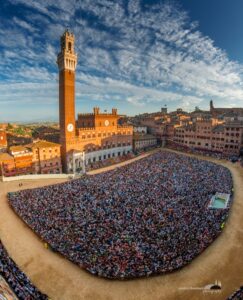 The Palio dell’Assunta in Siena is a historic and vibrant horse race held annually on August 16th. This event, deeply rooted in medieval traditions, takes place in the picturesque Piazza del Campo. It is one of the two Palios held in Siena each year, the other being the Palio di Provenzano on July 2nd.
The Palio dell’Assunta in Siena is a historic and vibrant horse race held annually on August 16th. This event, deeply rooted in medieval traditions, takes place in the picturesque Piazza del Campo. It is one of the two Palios held in Siena each year, the other being the Palio di Provenzano on July 2nd.
What is the Palio dell’Assunta?
The Palio dell’Assunta is more than just a horse race; it is a celebration of Siena’s rich cultural heritage and community spirit. The race features ten of Siena’s seventeen contrade (districts), each represented by a horse and jockey. The event is steeped in tradition, with each contrada having its own unique colors, songs, and rituals.
How it will be celebrated in 2024
The 2024 Palio dell’Assunta will follow the traditional schedule, starting on August 13th with the selection and assignment of horses to the participating contrade. The days leading up to the race are filled with various trials and festivities, including the “prova generale” (general rehearsal) on the evening of August 15th.
On race day, the city of Siena comes alive with excitement. The day begins with a solemn mass at the Duomo, followed by a grand parade featuring participants in medieval costumes. The race itself is a thrilling spectacle, with horses and jockeys racing around the Piazza del Campo, which is transformed into a dirt track.
Events
1. Horse Selection and Assignment: On August 13th, horses are selected and assigned to the contrade in a ceremony that involves much anticipation and excitement, from 12:30 PM to 1:30 PM at Piazza del Campo.
2. Trial Races: From August 13th to 15th, trial races are held to prepare the horses and jockeys for the main event at Piazza del Campo. Morning trials start at 9:00 AM, and evening trials start at 7:15 PM. The access gates to the Piazza close at 8:45 AM for morning trials and at 6:45 PM for evening trials, but it is recommended to be there between 8:30 AM and 8:45 AM and 6:15 PM.
3. Prova Generale: The general rehearsal on the evening of August 15th is a key event where the final preparations are made at Piazza del Campo at 7:15 PM. The access gates to the Piazza close at 6:45 PM.
4. Historical Parade: On race day, a grand parade featuring participants in medieval costumes takes place, adding to the festive atmosphere. The Historical Parade starts from the Prefecture between 3:30 PM and 4:00 PM. The parade route before entering the Piazza is: Courtyard of the Prefecture (Cortile delle Prefettura) – Piazza del Duomo – Via del Capitano – Via S. Pietro – Casato di Sopra – Casato di Sotto.
5. The Race: The main event, the Palio race, is held on August 16th, where the ten contrade compete for victory. It is recommended to enter the Piazza del Campo no later than 3:45 PM. Children under 10 years old are not admitted. The race starts at 7:00 PM.
The Palio dell’Assunta is not just about the race; it is a celebration of community and tradition. The event brings together locals and visitors alike, creating a vibrant and festive atmosphere throughout the city.
*All the events are free.
* Photo by Andrea Bonfanti.
Read more about:
Exploring Italy’s Stunning Beaches by Train: A Guide for Expats
Off the Beaten Path: Unique Things to Do in Italy in Summer.
Italy’s Summer Festivals 2024
Exploring Puglia: From Beaches to Baroque Towns
An 8-Day Tour of the Amalfi Coast
Exploring Italy’s lakes by train
Italy’s Most Enchanting Towns Accessible by Train
Discover Rome’s Beaches Easily Accessible by Public Transportation

Hiking In The Abruzzo, Lazio and Molise National Park: A Fall Adventure For Expats
Guest Article written by Sal from Nature of Sal October is a wonderful time for expats to explore the Abruzzo, Lazio and Molise National Park (“Parco nazionale d’Abruzzo, Lazio e Molise”, also known as PNALM), located east of Rome. The park, one of three National Parks in Abruzzo, is renowned for its stunning autumn colors, […]

The Best Places to Visit in Italy by Train This Fall
Italy is one of Europe’s most captivating destinations all year round, but fall brings a unique charm that enhances its picturesque landscapes, historic cities, and culinary delights. With cooler temperatures, fewer tourists, and a golden hue that blankets the countryside, autumn is the perfect season to explore the country by train. Thanks to Italy’s extensive […]

Understanding Salaries in Italy: A Guide for Expats and Newcomers
If you’re an expat living in Italy or someone considering relocating, understanding the salary landscape is key to planning your life in the country. This article provides an overview of average salaries in Italy in 2024, how they vary by profession, age, gender, education, and region, as well as how they compare to other European […]

Preparing For Cooler Weather: Fall Hiking Tips For Expats
Guest Article written by Sal from Nature of Sal As summer fades into fall, the cooler weather provides a refreshing change for hikers in Rome. For expats, it’s important to adjust your hiking gear and preparation to enjoy the trails comfortably and safely. Dressing for Fall Hikes – Layering: Start with a moisture-wicking base layer, […]
Learn about the residence permit for digital nomads from non-EU countries working in Italy
Italy’s Investor Visa: A Visa to Attract Strategic Investments from Abroad
Find and Buy Your Ideal Property in Italy with Our Professional Services
Buying Property in Italy – How to Get a Mortgage as a Foreigner
How to Open a Bank Account in Italy as an Expat
Learn Italian and open up new possibilities for your career and personal growth
Prepare for the CILS B1 Citizenship exam to obtain citizenship by marriage, residence or study or work in Italy.
Switching to a self-employment permit from a study or job-seeking one
Understanding the Tessera Sanitaria: Your Italian Health Insurance Card
Non-Married Partners: How to Obtain a Residence Permit in Italy as De Facto Cohabitants
How to get tax identification number for foreign citizens (Codice Fiscale)
How to register in Italy as an EU citizen
Mastering Public Transport in Italy
The Advantages of Dual Citizenship with an Italian Passport: Unlocking Boundless Opportunities
What you need to know about Visas and Permits to stay in Italy
Red flags to identify a scam when renting in Italy
Ferragosto, celebrated on August 15th, is a significant public holiday in Italy that marks the height of the summer season. This ancient holiday has deep roots in Roman history and is a time when Italians come together to enjoy festive activities, travel, and communal gatherings. Understanding Ferragosto provides a window into Italian culture, traditions, and the importance of communal celebrations in the country.
Historical Background
The term “Ferragosto” is derived from the Latin phrase “Feriae Augusti,” which means “Festivals of Augustus.” It was introduced by Emperor Augustus in 18 BCE as a period of rest and festivities after the hard work of the harvest. Originally, Ferragosto was a time for workers to take a break, and it was customary for employers to give their workers a bonus during this period. Over the centuries, Ferragosto evolved, incorporating religious significance with the Catholic Feast of the Assumption of the Virgin Mary, which also falls on August 15th.
How is Ferragosto Celebrated?
Ferragosto is synonymous with la dolce vita – the sweet life. Italians traditionally escape the city for the countryside, the coast, or mountain retreats. Family reunions, picnics, and beach days are common themes.
1. Beach and Mountain Escapes: Many Italians head to the coast or the mountains to escape the summer heat. Popular destinations include the Amalfi Coast, Sardinia, and the Dolomites.
2. Festivals and Events: Various towns and cities host festivals, parades, and fireworks. One of the most famous events is the Palio dell’Assunta in Siena, a historic horse race held on August 16th.
3. Family Gatherings and Culinary Traditions: Ferragosto is a day for reuniting with family and friends, often celebrated with picnics and outdoor lunches. Celebrations include sharing special meals and seasonal favorites such as salads, grilled foods, and fresh fruit.
4. Religious Processions: In many parts of Italy, religious processions honor the Assumption of Mary. These processions are often accompanied by music, dancing, and other festivities.
5. Ferragosto Abroad: Besides Italy, Ferragosto is also celebrated in other European countries, such as Spain and Greece, where it is a national holiday. However, customs and traditions can vary from place to place.
Ferragosto is more than just a day off; it is a reflection of Italian values such as family, community, and the enjoyment of life’s simple pleasures. It embodies the Italian spirit of “la dolce vita,” celebrating the beauty of life through food, nature, and togetherness.
In addition, Ferragosto marks a crucial time in the Italian summer calendar. It signals the peak of the holiday season, a time when cities like Rome and Milan may feel quieter as residents head to vacation spots. Conversely, tourist destinations become lively and crowded, showcasing Italy’s stunning landscapes and vibrant culture.
Read more about:
Exploring Italy’s Stunning Beaches by Train: A Guide for Expats
Off the Beaten Path: Unique Things to Do in Italy in Summer.
Italy’s Summer Festivals 2024
Exploring Puglia: From Beaches to Baroque Towns
An 8-Day Tour of the Amalfi Coast
Exploring Italy’s lakes by train
Italy’s Most Enchanting Towns Accessible by Train
Discover Rome’s Beaches Easily Accessible by Public Transportation

Hiking In The Abruzzo, Lazio and Molise National Park: A Fall Adventure For Expats
Guest Article written by Sal from Nature of Sal October is a wonderful time for expats to explore the Abruzzo, Lazio and Molise National Park (“Parco nazionale d’Abruzzo, Lazio e Molise”, also known as PNALM), located east of Rome. The park, one of three National Parks in Abruzzo, is renowned for its stunning autumn colors, […]

The Best Places to Visit in Italy by Train This Fall
Italy is one of Europe’s most captivating destinations all year round, but fall brings a unique charm that enhances its picturesque landscapes, historic cities, and culinary delights. With cooler temperatures, fewer tourists, and a golden hue that blankets the countryside, autumn is the perfect season to explore the country by train. Thanks to Italy’s extensive […]

Understanding Salaries in Italy: A Guide for Expats and Newcomers
If you’re an expat living in Italy or someone considering relocating, understanding the salary landscape is key to planning your life in the country. This article provides an overview of average salaries in Italy in 2024, how they vary by profession, age, gender, education, and region, as well as how they compare to other European […]

Preparing For Cooler Weather: Fall Hiking Tips For Expats
Guest Article written by Sal from Nature of Sal As summer fades into fall, the cooler weather provides a refreshing change for hikers in Rome. For expats, it’s important to adjust your hiking gear and preparation to enjoy the trails comfortably and safely. Dressing for Fall Hikes – Layering: Start with a moisture-wicking base layer, […]
Learn about the residence permit for digital nomads from non-EU countries working in Italy
Italy’s Investor Visa: A Visa to Attract Strategic Investments from Abroad
Find and Buy Your Ideal Property in Italy with Our Professional Services
Buying Property in Italy – How to Get a Mortgage as a Foreigner
How to Open a Bank Account in Italy as an Expat
Learn Italian and open up new possibilities for your career and personal growth
Prepare for the CILS B1 Citizenship exam to obtain citizenship by marriage, residence or study or work in Italy.
Switching to a self-employment permit from a study or job-seeking one
Understanding the Tessera Sanitaria: Your Italian Health Insurance Card
Non-Married Partners: How to Obtain a Residence Permit in Italy as De Facto Cohabitants
How to get tax identification number for foreign citizens (Codice Fiscale)
How to register in Italy as an EU citizen
Mastering Public Transport in Italy
The Advantages of Dual Citizenship with an Italian Passport: Unlocking Boundless Opportunities
What you need to know about Visas and Permits to stay in Italy
Red flags to identify a scam when renting in Italy
Guest Article written by Sal from Nature of Sal
For a refreshing escape from the city heat, expats can explore the picturesque trails of Castel Gandolfo. Nestled in the Alban Hills, this charming town offers stunning views and a serene hiking experience.
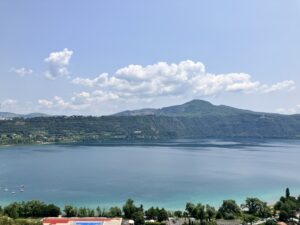
©Photo: Nature of Sal
Discovering Castel Gandolfo
Castel Gandolfo is famous for its papal palace (after all, it’s historically the Pope’s Summer Residence) and beautiful lake, Lago Albano. The area boasts several hiking trails that offer panoramic views of the countryside and the tranquil lake.
The lake, of volcanic origins and 168 meters deep (it’s cone shaped, so it starts shallow and gets deep pretty quickly) is also used for all sorts of water sports, including sailing, kayaking and SUP.
Trail Highlights
– Lake Albano Trail: A scenic path that circles the lake, providing nice views and the opportunity to dip your toes in the cool water.
– Monte Cavo Trail: For those seeking a bit more challenge, the hike up Monte Cavo offers stunning vistas of the Alban Hills and the Tyrrhenian Sea.
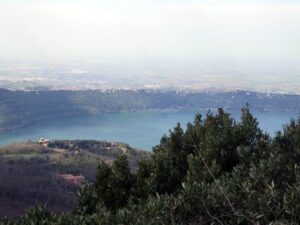
Hiking Tips for Expats
– Sun Protection: Bring a hat, sunglasses, and sunscreen to protect yourself from the strong summer sun.
– Stay Hydrated: Carry enough water and take advantage of the shaded rest areas along the trails.
– Local Delights: After your hike, enjoy a meal at one of the local trattorias, where you can savor traditional Roman cuisine. The entire area is famous for its wines, porchetta and many other delicacies!
– Flora and Fauna The trails around Castel Gandolfo are adorned with vibrant summer blooms and provide habitats for various bird species. Birdwatchers will delight in the chance to spot herons, kingfishers, and other local birds.
A summer hike in Castel Gandolfo offers expats a delightful blend of natural beauty, historical significance, and the refreshing coolness of Lake Albano. It’s an ideal destination for a day trip that combines hiking with relaxation.
Where can I find more hikes by public transport?
With an abundance of hiking options accessible by train, Rome invites you to embark on an unforgettable adventure with your loved ones. So pack your bags, hop on board the train, and let’s explore the stunning landscapes and natural wonders of Rome together!
Ready to start planning your family hiking adventure? Visit Nature of Sal’s FREE HikeLine Map for more information and inspiration. Let’s make memories that will last a lifetime!
And as always: Stay fit, hike a bit!
Sal
Read more about:

Hiking In The Abruzzo, Lazio and Molise National Park: A Fall Adventure For Expats
Guest Article written by Sal from Nature of Sal October is a wonderful time for expats to explore the Abruzzo, Lazio and Molise National Park (“Parco nazionale d’Abruzzo, Lazio e Molise”, also known as PNALM), located east of Rome. The park, one of three National Parks in Abruzzo, is renowned for its stunning autumn colors, […]

The Best Places to Visit in Italy by Train This Fall
Italy is one of Europe’s most captivating destinations all year round, but fall brings a unique charm that enhances its picturesque landscapes, historic cities, and culinary delights. With cooler temperatures, fewer tourists, and a golden hue that blankets the countryside, autumn is the perfect season to explore the country by train. Thanks to Italy’s extensive […]

Understanding Salaries in Italy: A Guide for Expats and Newcomers
If you’re an expat living in Italy or someone considering relocating, understanding the salary landscape is key to planning your life in the country. This article provides an overview of average salaries in Italy in 2024, how they vary by profession, age, gender, education, and region, as well as how they compare to other European […]

Preparing For Cooler Weather: Fall Hiking Tips For Expats
Guest Article written by Sal from Nature of Sal As summer fades into fall, the cooler weather provides a refreshing change for hikers in Rome. For expats, it’s important to adjust your hiking gear and preparation to enjoy the trails comfortably and safely. Dressing for Fall Hikes – Layering: Start with a moisture-wicking base layer, […]
Learn about the residence permit for digital nomads from non-EU countries working in Italy
Italy’s Investor Visa: A Visa to Attract Strategic Investments from Abroad
Find and Buy Your Ideal Property in Italy with Our Professional Services
Buying Property in Italy – How to Get a Mortgage as a Foreigner
How to Open a Bank Account in Italy as an Expat
Learn Italian and open up new possibilities for your career and personal growth
Prepare for the CILS B1 Citizenship exam to obtain citizenship by marriage, residence or study or work in Italy.
Switching to a self-employment permit from a study or job-seeking one
FAQs for Italian Citizenship by Marriage (2023)
Understanding the Tessera Sanitaria: Your Italian Health Insurance Card
Non-Married Partners: How to Obtain a Residence Permit in Italy as De Facto Cohabitants
How to get tax identification number for foreign citizens (Codice Fiscale)
How to register in Italy as an EU citizen
Mastering Public Transport in Italy
The Advantages of Dual Citizenship with an Italian Passport: Unlocking Boundless Opportunities
What you need to know about Visas and Permits to stay in Italy
Red flags to identify a scam when renting in Italy
Before You Leave: Compliance with Regulations
1. Microchip Identification Before relocating, ensure your pet has a microchip that complies with ISO Standard 11784 or Annex A to ISO Standard 11785. If your pet’s microchip does not meet these standards, you may need to bring a compatible reader, contact the EU Port of Entry for assistance, or have a compliant microchip implanted by your veterinarian.
2. Rabies Vaccination Pets must be vaccinated against rabies at least 21 days before departure. Keep in mind that pets younger than 12 weeks old, or between 12 and 16 weeks old who have not waited 21 days after vaccination, are not permitted to travel.
3. Pet Passport or Health Certificate For pets coming from the EU, a European pet passport detailing the pet’s vaccination record, owner’s contact information, and a description of the pet is required. For those coming from non-EU countries, a health certificate from a veterinarian is necessary.
4. Number of Pets Generally, you cannot bring more than five pets. However, exceptions are made for competitions, exhibitions, or sporting events.
Steps to Follow Once You Arrive in Italy
1. Register Your Pet Upon arrival, register your pet with the local ‘Anagrafe degli Animali d’Affezione’. This is mandatory for dogs and recommended for cats in case they get lost.
2. Follow Local Pet Laws Familiarize yourself with local pet laws, such as leash requirements for dogs in public areas and vaccination recommendations beyond rabies.
3. Settle In Find a local veterinarian to continue your pet’s healthcare and update any necessary documentation. Also, explore pet-friendly areas and accommodations to make your pet feel at home.
4. Enjoy Italy with Your Pet Italy is known for being pet-friendly, so take advantage of the many parks, pet shops, and services available for your furry friend.
By following these guidelines and preparing in advance, you and your pet can look forward to a new life in Italy with minimal stress. Welcome to la dolce vita!
Read more:
A Guide to Living in Italy with a Dog
Dog Friendly places in and near Rome
A Guide to Events Happening in Spring in Milan, Rome, Florence, and Bologna
20 Places to Explore in Milan – A Local’s Guide
The Colossal Statue of Constantine: FREE Exhibition at the Capitoline Museums
15 Must-Visit Museums, Galleries, and Cultural Sites in Italy
Don’t Miss the Chance to Visit the Vatican Museums for Free
A Guide to Visiting the Vatican Museums
Italy’s Most Enchanting Towns Accessible by Train
New Celio Archaeological Park in Rome – Free Admission
Find and Buy Your Ideal Property in Italy with Our Professional Services
Buying Property in Italy – How to Get a Mortgage as a Foreigner
How to Open a Bank Account in Italy as an Expat
Learn Italian and open up new possibilities for your career and personal growth
Prepare for the CILS B1 Citizenship exam to obtain citizenship by marriage, residence or study or work in Italy.
Switching to a self-employment permit from a study or job-seeking one
FAQs for Italian Citizenship by Marriage (2023)
Understanding the Tessera Sanitaria: Your Italian Health Insurance Card
Non-Married Partners: How to Obtain a Residence Permit in Italy as De Facto Cohabitants
How to get tax identification number for foreign citizens (Codice Fiscale)
How to register in Italy as an EU citizen
Mastering Public Transport in Italy
The Advantages of Dual Citizenship with an Italian Passport: Unlocking Boundless Opportunities
What you need to know about Visas and Permits to stay in Italy
Red flags to identify a scam when renting in Italy
Residence Permit for Digital Nomads in Italy from Non-EU Countries
Moving to Italy as an expatriate is an exciting adventure, but it comes with a series of essential administrative tasks. One of the first things you’ll need to do is obtain the Carta d’Identità, the national identity card. This document is crucial for various aspects of daily life, including opening a bank account, signing a lease, and accessing healthcare services. To help you through the process, here’s a step-by-step guide to obtaining your Carta d’Identità in Italy.
Step 1: Residence Registration
Before applying for the Carta d’Identità, you must register your residence with the local Anagrafe office. This office is responsible for maintaining the population registry. Bring your passport, visa, and proof of residence (such as a rental contract or utility bill) to complete the registration. Once registered, you will receive a residency certificate, a document you’ll need for subsequent steps.
Step 2: Book an Appointment
Most municipalities in Italy require you to schedule an appointment to apply for the Carta d’Identità. Check the local Anagrafe office or the municipality’s website for information on how to book your appointment. This can often be done online or by phone, and availability may vary depending on the municipality.
Step 3: Gather Required Documents
Before your appointment, ensure you have all the necessary documents. These typically include:
– Passport
– Residency certificate
– Passport-size photos (recent and meeting Italian passport photo standards)
– Any additional documents specified by the local Anagrafe office
Verify that all your documents are valid and up-to-date, as expired documents may lead to delays in the application process.
Step 4: Visit the Anagrafe Office
On the day of your appointment, visit the Anagrafe office at the scheduled time. Submit all the required documents, and be prepared to provide biometric data, such as fingerprints. An officer will verify your information and process your application.
Step 5: Payment of Fees
There is usually a fee associated with obtaining the Carta d’Identità, the amount of which can vary by municipality. Be prepared to pay this fee during your visit. Payment is often made at the local post office, and you’ll receive a payment receipt to present at the Anagrafe office.
Step 6: Wait for Processing
After submitting your application, you’ll need to wait for the Carta d’Identità to be processed. While processing times may vary, it typically takes a few weeks. In the meantime, you may be given a temporary certificate to use.
Step 7: Collect Your Carta d’Identità
Once your Carta d’Identità is ready, you’ll receive a notification to pick it up at the Anagrafe office. Bring the notification, along with any additional documents requested, to collect your card.
By following these step-by-step instructions, you’ll navigate the process of obtaining your Carta d’Identità smoothly and efficiently, ensuring you have the essential document to facilitate your life as an expatriate in Italy.
Don’t forget to check out our Social Media accounts and subscribe to our Newsletter so you can be updated with information customized for people that want to move, live and love Italy!
FAQs for Italian citizenship by Marriage (2023)
Understanding the Tessera Sanitaria: Your Italian Health Insurance Card
Non-Married Partners: How to Obtain a Residence Permit in Italy as De Facto Cohabitants
How to get tax identification number for foreign citizens (Codice Fiscale)
How to register in Italy as a EU citizen
Mastering Public Transport in Italy
The Advantages of Dual Citizenship with an Italian Passport: Unlocking Boundless Opportunities
What you need to know about Visas and Permits to stay in Italy
Guest Article written by Sal from Nature of Sal
As the temperatures soar in July, staying hydrated becomes crucial for hikers in and around Rome. For our community, understanding how to maintain proper hydration is key to enjoying safe and enjoyable hiking adventures.
Hydration Tips for Summer Hikes
– Drink Plenty of Water: Start hydrating before your hike (think days, not hours – in fact, it’s best to also reduce or eliminate alcohol intake on the days before a hike).
– Hydration Packs: These are convenient for sipping water regularly without stopping. A 2–3 liter capacity pack is ideal for longer hikes. While they are convenient, it’s important to look at the quality of such products, especially in terms of materials (durability) and how to clean them (hygiene). A great solution is a water bottle.
– Electrolyte Solutions: Consider bringing electrolyte tablets or sports drinks to replenish salts lost through sweat.
– There are many free water fountains and water stations around Lazio. Did you know that there is a free app that allows you to locate them? It’s called Waidy WOW (I have no idea who comes up with these names), and you can download the free app on this website: https://waidy.it/
– Rest Breaks: Take frequent breaks in shaded areas to cool down and hydrate.
Signs of Dehydration
– Early Symptoms: Thirst, dry mouth, and fatigue are initial signs of dehydration. Address these by drinking water immediately.
– Severe Symptoms: Dizziness, confusion, and rapid heartbeat indicate severe dehydration. In such cases, find shade, hydrate, and seek medical assistance if needed.
Staying hydrated is essential for a safe and enjoyable hiking experience in Rome’s summer heat. By following these tips, expats can ensure they remain well-hydrated and ready to explore the beautiful trails Rome has to offer.
With an abundance of hiking options accessible by train, Rome invites you to embark on an unforgettable adventure with your loved ones. So pack your bags, hop on board the train, and let’s explore the stunning landscapes and natural wonders of Rome together!
Ready to start planning your family hiking adventure? Visit Nature of Sal’s FREE HikeLine Map for more information and inspiration. Let’s make memories that will last a lifetime!
And as always: Stay fit, hike a bit!
Sal
Read more about:

Hiking In The Abruzzo, Lazio and Molise National Park: A Fall Adventure For Expats
Guest Article written by Sal from Nature of Sal October is a wonderful time for expats to explore the Abruzzo, Lazio and Molise National Park (“Parco nazionale d’Abruzzo, Lazio e Molise”, also known as PNALM), located east of Rome. The park, one of three National Parks in Abruzzo, is renowned for its stunning autumn colors, […]

The Best Places to Visit in Italy by Train This Fall
Italy is one of Europe’s most captivating destinations all year round, but fall brings a unique charm that enhances its picturesque landscapes, historic cities, and culinary delights. With cooler temperatures, fewer tourists, and a golden hue that blankets the countryside, autumn is the perfect season to explore the country by train. Thanks to Italy’s extensive […]

Understanding Salaries in Italy: A Guide for Expats and Newcomers
If you’re an expat living in Italy or someone considering relocating, understanding the salary landscape is key to planning your life in the country. This article provides an overview of average salaries in Italy in 2024, how they vary by profession, age, gender, education, and region, as well as how they compare to other European […]

Preparing For Cooler Weather: Fall Hiking Tips For Expats
Guest Article written by Sal from Nature of Sal As summer fades into fall, the cooler weather provides a refreshing change for hikers in Rome. For expats, it’s important to adjust your hiking gear and preparation to enjoy the trails comfortably and safely. Dressing for Fall Hikes – Layering: Start with a moisture-wicking base layer, […]
Learn about the residence permit for digital nomads from non-EU countries working in Italy
Italy’s Investor Visa: A Visa to Attract Strategic Investments from Abroad
Find and Buy Your Ideal Property in Italy with Our Professional Services
Buying Property in Italy – How to Get a Mortgage as a Foreigner
How to Open a Bank Account in Italy as an Expat
Learn Italian and open up new possibilities for your career and personal growth
Prepare for the CILS B1 Citizenship exam to obtain citizenship by marriage, residence or study or work in Italy.
Switching to a self-employment permit from a study or job-seeking one
FAQs for Italian Citizenship by Marriage (2023)
Understanding the Tessera Sanitaria: Your Italian Health Insurance Card
Non-Married Partners: How to Obtain a Residence Permit in Italy as De Facto Cohabitants
How to get tax identification number for foreign citizens (Codice Fiscale)
How to register in Italy as an EU citizen
Mastering Public Transport in Italy
The Advantages of Dual Citizenship with an Italian Passport: Unlocking Boundless Opportunities
What you need to know about Visas and Permits to stay in Italy
Red flags to identify a scam when renting in Italy
The 2025 Jubilee is a significant Holy Year in the Catholic tradition, occurring once every 25 years. Here are the key points:
1. Theme: The official motto for the 2025 Jubilee is “Pilgrims of Hope.” Pope Francis emphasizes hope as a central theme, encouraging believers to experience grace through pilgrimages, indulgences, and living testimonies of faith.
2. Spiritual Significance: During the Jubilee, the Church offers the faithful the opportunity to obtain a plenary indulgence. Traditionally, it begins just before Christmas and ends on the Epiphany of the following year. The Pope inaugurates the Holy Year by opening the Holy Door in St. Peter’s Basilica, followed by other papal basilicas.
▪ A central part of any jubilee is the Holy Doors. These doors, found at St. Peter’s Basilica and Rome’s other major basilicas, are sealed from the inside and only opened during a jubilee year.
3. Preparations in St. Peter’s Basilica:
▪ Cardinal Mauro Gambetti, Archpriest of St. Peter’s Basilica, oversees preparations. The Basilica aims to be a place for ‘pilgrims of hope’—offering spiritual nourishment, reconciliation, and prayer.
▪ Pilgrims from around the world are expected to visit, and plans include simplified access for prayer, sacraments, and guided tours.
▪ The Vatican and the city of Rome are expecting an estimated 35 million visitors during the Jubilee.
What Expats Can Expect:
1. Increased Pilgrims: Rome will see an influx of millions of pilgrims during the Jubilee. Expats should anticipate crowded areas, especially around religious sites.
2. Accommodation Challenges:
▪ Accommodation demand will surge. Expats should book well in advance.
▪ Consider alternative lodging options like short-term rentals or staying slightly outside the city center.
3. Cultural and Spiritual Experiences:
▪ Expats can participate in pilgrimages, attend special Masses, and witness religious ceremonies.
▪ Explore the rich history, art, and architecture of Vatican City.
4. Traffic and Crowds:
▪ Expect increased traffic and longer wait times at popular attractions.
▪ Plan travel accordingly and use public transportation.
▪ The busiest times will probably be the summer, holidays, and the opening and closing of the Holy Door.
5. Local Events and Festivities:
▪ Rome will host various events, concerts, and exhibitions related to the Jubilee.
▪ Keep an eye on local announcements for specific dates and venues.
Recommendations for Foreigners and Expats:
1. Learn About the Jubilee: Familiarize yourself with the significance of the Jubilee and its traditions.
2. Language Skills: Brush up on basic Italian phrases to navigate daily life.
3. Cultural Sensitivity: Respect local customs and religious practices.
4. Explore Beyond Vatican City: Rome has much more to offer—visit historical sites, museums, and local neighborhoods.
5. Stay Informed: Follow official updates on Jubilee events, the Vatican has launched the official Jubilee Calendar website and app. This platform provides daily updates and allows pilgrims to register for Jubilee events and the pilgrimage to the Holy Door, starting in September this year. Additionally, you can find additional information about Jubilee events and materials on the Vatican website or through the United States Conference of Catholic Bishops.
Learn about the residence permit for digital nomads from non-EU countries working in Italy
Italy’s Investor Visa: A Visa to Attract Strategic Investments from Abroad
Find and Buy Your Ideal Property in Italy with Our Professional Services
Buying Property in Italy – How to Get a Mortgage as a Foreigner
How to Open a Bank Account in Italy as an Expat
Learn Italian and open up new possibilities for your career and personal growth
Prepare for the CILS B1 Citizenship exam to obtain citizenship by marriage, residence or study or work in Italy.
Switching to a self-employment permit from a study or job-seeking one
Understanding the Tessera Sanitaria: Your Italian Health Insurance Card
Non-Married Partners: How to Obtain a Residence Permit in Italy as De Facto Cohabitants
How to get tax identification number for foreign citizens (Codice Fiscale)
How to register in Italy as an EU citizen
Mastering Public Transport in Italy
The Advantages of Dual Citizenship with an Italian Passport: Unlocking Boundless Opportunities
What you need to know about Visas and Permits to stay in Italy
Red flags to identify a scam when renting in Italy

Hiking In The Abruzzo, Lazio and Molise National Park: A Fall Adventure For Expats
Guest Article written by Sal from Nature of Sal October is a wonderful time for expats to explore the Abruzzo, Lazio and Molise National Park (“Parco nazionale d’Abruzzo, Lazio e Molise”, also known as PNALM), located east of Rome. The park, one of three National Parks in Abruzzo, is renowned for its stunning autumn colors, […]

The Best Places to Visit in Italy by Train This Fall
Italy is one of Europe’s most captivating destinations all year round, but fall brings a unique charm that enhances its picturesque landscapes, historic cities, and culinary delights. With cooler temperatures, fewer tourists, and a golden hue that blankets the countryside, autumn is the perfect season to explore the country by train. Thanks to Italy’s extensive […]

Understanding Salaries in Italy: A Guide for Expats and Newcomers
If you’re an expat living in Italy or someone considering relocating, understanding the salary landscape is key to planning your life in the country. This article provides an overview of average salaries in Italy in 2024, how they vary by profession, age, gender, education, and region, as well as how they compare to other European […]

Preparing For Cooler Weather: Fall Hiking Tips For Expats
Guest Article written by Sal from Nature of Sal As summer fades into fall, the cooler weather provides a refreshing change for hikers in Rome. For expats, it’s important to adjust your hiking gear and preparation to enjoy the trails comfortably and safely. Dressing for Fall Hikes – Layering: Start with a moisture-wicking base layer, […]
Guest Article written by Sal from Nature of Sal
For expats seeking a refreshing coastal hike this summer, Tor Caldara Nature Reserve offers a perfect blend of beach and woodland scenery. Located just south of Rome in Anzio, this reserve is a hidden gem waiting to be explored.
Exploring Tor Caldara
Tor Caldara Nature Reserve is known for its unique combination of coastal dunes, Mediterranean scrub, and ancient ruins. The reserve features several well-marked trails that take you through diverse landscapes, from sandy beaches to dense forests.
Trail Highlights
– Beach Trail: Start your hike along the sandy shores, where you can enjoy stunning views of the Tyrrhenian Sea. The gentle waves and sea breeze provide a refreshing start to your adventure. The official trail is called “Il Sentiero della Torre”, a trail that is considered Easy (official classification: Turistico).
Hiking Tips
– Pack a Swim Suit: Take advantage of the beautiful beaches and cool off with a swim after your hike (outside of the protected area).
– Bring Snacks and Water: There are no facilities within the reserve, so pack enough provisions to stay hydrated and energized.
– Respect the Environment: As a protected area, it’s important to follow the leave-no-trace principles to preserve the natural beauty of Tor Caldara.
– Note that the reserve is officially open on Thursdays, Saturdays and Sundays, from 9am until 2pm.
– Since the park sometimes hosts special events, or needs to do maintenance work to keep the reserve safe, it’s always best to visit the park’s website and check if they are open.
– If you want to leave your car at home, and you’re up to a 30 minute walk, you can get also get there by train. Note that the way to get to the park on foot, for the most part, lacks a proper pedestrian walkway (especially the last segment), so you should be cautious if choosing this option.
Wildlife Watching
Tor Caldara is home to a variety of wildlife, including migratory birds, reptiles, and small mammals. Keep your binoculars handy for birdwatching and enjoy the diverse ecosystem.
The Tor Caldara Nature Reserve offers expats a unique coastal hiking experience with its beautiful beaches, lush woodlands, and rich biodiversity, and is a rare glimpse into the geological past of Lazio. It’s also an ideal summer destination for those looking to combine hiking with a relaxing day by the sea, and with Anzio right around the corner there are plenty of activities and food choices you have after your hike.
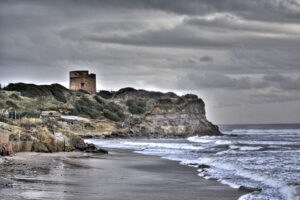
Di Francesco – Regional Natural Reserve of Tor Caldara, Lavinio Lido di Enea (Rome, Italy), CC BY-SA 4.0, https://commons.wikimedia.org/w/index.php?curid=9522083
Where can I find more hikes by public transport?
With an abundance of hiking options accessible by train, Rome invites you to embark on an unforgettable adventure with your loved ones. So pack your bags, hop on board the train, and let’s explore the stunning landscapes and natural wonders of Rome together!
Ready to start planning your family hiking adventure? Visit Nature of Sal’s FREE HikeLine Map for more information and inspiration. Let’s make memories that will last a lifetime!
And as always: Stay fit, hike a bit!
Sal
Read more about:

Hiking In The Abruzzo, Lazio and Molise National Park: A Fall Adventure For Expats
Guest Article written by Sal from Nature of Sal October is a wonderful time for expats to explore the Abruzzo, Lazio and Molise National Park (“Parco nazionale d’Abruzzo, Lazio e Molise”, also known as PNALM), located east of Rome. The park, one of three National Parks in Abruzzo, is renowned for its stunning autumn colors, […]

The Best Places to Visit in Italy by Train This Fall
Italy is one of Europe’s most captivating destinations all year round, but fall brings a unique charm that enhances its picturesque landscapes, historic cities, and culinary delights. With cooler temperatures, fewer tourists, and a golden hue that blankets the countryside, autumn is the perfect season to explore the country by train. Thanks to Italy’s extensive […]

Understanding Salaries in Italy: A Guide for Expats and Newcomers
If you’re an expat living in Italy or someone considering relocating, understanding the salary landscape is key to planning your life in the country. This article provides an overview of average salaries in Italy in 2024, how they vary by profession, age, gender, education, and region, as well as how they compare to other European […]

Preparing For Cooler Weather: Fall Hiking Tips For Expats
Guest Article written by Sal from Nature of Sal As summer fades into fall, the cooler weather provides a refreshing change for hikers in Rome. For expats, it’s important to adjust your hiking gear and preparation to enjoy the trails comfortably and safely. Dressing for Fall Hikes – Layering: Start with a moisture-wicking base layer, […]
Learn about the residence permit for digital nomads from non-EU countries working in Italy
Italy’s Investor Visa: A Visa to Attract Strategic Investments from Abroad
Find and Buy Your Ideal Property in Italy with Our Professional Services
Buying Property in Italy – How to Get a Mortgage as a Foreigner
How to Open a Bank Account in Italy as an Expat
Learn Italian and open up new possibilities for your career and personal growth
Prepare for the CILS B1 Citizenship exam to obtain citizenship by marriage, residence or study or work in Italy.
Switching to a self-employment permit from a study or job-seeking one
FAQs for Italian Citizenship by Marriage (2023)
Understanding the Tessera Sanitaria: Your Italian Health Insurance Card
Non-Married Partners: How to Obtain a Residence Permit in Italy as De Facto Cohabitants
How to get tax identification number for foreign citizens (Codice Fiscale)
How to register in Italy as an EU citizen
Mastering Public Transport in Italy
The Advantages of Dual Citizenship with an Italian Passport: Unlocking Boundless Opportunities
What you need to know about Visas and Permits to stay in Italy
Red flags to identify a scam when renting in Italy
Italy’s coastline is a paradise for beach lovers, offering a variety of beautiful beaches accessible by train. For expats living in Italy, the convenience of train travel opens up a world of coastal adventures without the need for a car. Here’s a guide to some of the most spectacular Italian beaches you can easily reach by train.
Sestri Levante, Liguria
Whether you’re interested in history, outdoor adventures, or simply relaxing by the sea, Sestri Levante offers something for everyone. The town, also known as the City of Two Seas, features two picturesque bays: the Bay of Silence (Baia del Silenzio) and the Bay of Fables (Baia delle Favole), divided by an isthmus that connects the promontory, the oldest part of the village, to the mainland.
Local train Station: Sestri Levante.
Beaches in Sestri Levante
Bay of Silence (Baia del Silenzio)
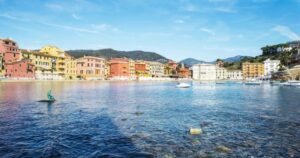
The Bay of Silence is one of the most enchanting places on the Ligurian Riviera. It features crystal-clear water and fine sand, protected to the west by the massive Punta Manara promontory and surrounded by pastel-colored Ligurian houses and historic buildings. This delicate and precious ecosystem hosts vast meadows of posidonia and a wide variety of marine species, earning it the Blue Flag award for its environmental value. Access is regulated to preserve this unique environment, with visitor numbers limited during peak hours (8:00 AM to 5:00 PM).
Rules for Beach Access:
◦ Do not leave personal belongings unattended for more than 30 minutes.
◦ Do not litter.
◦ Do not use detergents.
◦ Do not remove sand, shells, or stones.
◦ Do not bring animals.
The Italian Naval League of Sestri Levante offers canoeing, rowing, and sailing courses for adults and children, focusing on educational activities in local schools.
Contact:
Phone: 0185.44810
Email: [email protected]
The Bay Aquarium, located at Via Portobello 6, features four tanks showcasing common Mediterranean marine life. It is open daily from 8:00 AM to 8:00 PM. For more information, visit or email [email protected].
Bay of Fables (Baia delle Favole)
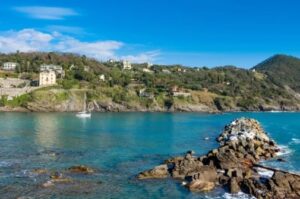
The larger bay, the Bay of Fables, was named by TV presenter Enzo Tortora in the late 1950s. This bay hosts the annual Hans Christian Andersen Bay of Fables Literary Prize, Italy’s most prestigious award for children’s literature, inspired by the Danish writer’s stay in Sestri Levante in 1833.
The bay is surrounded by historical and religious buildings, including the Church of San Nicolò dell’Isola, the Basilica of Santa Maria di Nazareth, the Church of the Immaculate Conception, and the Church of San Pietro in Vincoli. These structures reflect the village’s rich cultural heritage and offer a glimpse into its glorious past.
Sun Beach
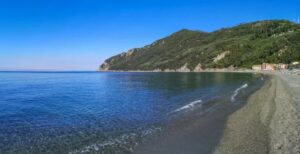
After hiking Punta Manara, take a refreshing dip in the sea at Sun Beach. The hike is of intermediate level and takes approximately 2.45 hours. Begin your journey from Sestri Levante’s city center on Via XXV Aprile, just a 5-minute walk from the railway station. Follow Vico del Bottone towards Punta Manara. Take Salita Mandrella on the left, passing through olive trees and vegetable gardens until you reach Casa Mandrella. From there, enjoy a panoramic stroll with magnificent views.
At Colla Mandrella (113 m), follow the right path through Mediterranean vegetation, including olives, oaks, strawberry trees, and maritime pines. Enjoy a break on a bench with a panoramic view or have a picnic. You can find a bivouac shelter at the “spianata del telegrafo,” where the ruins of an ancient watchtower offer a stunning coastal view.
Continuing on a steep brick stairway, you’ll see landscapes of Portofino and Riva Trigoso. On the return path, descend through Ginestra village and Le Rocche, ending on a recently renovated trail overlooking the beach, popular during the high season.
Taormina, Sicily
Located on the eastern coast of Sicily, Taormina offers mesmerizing views of the Ionian Sea and Mount Etna. The town is situated atop a hill about 250 meters (820 feet) above sea level, with a steep rock crowned by a Norman castle rising even higher, providing a striking and picturesque setting.
Getting to Taormina, Sicily by Train
Most journeys to Taormina involve taking a train that includes a ferry crossing across the Strait of Messina. Your train will arrive at Taormina-Giardini Naxos station, located below Taormina itself. From Taormina-Giardini Naxos station, you can reach Taormina town center (centro) by bus. If you purchase a ticket from Trenitalia to Taormina-centro station, the ticket will cover the entire journey.
Beaches in Taormina:
Giardini Naxos
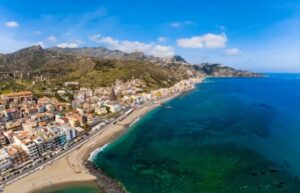
Giardini Naxos is a coastal town known for being the first Greek colony in Sicily, founded around 734 BC. Today, it’s a modern beach resort town with a lively atmosphere, perfect for families and those seeking a mix of relaxation and exploration.
Legend has it that Naxos was founded by Naxos, a sailor from Chalcis in Greece, who landed here after being blown off course. The town quickly prospered due to its strategic location and fertile land. Over the centuries, Naxos was conquered by various civilizations, including the Romans and the Arabs. Today, it offers a glimpse into Sicily’s rich history alongside modern amenities.
Isola Bella:
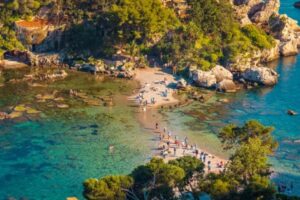
Isola Bella is a small island located just off the coast of Taormina. This fascinating little island is a nature reserve, boasting a lush botanical garden with exotic plants and flowers. The island also features the blue grotto and a small beach.
Isola Bella was once owned by a private family who transformed it into a botanical paradise. The island was acquired by the region in the 1990s and is now open to the public. Legend says that Odysseus, the hero of Homer’s Odyssey, encountered sirens near Isola Bella while sailing past Sicily.
How to Get to Isola Bella in Taormina
◦ Cable Car: The cable car station is located on Via Luigi Pirandello, near the Porta Messina gate (main entrance) of Taormina. The journey takes just a few minutes and offers breathtaking views of the coastline and Isola Bella itself. Tickets can be purchased at the station.
◦ Bus: Another good option is the local bus service. Bus line 25 runs from the center of Taormina to Isola Bella, with a travel time of approximately 15 minutes.
◦ Stroll: If you prefer walking, head through Via Pirandello to the viewing point “Belvedere terrace” and follow the path with steps that lead directly to the entrance of Isola Bella.
Mazzarò:
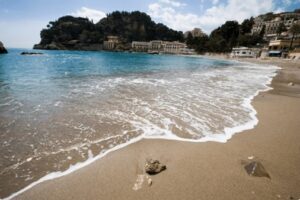
Mazzarò is a small resort area located north of Taormina. This charming spot offers a beautiful beach with crystal-clear waters and stunning views of the coastline. Mazzarò is known for its relaxed atmosphere and selection of upscale hotels and restaurants.
Mazzarò’s name likely comes from the Arabic word “manzil,” meaning “stopping place.” The area has been a popular destination for relaxation and enjoyment for centuries. In the 19th century, Mazzarò began to develop into a fashionable resort town, attracting wealthy travelers from all over Europe.
How to Get to Mazzarò in Taormina
◦ Cable Car: The cable car station is located on Via Luigi Pirandello, near the Porta Messina gate (main entrance) of Taormina. The journey takes just a few minutes and arrives directly at Mazzarò Beach..
◦ Bus: This is a more budget-friendly option, but it takes longer than the cable car. Take the Interbus toward Messina and get off at the “Mazzarò” stop. From there, it’s a short walk downhill to the beach.
◦ Stroll: To reach Mazzarò beach on foot, start from Piazza IX Aprile in Taormina’s historic center. Head south on the bustling Via Pirandello, lined with shops and cafes. After passing Porta Messina, the main gate, continue down the steeper Via Umberto I. Look for signs for the cable car station, but for a scenic and free alternative, take the stairway on your right that leads directly down to the coast.
Baia delle Sirene (Bay of Sirens):
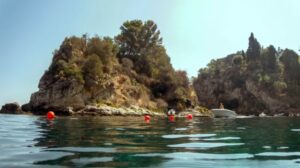
Baia delle Sirene is a small cove located south of Taormina. This secluded beach is known for its calm waters and dramatic rock formations. The name “Bay of Sirens” comes from the Greek myth of the Sirens, enchanting creatures who lured sailors to their deaths with their beautiful songs.
Story: According to Homer’s Odyssey, Odysseus and his crew encountered Sirens while sailing past Sicily. Odysseus had his men plug their ears with beeswax and ordered himself to be tied to the mast to resist the Sirens’ seductive song.
How to Get to Baia delle Sirene in Taormina
◦ Bus: This is the most budget-friendly option. Take the Interbus toward Catania and get off at the “Baia delle Sirene” stop. From there, it’s a short walk to the beach (around 10 minutes).
◦ Stroll: Reaching Baia delle Sirene by foot is a challenging 3-kilometer trek with steep inclines, so it’s not for everyone. But if you’re feeling adventurous, follow the route suggested for Mazzarò beach: start at Piazza IX Aprile, head south on Via Pirandello and Via Umberto I, passing Porta Messina. After the cable car station area, continue down the main road instead of turning off. The incline gets steeper, but eventually you’ll arrive in Baia delle Sirene.
Alternative Activities in Taormina:
◦ Explore the Ancient Theatre: Visit the Taormina Greek Theater, an ancient amphitheater with stunning views.
◦ Mount Etna Volcano: Experience an off-road Jeep tour or hike around majestic Mount Etna.
◦ Alcantara Gorge: Hike, swim, or raft through this unique natural formation.
◦ Aeolian Islands: Hop around these beautiful islands from Taormina.
◦ Taormina Castle: Admire the ancient castle and its history.
Rimini, Emilia-Romagna
Rimini, a vibrant city on the Adriatic Coast, is a popular summer destination for a reason. With its long stretches of sandy beaches, historical sites, and lively atmosphere, Rimini offers something for everyone.
Local train Station: Rimini.
Beaches in Rimini:
Rimini boasts 15 kilometers of sandy beaches, perfect for soaking up the sun and enjoying the Adriatic Sea. Here are a few popular beaches you can explore:
Marina Centro
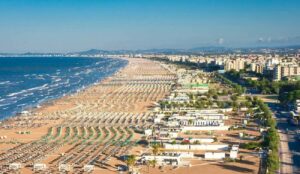
Photo from Hotel Quisisana
The main beach of Rimini, Marina Centro offers a lively atmosphere with numerous beach establishments (stabilimenti balneari) that rent sun loungers, umbrellas, and water sports equipment.
Rimini Bellariva
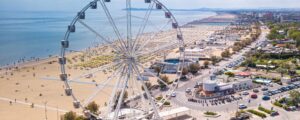
Photo from casevacanza.it
North of Marina Centro, Bellariva offers a more relaxed atmosphere with wide, sandy beaches. Here you’ll find families and couples seeking a quieter experience.
Rimini Viserba
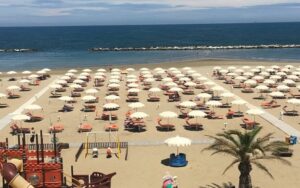
Photo from trovaspiagge.it
South of Marina Centro, Viserba is another popular beach area with a mix of free public beaches and private beach establishments. Viserba is also known for its nightlife options.
Alternative Activities in Rimini:
◦ Explore the historic center: Rimini has a rich history, evident in its Roman amphitheater, the majestic Tempio Malatestiano church, and the Tiberius Bridge, dating back to the 1st century AD.
◦ Immerse yourself in art and culture: Visit the Museo della Città (City Museum) to learn about Rimini’s history, or explore the beautiful Fellini Park dedicated to the famous Italian filmmaker Federico Fellini.
◦ Day trips to nearby towns: Take a day trip to charming towns like San Marino, a tiny independent republic nestled in the hills, or Ravenna, known for its Byzantine mosaics.
◦ Indulge in delicious food: Rimini offers a fantastic culinary scene. Savor fresh seafood dishes, savor the local Piadina flatbread, or enjoy a traditional pasta meal.
Viareggio, Tuscany
Viareggio, a coastal gem in Tuscany, beckons travelers with its sandy shores, charming atmosphere, and rich artistic heritage.
Local train Station: Viareggio.
Beaches in Viareggio
Viareggio boasts a long stretch of golden sand, perfect for sunbathing, swimming, and enjoying water sports. Here are some popular beaches to explore:
Marina di Viareggio:
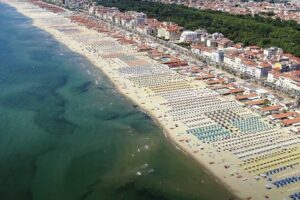
Photo from itbeach.it
The main beach of Viareggio, Marina di Viareggio offers a lively atmosphere with numerous stabilimenti balneari (beach establishments) renting sun loungers, umbrellas, and water sports equipment.
Spiaggia della Lecciona:
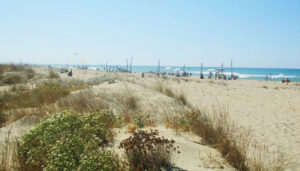
Photo from initalia.virgilio.it
South of Viareggio, Spiaggia della Lecciona offers a more secluded and natural beach experience. This beach is known for its free public access and calmer waters.
Parco Naturale Migliarino San Rossore Massaciuccoli:
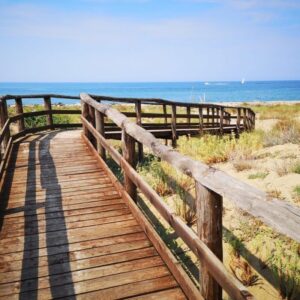
Photo from parchiaperti.it
For nature lovers, explore the northern part of Viareggio’s coast. This protected area features a beautiful beach backed by pine forests, offering a unique blend of sun and nature.
Santa Margherita Ligure, Liguria
Nestled on the Italian Riviera, Santa Margherita Ligure offers stunning coastal beauty, charming streets, and a relaxed atmosphere.
Local train Station: Santa Margherita Ligure-Portofino.
Beaches in Santa Margherita:
Baia di Paraggi:
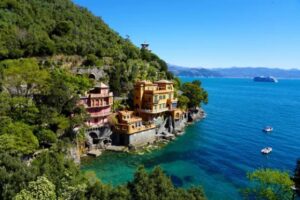
Nestled just south of Portofino, Baia di Paraggi offers a captivating escape. This bay boasts crystal-clear waters ideal for swimming, a mix of public and private beaches for relaxation, and charming marinas. Explore the surrounding beauty on scenic walks, rent water equipment for an active adventure, or savor fresh seafood at waterfront restaurants.
To get to Paraggi Beach, start from the center of Santa Margherita Ligure and take the Provincial Road 227 towards Portofino. This is the only drivable link between the two towns. The road stretches for 4 km, carved into the Portofino promontory and hugging the coastline’s natural curves. For the best views, travel by bicycle, motorcycle, or walk along the pedestrian path. You’ll pass the distinctive Scoglio della Carega (or Sedia), enjoy the vistas of Punta Faro, and see the Castello di Paraggi before reaching the beaches of Paraggi or Niasca for a refreshing swim.
Spiaggia Minaglia:
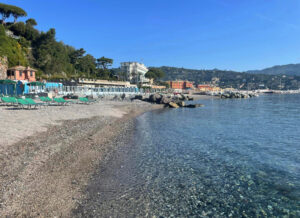
This historic beach establishment in Santa Margherita Ligure is equipped with umbrellas and sunbeds, offering customers the rental of deck chairs, pedal boats, and canoes. The establishment also features a bar with light dining options. From the municipality of Santa Margherita Ligure, the beach can be easily reached on foot or by bicycle, as it is close to the port and the Santa Margherita Ligure monument.
Alternative Activities in Santa Margherita:
◦ Explore the charming town: Wander through the narrow streets lined with pastel-colored houses, discover local shops and cafes, and soak up the laid-back atmosphere.
◦ Hike the Portofino Peninsula: Lace up your hiking boots and explore the stunning trails of the Portofino Peninsula. Breathtaking views and hidden coves await.
◦ Day trip to Portofino: Take a boat tour or ferry to the exclusive village of Portofino, known for its colorful harbor, upscale boutiques, and luxurious atmosphere.
◦ Boat tour along the coast: Embark on a boat tour and admire the stunning coastline, with its hidden coves, charming villages, and dramatic cliffs.
Monterosso al Mare, Liguria
Monterosso al Mare, nestled within the Cinque Terre National Park, is a charming coastal village known for its stunning beauty, colorful houses, and relaxed atmosphere.
Local train Station: Monterosso al Mare.
Beaches in Monterosso al Mare:
Unlike the other Cinque Terre villages, Monterosso boasts a beautiful and spacious beach, perfect for sunbathing, swimming, and enjoying water sports.
Fegina Beach:
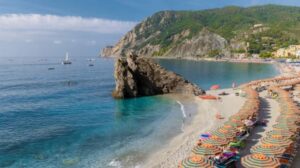
This long stretch of golden sand is the main beach of Monterosso. It offers both free public areas and private stabilimenti balneari (beach establishments) renting sun loungers and umbrellas. The beach also features a charming seaside promenade lined with shops and restaurants.
Alternative Activities in Monterosso al Mare:
◦ Explore the historic center: Wander through the narrow streets lined with colorful houses, discover local shops and cafes, and soak up the village’s charming atmosphere.
◦ Hike the Cinque Terre trails: Lace up your hiking boots and explore the stunning trails that connect Monterosso to the other villages of Cinque Terre. These cliffside paths offer breathtaking views of the coastline.
◦ Boat tour: Embark on a boat tour and admire the Cinque Terre villages from a different perspective. You can also access hidden coves and secluded beaches only reachable by water.
◦ Visit the Church of San Francesco: This 17th-century church houses a beautiful crucifix by the renowned Flemish painter Van Dyck.
Cefalù, Sicily
Cefalù, nestled on the northern coast of Sicily, captivates visitors with its medieval charm, golden beaches, and stunning views of the Tyrrhenian Sea. The iconic Norman Cathedral, perched atop a rocky promontory, adds to the town’s allure.
Local train Station: Cefalù.
Beaches in Cefalù
Spiaggia di Settefrati, also known as Baia dei sette emiri:
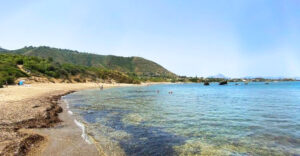
Photo from balarm.it
A picturesque beach renowned for its breathtaking panoramic beauty. The bay is encircled by lush greenery and dotted with small, rugged coves. Numerous rocky formations emerge from the sea, including both low, walkable rocks and impressive faraglioni (sea stacks). The crystal-clear, transparent waters teem with a rich variety of fish, making it an ideal spot for snorkeling and enjoying the serene natural environment. This idyllic setting offers a perfect escape for nature lovers and beachgoers alike.
Spiaggia di Cefalù:
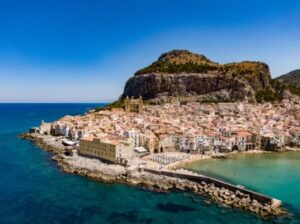
This is the main beach in Cefalù, located right in front of the town’s historic center. It’s known for its golden sand, clear blue waters, and convenient amenities such as beach clubs, restaurants, and bars. The backdrop of the town’s medieval architecture and the towering La Rocca add to its charm, making it a perfect spot for both relaxation and sightseeing.
Caldura Beach:
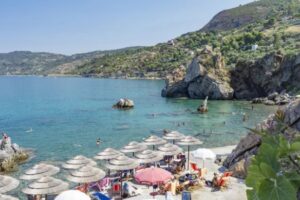
Located a short distance from the center of Cefalù, Caldura Beach is a bit more secluded and tranquil. This pebbly beach is surrounded by rocky cliffs and lush vegetation, offering stunning views and a more intimate atmosphere. It’s ideal for those looking to escape the crowds and enjoy some peaceful sunbathing or snorkeling.
Alternative Activities in Cefalù
◦ Hike to La Rocca: Head up to La Rocca for stunning views over the sea. The hike is rewarding, and the panoramic vistas are worth the effort.
◦ Wine Tasting in Madonie Mountains: Join a wine tasting tour in the Madonie Mountains. Sicily is known for its excellent wines, and this experience allows you to savor local flavors.
◦ Sail the Seas: Consider a four-hour sailing tour to explore the coastline from a different perspective.
◦ Hike Etna: For adventure seekers, hiking up the active volcano Mount Etna is an unforgettable experience.
Camogli, Liguria
Located on the western side of the Portofino peninsula in Liguria, Camogli charms visitors with its vivid, multicolored houses. The picturesque landscape is further enhanced by the remnants of a medieval castle. The 12th-century Basilica of Santa Maria Assunta, situated on an ancient rock-island, once stood at the core of the village’s political and religious life. The combination of the sea, beach, and colorful buildings makes Camogli a captivating coastal destination.
Local train Station: Camogli-S. Fruttuoso.
Beaches in Camogli
Camogli Beach:
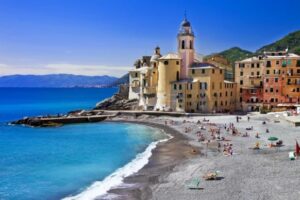
Camogli Beach is an ideal spot for leisurely sunbathing and unwinding. Visitors can relax on the golden sands and take a dip in the clear waters, which are perfect for swimming and snorkeling. Along the beach, a charming promenade is lined with inviting cafes, gelato shops, and seafood restaurants, offering plenty of options for refreshments and meals. The beach is beautifully framed by the iconic pastel-colored houses that overlook the shoreline, adding to the picturesque and relaxing atmosphere of this coastal gem.
San Fruttuoso:
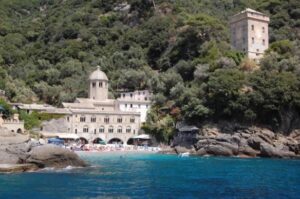
San Fruttuoso is a picturesque beach located in the charming fishing village of San Fruttuoso, nestled between Camogli and Portofino. Accessible only by foot or sea, its lush greenery, crystal-clear waters, and the medieval San Fruttuoso Abbey create a magical atmosphere. Divers are drawn to this spot for the “Christ of the Abyss” statue, which has been submerged since 1954 to honor scuba pioneer Dario Gonzatti. This underwater sculpture adds to the beach’s allure. The white sand beach, framed by steep cliffs, provides shelter from strong winds, making it an ideal spot for sunbathing, swimming, and snorkeling.
Punta Chiappa Beach:
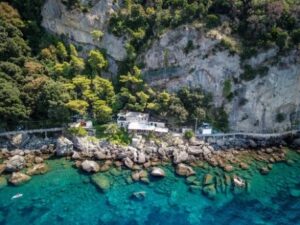
Located within the Portofino Regional Natural Park and the municipality of Camogli, offers a serene and relaxing escape in a pristine coastal area. You can reach Punta Chiappa on foot along a trail in the Portofino Natural Park or by sea. The path begins at a small dead-end road off Viale Cuneo, directly opposite the Carabinieri barracks. This is Via San Bartolomeo, a mule track that ascends into the interior, initially following the course of the Gentile stream. The walking time is approximately 30 to 60 minutes at a regular pace.
Alternative Activities in Camogli
◦ Explore the Medieval Past: Discover the remnants of the once-powerful medieval castle that stood guard over the village. Unveil the history of the 12th-century Basilica of Santa Maria Assunta, a former heart of the town’s religious and political life.
◦ Boat Tours and Kayaking: Take in the stunning coastline from a different perspective. Embark on a boat tour or rent a kayak to explore hidden coves, secluded beaches, and the dramatic rock formations along the shore.
◦ Festivals and Events: Time your visit to coincide with a local festival. The “Sagra del Pesce” (Fish Festival) held on the second Sunday of May is a must for seafood lovers, offering a chance to experience the town’s vibrant traditions and culinary heritage.
Whether you’re an expat or a traveler, these destinations provide a perfect blend of relaxation, culture, and natural beauty, all accessible without the need for a car. What other beaches would you add to this list? Share your favorite coastal spots and let us know why they deserve a visit!
Read more about:
Off the Beaten Path: Unique Things to Do in Italy in Summer.
Italy’s Summer Festivals 2024
Exploring Puglia: From Beaches to Baroque Towns
An 8-Day Tour of the Amalfi Coast
Exploring Italy’s lakes by train
Italy’s Most Enchanting Towns Accessible by Train
Discover Rome’s Beaches Easily Accessible by Public Transportation

Hiking In The Abruzzo, Lazio and Molise National Park: A Fall Adventure For Expats
Guest Article written by Sal from Nature of Sal October is a wonderful time for expats to explore the Abruzzo, Lazio and Molise National Park (“Parco nazionale d’Abruzzo, Lazio e Molise”, also known as PNALM), located east of Rome. The park, one of three National Parks in Abruzzo, is renowned for its stunning autumn colors, […]

The Best Places to Visit in Italy by Train This Fall
Italy is one of Europe’s most captivating destinations all year round, but fall brings a unique charm that enhances its picturesque landscapes, historic cities, and culinary delights. With cooler temperatures, fewer tourists, and a golden hue that blankets the countryside, autumn is the perfect season to explore the country by train. Thanks to Italy’s extensive […]

Understanding Salaries in Italy: A Guide for Expats and Newcomers
If you’re an expat living in Italy or someone considering relocating, understanding the salary landscape is key to planning your life in the country. This article provides an overview of average salaries in Italy in 2024, how they vary by profession, age, gender, education, and region, as well as how they compare to other European […]

Preparing For Cooler Weather: Fall Hiking Tips For Expats
Guest Article written by Sal from Nature of Sal As summer fades into fall, the cooler weather provides a refreshing change for hikers in Rome. For expats, it’s important to adjust your hiking gear and preparation to enjoy the trails comfortably and safely. Dressing for Fall Hikes – Layering: Start with a moisture-wicking base layer, […]
Learn about the residence permit for digital nomads from non-EU countries working in Italy
Italy’s Investor Visa: A Visa to Attract Strategic Investments from Abroad
Find and Buy Your Ideal Property in Italy with Our Professional Services
Buying Property in Italy – How to Get a Mortgage as a Foreigner
How to Open a Bank Account in Italy as an Expat
Learn Italian and open up new possibilities for your career and personal growth
Prepare for the CILS B1 Citizenship exam to obtain citizenship by marriage, residence or study or work in Italy.
Switching to a self-employment permit from a study or job-seeking one
FAQs for Italian Citizenship by Marriage (2023)
Understanding the Tessera Sanitaria: Your Italian Health Insurance Card
Non-Married Partners: How to Obtain a Residence Permit in Italy as De Facto Cohabitants
How to get tax identification number for foreign citizens (Codice Fiscale)
How to register in Italy as an EU citizen
Mastering Public Transport in Italy
The Advantages of Dual Citizenship with an Italian Passport: Unlocking Boundless Opportunities
What you need to know about Visas and Permits to stay in Italy
Red flags to identify a scam when renting in Italy
Our founder, Patrizia Di Gregorio, brings 23 years of experience assisting expats in Italy to adapt to various aspects of life, including immigration, work, learning Italian, accommodation, networking, and making friends. Her expertise led to an interview with Business Insider, where she shared insights on three common mistakes American expats should avoid when relocating to Italy.
Read more here.
Our Blog:
15 Must-Visit Museums, Galleries, and Cultural Sites in Italy
Don’t Miss the Chance to Visit the Vatican Museums for Free
A Guide to Visiting the Vatican Museums
Italy’s Most Enchanting Towns Accessible by Train
New Celio Archaeological Park in Rome – Free Admission
The Colossal Statue of Constantine: FREE Exhibition at the Capitoline Museums
Learn Italian and open up new possibilities for your career and personal growth
Prepare for the CILS B1 Citizenship exam to obtain citizenship by marriage, residence or study or work in Italy.
Switching to a self-employment permit from a study or job-seeking one
FAQs for Italian Citizenship by Marriage (2023)
Understanding the Tessera Sanitaria: Your Italian Health Insurance Card
Non-Married Partners: How to Obtain a Residence Permit in Italy as De Facto Cohabitants
How to get tax identification number for foreign citizens (Codice Fiscale)
How to register in Italy as an EU citizen
Mastering Public Transport in Italy
The Advantages of Dual Citizenship with an Italian Passport: Unlocking Boundless Opportunities
What you need to know about Visas and Permits to stay in Italy
Red flags to identify a scam when renting in Italy
Italy’s summer charm extends far beyond its famous cities and popular tourist routes. For those in search of distinctive experiences, the country boasts a treasure trove of off-the-beaten-path destinations that enchant with their natural splendor, deep-rooted history, and cultural significance. Let’s explore a few of these destinations:
Visit the Aosta Valley
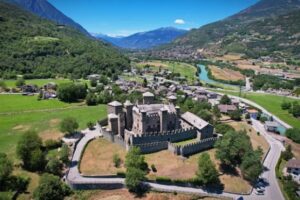
Fenis Castle in Aosta Valley
The Aosta Valley, nestled in the Italian Alps, offers a unique summer experience beyond the typical tourist spots. Here are some activities to explore:
Aosta Old Town offers a captivating journey through history, showcasing well-preserved Roman ruins, including a Roman Theater (closed until May 2025), the ancient Arco d’Augusta, and Roman walls alongside medieval towers. Be sure not to overlook the Cathedral of Santa Maria Assunta, a splendid example of Romanesque architecture. Its intricate facade, adorned with sculptures and decorative elements, captivates visitors from around the world, while inside, the cathedral boasts a harmonious blend of medieval frescoes and intricate wooden carvings.
Castles: Explore nearby castles like Château St. Pierre and Château Sarriod de la Tour. The Fenis Castle, known for its medieval architecture, is also worth a visit.
Hiking: Discover hiking trails in the Parco Nazionale del Gran Paradiso, offering options for all levels. For breathtaking views, take a short walk near Courmayeur to see the Italian side of Mont Blanc.
Mountain Biking: With over 1000 km of country roads, mule tracks, and wooded paths, Aosta Valley is a paradise for mountain bikers. Pila and La Thuile even offer summer downhill biking.
Balloon Rides and Paragliding: Soar above the mountains, gazing at the stunning scenery. Witnessing paragliders descend into the valley is a memorable sight.
Discover the Ghost Town of Craco
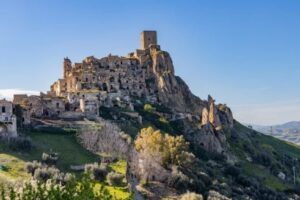
Craco, Basilicata
Craco, an abandoned medieval village in Basilicata, offers a hauntingly beautiful glimpse into Italy’s past. The town was evacuated in the 1960s due to landslides, leaving behind a perfectly preserved ghost town. Here are some things to do there:
Rugged Landscape: Craco sits atop a steep 400 m cliff, creating a striking appearance where buildings blend seamlessly with the mountain. The vast open stretches of calanchi (badlands) add to the surreal atmosphere, devoid of vegetation or habitation.
Guided Tours: While the town itself is locked behind a fence, you can take a guided tour to wander through the eerie, deserted streets and buildings while learning about the town’s history and legends.
Film Location: Craco has become a popular filming location for historic movies. You might recognize it from films like ‘The Passion of the Christ,’ ‘King David,’ and ‘Quantum of Solace’.
Hike the Path of the Gods (Sentiero degli Dei), Amalfi Coast
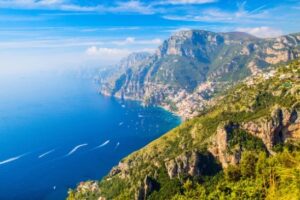
Path of the Gods in Amalfi coast
While the Amalfi Coast is a popular destination, hiking the Path of the Gods offers a unique way to experience its stunning beauty away from the crowds. This trail, stretching from Bomerano to Nocelle, provides breathtaking views of the coastline, charming villages, and the Mediterranean Sea. The hike is moderately challenging but rewards trekkers with some of the most spectacular scenery in Italy.
Visit the Sunken City of Baia, Campania
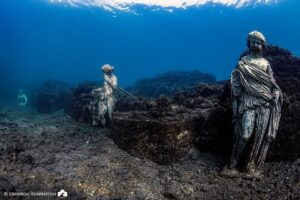
Photo from subaia.com taken by Claudio’s Nymphaeum
Baia, an ancient Roman city submerged under the waters of the Gulf of Naples, offers a fascinating underwater archaeological site. You can explore the ruins of villas, mosaics, and statues by taking a guided snorkeling or diving tour. This unique underwater adventure provides a glimpse into the opulent lifestyle of ancient Rome.
Explore the Parco dei Mostri (Park of the Monsters), Lazio
The Parco dei Mostri, also known as the Sacro Bosco (Sacred Grove), is a captivating and mysterious place in Lazio. Located just 1.5 kilometers from the charming village of Bomarzo, this unique park is home to majestic and bizarre statues that exude both eerie allure and visual impact.
Here are some intriguing details about the Parco dei Mostri:
Creation: The garden was commissioned during the 16th century by Prince Pier Francesco Orsini.
Symbolism: The sculptures within the park evoke an initiatory journey, representing stages the soul must undergo to ascend toward knowledge and truth.
Entrance Sphinges: Two sphinxes guard the entrance, their inscription urging visitors to discern whether the wonders they encounter are products of deception or art.
Ercole and Caco: Further along the path, you’ll encounter an imposing figure—a giant (possibly Hercules) tearing apart his victim (Cacus). This scene symbolizes the soul’s torn state as it embarks on the path to enlightenment.
Visiting Information: The Parco dei Mostri is open year-round from March to September: 9:00 am to 7:00 pm. the Ticket Prices for Adults and children aged 13 and over is €13 and for Children aged 4 to 13 years old is €8.
Hike Through the Dolomites’ Technicolor Mountains
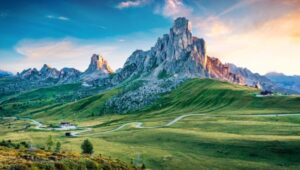
Cortina d’Ampezzo, South Tyrol
The Dolomites, often referred to as the “Technicolor Mountains,” are renowned for their dramatic peaks, sheer cliffs, and stunning rock formations, these mountains are part of the Southern Limestone Alps. What sets the Dolomites apart is their unique mineral composition, which gives rise to a spectacular array of colors, particularly during sunrise and sunset. The mountains’ vivid hues, ranging from deep reds and purples to soft pinks and oranges, create a breathtaking natural spectacle that attracts photographers, hikers, and nature enthusiasts from around the world. Recognized as a UNESCO World Heritage Site, the Dolomites offer a rich blend of natural beauty, geological significance, and outdoor adventure.
Go Spelunking in Sardinia’s Grotta di Nettuno
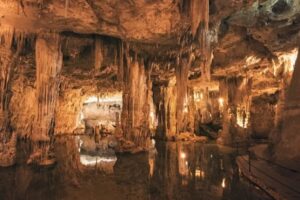
Inside the Cave of Neptune
Exploring Neptune’s Grotto (Grotte di Nettuno) in Sardinia is a captivating adventure that offers a unique glimpse into the island’s natural beauty and history. Located near Alghero, this stunning cave complex was discovered by a fisherman in the 1700s, though ancient populations likely visited it much earlier. The grotto extends about 4 km, but only a few hundred meters are accessible to the public. Visitors can reach the grotto either by boat or by descending a stunning 654-step staircase from the top of the 110m-high Capo Caccia cliff. Inside, the guided tour, lasting over an hour, showcases impressive stalactites and stalagmites in chambers such as the Ruins and the majestic Royal Palace, along with Lake Lamarmora, one of Europe’s largest salt lakes. Nearby, Capo Caccia hosts other lesser-known caves like Grotta dei Pizzi e Ricami, Grotta di Nereo, and Grotta Verde, which contains Neolithic paintings. When visiting, stay hydrated, wear a hat during hot summer days, and consider taking a boat tour for a different perspective on the stunning panorama.
Discover the Enchanting Aeolian Islands
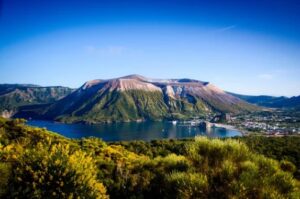
Vulcano island
Exploring the Aeolian Islands, also known as the Lipari Islands, reveals a captivating volcanic archipelago in the Tyrrhenian Sea, just north of Sicily. Named after Aeolus, the mythical ruler of the winds, these islands offer an off-the-beaten-path experience rich in natural beauty and adventure.
There are seven significant islands:
– Lipari: The largest island, known for its charming old town and archaeological sites.
– Vulcano: Famous for its therapeutic mud baths and steaming fumaroles.
– Salina: Home to lush vineyards and stunning vistas.
– Stromboli: An active volcano where you can witness fiery eruptions.
– Filicudi and Alicudi: Remote and tranquil, perfect for escaping the crowds.
– Panarea: The smallest, with chic boutiques and crystal-clear waters.
Accessible by ferries from Milazzo, the crystal-clear waters are perfect for swimming, snorkeling, and diving. Notable beaches include Spiaggia Bianca on Lipari and Gelso Beach on Vulcano. Local cuisine features fresh seafood, capers, and Malvasia wine, with sweet treats like cannoli and granita. Watching the sunset from Stromboli or Panarea is a breathtaking experience, and the islands’ unspoiled charm—with hidden coves, ancient ruins, and picturesque villages—remains largely untouched by mass tourism.
Discovering these hidden gems will enhance your appreciation for Italy’s lesser-known treasures. Which other destinations would you include on the list?
Read more about:

Hiking In The Abruzzo, Lazio and Molise National Park: A Fall Adventure For Expats
Guest Article written by Sal from Nature of Sal October is a wonderful time for expats to explore the Abruzzo, Lazio and Molise National Park (“Parco nazionale d’Abruzzo, Lazio e Molise”, also known as PNALM), located east of Rome. The park, one of three National Parks in Abruzzo, is renowned for its stunning autumn colors, […]

The Best Places to Visit in Italy by Train This Fall
Italy is one of Europe’s most captivating destinations all year round, but fall brings a unique charm that enhances its picturesque landscapes, historic cities, and culinary delights. With cooler temperatures, fewer tourists, and a golden hue that blankets the countryside, autumn is the perfect season to explore the country by train. Thanks to Italy’s extensive […]

Understanding Salaries in Italy: A Guide for Expats and Newcomers
If you’re an expat living in Italy or someone considering relocating, understanding the salary landscape is key to planning your life in the country. This article provides an overview of average salaries in Italy in 2024, how they vary by profession, age, gender, education, and region, as well as how they compare to other European […]

Preparing For Cooler Weather: Fall Hiking Tips For Expats
Guest Article written by Sal from Nature of Sal As summer fades into fall, the cooler weather provides a refreshing change for hikers in Rome. For expats, it’s important to adjust your hiking gear and preparation to enjoy the trails comfortably and safely. Dressing for Fall Hikes – Layering: Start with a moisture-wicking base layer, […]
Learn about the residence permit for digital nomads from non-EU countries working in Italy
Italy’s Investor Visa: A Visa to Attract Strategic Investments from Abroad
Find and Buy Your Ideal Property in Italy with Our Professional Services
Buying Property in Italy – How to Get a Mortgage as a Foreigner
How to Open a Bank Account in Italy as an Expat
Learn Italian and open up new possibilities for your career and personal growth
Prepare for the CILS B1 Citizenship exam to obtain citizenship by marriage, residence or study or work in Italy.
Switching to a self-employment permit from a study or job-seeking one
FAQs for Italian Citizenship by Marriage (2023)
Understanding the Tessera Sanitaria: Your Italian Health Insurance Card
Non-Married Partners: How to Obtain a Residence Permit in Italy as De Facto Cohabitants
How to get tax identification number for foreign citizens (Codice Fiscale)
How to register in Italy as an EU citizen
Mastering Public Transport in Italy
The Advantages of Dual Citizenship with an Italian Passport: Unlocking Boundless Opportunities
What you need to know about Visas and Permits to stay in Italy
Red flags to identify a scam when renting in Italy
Guest Article written by Sal from Nature of Sal
With summer approaching, it’s essential for expat hikers to gear up properly for the warm weather. Whether you’re exploring Rome’s urban trails or venturing into the surrounding countryside, having the right gear can make your hiking experience more enjoyable and safe.
Essential Summer Hiking Gear
– Lightweight Clothing: Opt for moisture-wicking fabrics that keep you cool and dry. Light-colored clothing can help reflect the sun’s rays.
– Sun Protection: A wide-brimmed hat, sunglasses, and high-SPF sunscreen are crucial to protect your skin from harmful UV rays.
– Hydration Packs: Staying hydrated is vital in the summer heat. Some prefer “hydration-bladders”, personally I recommend a reusable water bottle (possibly with a built-in filter).
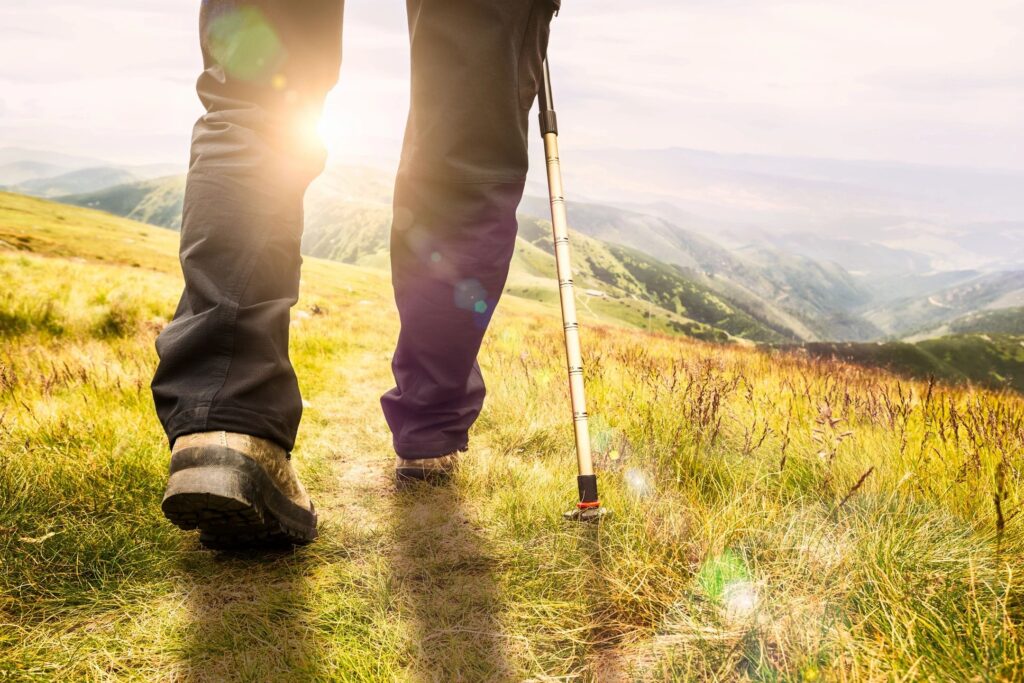
Footwear and Accessories
– Breathable Hiking Shoes: Choose shoes with good ventilation to keep your feet cool. Consider wearing moisture-wicking socks to prevent blisters. Mid-cut shoes are always a good option for added ankle support even if you’re not hiking up a mountain.
– Trekking Poles: These can provide extra stability and reduce strain on your knees during longer hikes (especially on your way down!).
– Insect Repellent: Protect yourself from mosquitoes and other insects, especially when hiking near water. While it seems that the world is divided into people that do not attract mosquitos, the other half seems to attract them all. If that is you, insect repellent is your friend.
Staying Safe in the Heat
– Early Morning or Late Afternoon Hikes: Avoid the midday sun by hiking during cooler parts of the day. Consider hiking in cooler, less exposed places, e.g. forests, canyons – or higher mountains.
– Rest and Shade: Take frequent breaks in shaded areas to avoid overheating.
– Know the Signs of Heat Exhaustion: Learn to recognize symptoms such as dizziness, nausea, and excessive sweating. If you experience these, rest in a cool place and hydrate immediately.
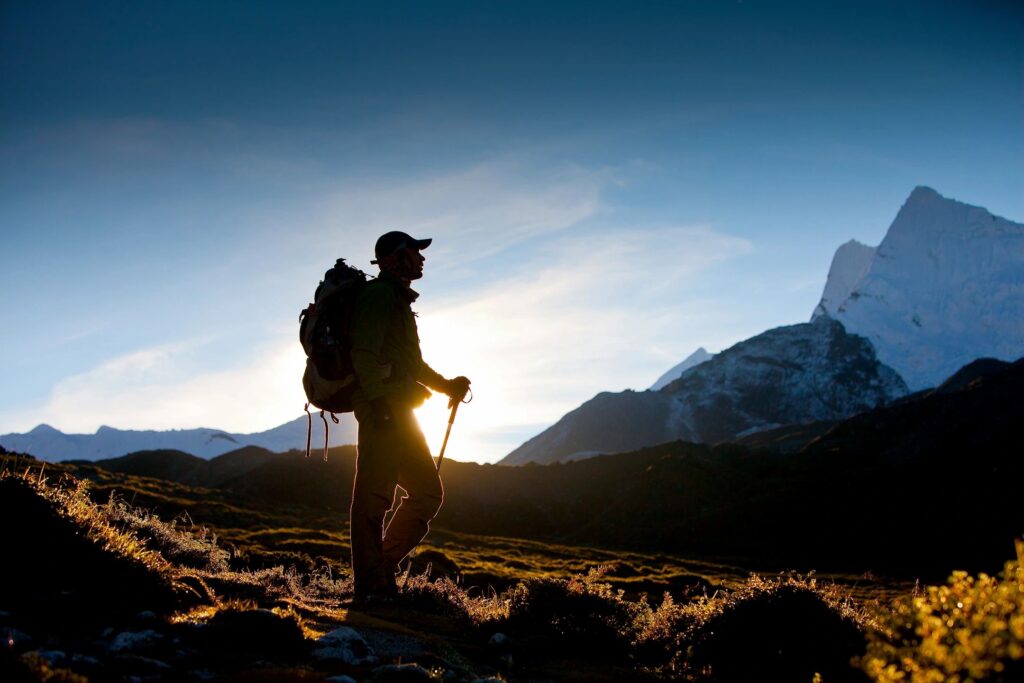
Proper preparation and the right gear are essential for enjoying summer hikes in Rome. By following these tips, you can stay safe and comfortable while exploring the beautiful landscapes Rome (and all of Italy, really) has to offer.
Click here for a free summer hike checklist.
As always: Stay fit, hike a bit!
Sal
Read more about:

Hiking In The Abruzzo, Lazio and Molise National Park: A Fall Adventure For Expats
Guest Article written by Sal from Nature of Sal October is a wonderful time for expats to explore the Abruzzo, Lazio and Molise National Park (“Parco nazionale d’Abruzzo, Lazio e Molise”, also known as PNALM), located east of Rome. The park, one of three National Parks in Abruzzo, is renowned for its stunning autumn colors, […]

The Best Places to Visit in Italy by Train This Fall
Italy is one of Europe’s most captivating destinations all year round, but fall brings a unique charm that enhances its picturesque landscapes, historic cities, and culinary delights. With cooler temperatures, fewer tourists, and a golden hue that blankets the countryside, autumn is the perfect season to explore the country by train. Thanks to Italy’s extensive […]

Understanding Salaries in Italy: A Guide for Expats and Newcomers
If you’re an expat living in Italy or someone considering relocating, understanding the salary landscape is key to planning your life in the country. This article provides an overview of average salaries in Italy in 2024, how they vary by profession, age, gender, education, and region, as well as how they compare to other European […]

Preparing For Cooler Weather: Fall Hiking Tips For Expats
Guest Article written by Sal from Nature of Sal As summer fades into fall, the cooler weather provides a refreshing change for hikers in Rome. For expats, it’s important to adjust your hiking gear and preparation to enjoy the trails comfortably and safely. Dressing for Fall Hikes – Layering: Start with a moisture-wicking base layer, […]
Learn about the residence permit for digital nomads from non-EU countries working in Italy
Italy’s Investor Visa: A Visa to Attract Strategic Investments from Abroad
Find and Buy Your Ideal Property in Italy with Our Professional Services
Buying Property in Italy – How to Get a Mortgage as a Foreigner
How to Open a Bank Account in Italy as an Expat
Learn Italian and open up new possibilities for your career and personal growth
Prepare for the CILS B1 Citizenship exam to obtain citizenship by marriage, residence or study or work in Italy.
Switching to a self-employment permit from a study or job-seeking one
FAQs for Italian Citizenship by Marriage (2023)
Understanding the Tessera Sanitaria: Your Italian Health Insurance Card
Non-Married Partners: How to Obtain a Residence Permit in Italy as De Facto Cohabitants
How to get tax identification number for foreign citizens (Codice Fiscale)
How to register in Italy as an EU citizen
Mastering Public Transport in Italy
The Advantages of Dual Citizenship with an Italian Passport: Unlocking Boundless Opportunities
What you need to know about Visas and Permits to stay in Italy
Red flags to identify a scam when renting in Italy
Explore Italy’s most well-known antique markets. Italy offers abundant opportunities to discover unique and valuable treasures.
Antiques Markets
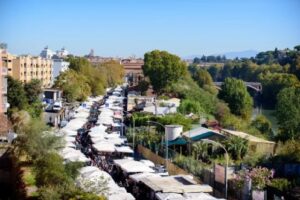
Mercato di Porta Portese (Rome) is the most famous and largest market in Rome. Located in the picturesque Trastevere district, it has become a Sunday ritual for locals and an essential stop for tourists visiting the capital. The market area extends between Piazza Ippolito Nievo at the top, Via Ettore Rolli on the left, and Via Portuense on the right. Its name comes from the seventeenth-century Porta Portese, built to replace the ancient Porta Portuensis. The market has a rich history, dating back to around 1945, continuing the tradition of the black market that previously took place in the Campo de’ Fiori area.
At Porta Portese, you’ll find an authentic mix of colors, voices, and cultures—a glimpse into the Rome of yesteryears. Over 1,000 stalls offer a wide variety of items, making it a paradise for shopping enthusiasts and vintage lovers. Here’s what you can discover:
– Antiques and Collectibles: Explore antiquities and modern artifacts, including paintings, books, jewelry, watches, and furniture.
– Vinyl Records and CDs: Music enthusiasts can browse through a selection of vinyl records and CDs.
– Electronics and Accessories: From gadgets to household items, there’s something for everyone.
– Clothes, Bags, and Shoes: Discover a variety of fashion items, from vintage clothing to contemporary styles, along with a range of bags and shoes.
– Unusual Objects: You might stumble upon quirky and unique items.
Porta Portese is open every Sunday from 7:00 AM to 2:00 PM.
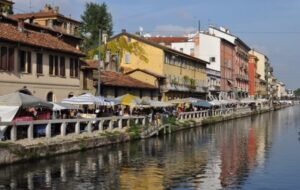
The Mercatone dell’Antiquariato in Milan stretches along the first section of the Naviglio Grande, which is the oldest canal in Milan. Specifically, it runs from Viale Gorizia to the Ponte di Via Valenza, covering an impressive route of nearly two kilometers.
The Mercatone dell’Antiquariato is a specialized market primarily focused on antiques. More than 380 exhibitors participate each month, showcasing a wide range of items. You’ll find carefully selected and meticulously curated stalls featuring furniture, watches, porcelain, silverware, jewelry, dolls, games, collectibles, books, eyewear, radios, modern artifacts, canes, bronzes, glassware, comics, and prints.
The market takes place on the last Sunday of every month, except for December when it falls on the second Sunday of the month.
Photo from feelflorence.it
The Mercato delle Pulci (Flea Market) in Florence is a delightful place for antique enthusiasts and collectors. The market recently moved to its new permanent location at Piazza Annigoni. Previously, it was situated in Piazza dei Ciompi.
At the Mercato delle Pulci, you’ll find a variety of items, including:
– Small Antiques: Unique antiques dating back to the early 1900s.
– Vintage Selection: Curated vintage pieces.
– Modern/Antiques: A blend of modern and antique items.
– Second-Hand Books: Stalls with used books.
– Vinyl Records: If you’re a music lover, explore the collection of vinyl records.
The market is open from Monday to Sunday, operating between 09:00 and 19:30. It is closed on December 25th, 26th, and January 1st.
Photo from visitarezzo.com
The Mercato Antiquario di Arezzo (Arezzo Antiques Fair) is a captivating event that has been attracting exhibitors, visitors, and collectors for over 50 years. The heart of the fair lies in the characteristic Piazza Grande in Arezzo. From there, it radiates to other city squares, offering a diverse array of art, furniture, jewelry, accessories, books, scientific and musical instruments, coins, prints, and hundreds of thousands of heterogeneous objects. These items vary in terms of date, origin, and value, catering to various types of collectors.
The fair takes place every first Sunday of the month, along with the preceding Saturday.
Operating hours are from 9:00 AM to 7:00 PM on Saturday and 9:00 AM to 6:00 PM on Sunday.
Photo from dovealucca.it
The Fiera Antiquaria di Lucca is a vibrant and bustling antique market that draws visitors from all over Italy. Although officially established in 1970, the market’s roots trace back to the Medieval period. During that time, nobles sought out rare and authentic pieces to display in their homes. Today, the Fiera Antiquaria has evolved into an informal and popular event, where the atmosphere is filled with the excitement of discovering hidden gems.
It features approximately 220 exhibitors who set up their stalls throughout the historic center of Lucca. These stalls can be found in various locations, including Via del Battistero, Piazza Antelminelli, Piazza San Martino, Piazza San Giusto, Piazza San Giovanni, Corte Bertolini, Via del Duomo, and Piazza Bernardini. Visitors can explore a wide range of fascinating items, from jewelry and collectibles to furniture, vintage toys, and tools.
The market takes place on every third Sunday of the month and the preceding Saturday, from 8:00 AM to 7:00 PM.
Whether you’re an avid collector or simply appreciate the charm of bygone eras, Italy’s antiques markets promise an unforgettable experience filled with historical treasures and unique finds. What other antique markets would you add to this list?
Read more about:

Hiking In The Abruzzo, Lazio and Molise National Park: A Fall Adventure For Expats
Guest Article written by Sal from Nature of Sal October is a wonderful time for expats to explore the Abruzzo, Lazio and Molise National Park (“Parco nazionale d’Abruzzo, Lazio e Molise”, also known as PNALM), located east of Rome. The park, one of three National Parks in Abruzzo, is renowned for its stunning autumn colors, […]

The Best Places to Visit in Italy by Train This Fall
Italy is one of Europe’s most captivating destinations all year round, but fall brings a unique charm that enhances its picturesque landscapes, historic cities, and culinary delights. With cooler temperatures, fewer tourists, and a golden hue that blankets the countryside, autumn is the perfect season to explore the country by train. Thanks to Italy’s extensive […]

Understanding Salaries in Italy: A Guide for Expats and Newcomers
If you’re an expat living in Italy or someone considering relocating, understanding the salary landscape is key to planning your life in the country. This article provides an overview of average salaries in Italy in 2024, how they vary by profession, age, gender, education, and region, as well as how they compare to other European […]

Preparing For Cooler Weather: Fall Hiking Tips For Expats
Guest Article written by Sal from Nature of Sal As summer fades into fall, the cooler weather provides a refreshing change for hikers in Rome. For expats, it’s important to adjust your hiking gear and preparation to enjoy the trails comfortably and safely. Dressing for Fall Hikes – Layering: Start with a moisture-wicking base layer, […]
Learn about the residence permit for digital nomads from non-EU countries working in Italy
Italy’s Investor Visa: A Visa to Attract Strategic Investments from Abroad
Find and Buy Your Ideal Property in Italy with Our Professional Services
Buying Property in Italy – How to Get a Mortgage as a Foreigner
How to Open a Bank Account in Italy as an Expat
Learn Italian and open up new possibilities for your career and personal growth
Prepare for the CILS B1 Citizenship exam to obtain citizenship by marriage, residence or study or work in Italy.
Switching to a self-employment permit from a study or job-seeking one
FAQs for Italian Citizenship by Marriage (2023)
Understanding the Tessera Sanitaria: Your Italian Health Insurance Card
Non-Married Partners: How to Obtain a Residence Permit in Italy as De Facto Cohabitants
How to get tax identification number for foreign citizens (Codice Fiscale)
How to register in Italy as an EU citizen
Mastering Public Transport in Italy
The Advantages of Dual Citizenship with an Italian Passport: Unlocking Boundless Opportunities
What you need to know about Visas and Permits to stay in Italy
Red flags to identify a scam when renting in Italy
Closure Schedule
The Metro A line continues its transformation, so new interventions and closures are planned. Stay updated on the closure schedule:
From April 8 to December 5, early closures on the entire A line for the completion of track renewal work between Ottaviano and Battistini:
◦ From Sunday to Thursday, the last runs are at 9:00 PM
◦ On Fridays and Saturdays, service runs regularly until 1:30 AM 76 replacement buses will be active during the evening closures.
Extraordinary closure in August.
From Termini to Battistini from August 10 to 25.
Station Closures
∙ From July 15 to October 3, the Spagna station will be closed for renovation and restyling works.
∙ From July 22 to September 9, the Ottaviano station will be closed for renovation and restyling works.
∙ From August 19 to November 6, the Furio Camillo station will be closed for renovation and restyling works.
Check out Shuttle Details here.
Read more:
A Guide to Living in Italy with a Dog
Dog Friendly places in and near Rome
12 Captivating Small Towns in Italy
20 Places to Explore in Milan – A Local’s Guide
A Weekend Guide to Naples’ Culinary and Cultural Highlights
20 Places to Explore in Milan – A Local’s Guide
The Colossal Statue of Constantine: FREE Exhibition at the Capitoline Museums
15 Must-Visit Museums, Galleries, and Cultural Sites in Italy
Don’t Miss the Chance to Visit the Vatican Museums for Free
A Guide to Visiting the Vatican Museums
Italy’s Most Enchanting Towns Accessible by Train
New Celio Archaeological Park in Rome – Free Admission
Learn about the residence permit for digital nomads from non-EU countries working in Italy
Italy’s Investor Visa: A Visa to Attract Strategic Investments from Abroad
Find and Buy Your Ideal Property in Italy with Our Professional Services
Buying Property in Italy – How to Get a Mortgage as a Foreigner
How to Open a Bank Account in Italy as an Expat
Learn Italian and open up new possibilities for your career and personal growth
Prepare for the CILS B1 Citizenship exam to obtain citizenship by marriage, residence or study or work in Italy.
Switching to a self-employment permit from a study or job-seeking one
FAQs for Italian Citizenship by Marriage (2023)
Understanding the Tessera Sanitaria: Your Italian Health Insurance Card
Non-Married Partners: How to Obtain a Residence Permit in Italy as De Facto Cohabitants
How to get tax identification number for foreign citizens (Codice Fiscale)
How to register in Italy as an EU citizen
Mastering Public Transport in Italy
The Advantages of Dual Citizenship with an Italian Passport: Unlocking Boundless Opportunities
What you need to know about Visas and Permits to stay in Italy
Red flags to identify a scam when renting in Italy
Guest Article written by Sal from Nature of Sal
As spring flourishes in Rome, Villa Ada Park becomes a prime destination for family-friendly hikes. This expansive park, located in the northern part of the city, offers a serene escape for expats and their families looking to enjoy nature.
Exploring Villa Ada Park
Villa Ada is one of the largest parks in Rome, featuring a variety of trails suitable for all ages and fitness levels. The park is known for its beautiful lakes, dense woodlands (with a really nice oak forest), and historical buildings, providing a diverse urban hiking experience.
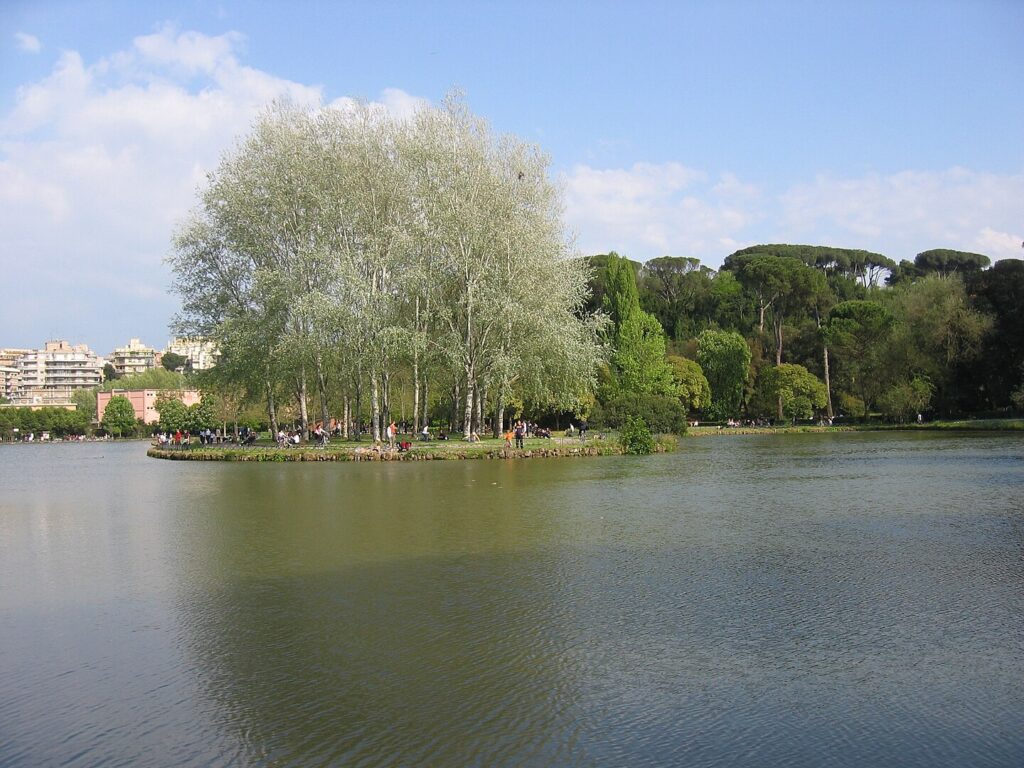
Trail Highlights
– Lake Trail: This easy trail circles around the picturesque lake, perfect for a leisurely family stroll. Keep an eye out for ducks and turtles basking in the sun!
– Woodland Paths: For a more immersive experience, venture into the wooded areas where you can enjoy the shade and listen to the sounds of nature.
Family Hiking Tips
– Bring a Picnic: Villa Ada has plenty of scenic spots for a family picnic. Pack a blanket, some snacks, and enjoy a meal surrounded by nature.
– Wildlife Spotting: Kids will love spotting the park’s wildlife, from colorful birds to curious squirrels.
– Bicycle Rentals: For a fun twist, rent bicycles and explore the park on two wheels.
Seasonal Blooms
In May, Villa Ada is in full bloom, with vibrant flowers and lush foliage creating a picturesque setting. It’s an ideal time for families to capture beautiful photos and make lasting memories.
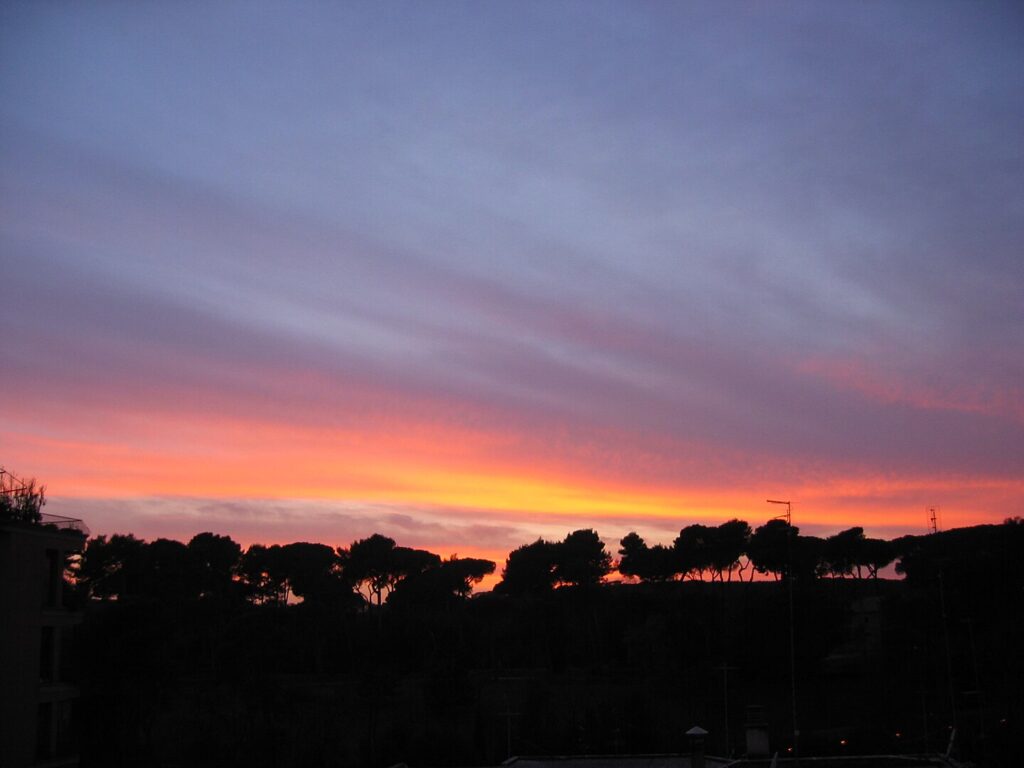
Villa Ada Park offers families a perfect springtime retreat with its accessible trails, scenic beauty, and abundant wildlife. Whether you’re hiking, picnicking, or cycling, Villa Ada provides a refreshing outdoor adventure for all ages.
Where can I find more family-friendly hikes by public transport?
With an abundance of family-friendly hiking options accessible by train, Rome invites you to embark on an unforgettable adventure with your loved ones. So pack your bags, hop on board the train, and let’s explore the stunning landscapes and natural wonders of Rome together!
Ready to start planning your family hiking adventure? Visit Nature of Sal’s FREE HikeLine Map for more information and inspiration. Let’s make memories that will last a lifetime!
And as always: Stay fit, hike a bit!
Sal
Read more about:

Hiking In The Abruzzo, Lazio and Molise National Park: A Fall Adventure For Expats
Guest Article written by Sal from Nature of Sal October is a wonderful time for expats to explore the Abruzzo, Lazio and Molise National Park (“Parco nazionale d’Abruzzo, Lazio e Molise”, also known as PNALM), located east of Rome. The park, one of three National Parks in Abruzzo, is renowned for its stunning autumn colors, […]

The Best Places to Visit in Italy by Train This Fall
Italy is one of Europe’s most captivating destinations all year round, but fall brings a unique charm that enhances its picturesque landscapes, historic cities, and culinary delights. With cooler temperatures, fewer tourists, and a golden hue that blankets the countryside, autumn is the perfect season to explore the country by train. Thanks to Italy’s extensive […]

Understanding Salaries in Italy: A Guide for Expats and Newcomers
If you’re an expat living in Italy or someone considering relocating, understanding the salary landscape is key to planning your life in the country. This article provides an overview of average salaries in Italy in 2024, how they vary by profession, age, gender, education, and region, as well as how they compare to other European […]

Preparing For Cooler Weather: Fall Hiking Tips For Expats
Guest Article written by Sal from Nature of Sal As summer fades into fall, the cooler weather provides a refreshing change for hikers in Rome. For expats, it’s important to adjust your hiking gear and preparation to enjoy the trails comfortably and safely. Dressing for Fall Hikes – Layering: Start with a moisture-wicking base layer, […]
Learn about the residence permit for digital nomads from non-EU countries working in Italy
Italy’s Investor Visa: A Visa to Attract Strategic Investments from Abroad
Find and Buy Your Ideal Property in Italy with Our Professional Services
Buying Property in Italy – How to Get a Mortgage as a Foreigner
How to Open a Bank Account in Italy as an Expat
Learn Italian and open up new possibilities for your career and personal growth
Prepare for the CILS B1 Citizenship exam to obtain citizenship by marriage, residence or study or work in Italy.
Switching to a self-employment permit from a study or job-seeking one
FAQs for Italian Citizenship by Marriage (2023)
Understanding the Tessera Sanitaria: Your Italian Health Insurance Card
Non-Married Partners: How to Obtain a Residence Permit in Italy as De Facto Cohabitants
How to get tax identification number for foreign citizens (Codice Fiscale)
How to register in Italy as an EU citizen
Mastering Public Transport in Italy
The Advantages of Dual Citizenship with an Italian Passport: Unlocking Boundless Opportunities
What you need to know about Visas and Permits to stay in Italy
Red flags to identify a scam when renting in Italy





